Show HN Today: Discover the Latest Innovative Projects from the Developer Community
 ShowHN Today
ShowHN TodayShow HN Today: Top Developer Projects Showcase for 2025-07-18
SagaSu777 2025-07-19
Explore the hottest developer projects on Show HN for 2025-07-18. Dive into innovative tech, AI applications, and exciting new inventions!
Summary of Today’s Content
Trend Insights
Today's projects highlight a strong push towards AI-powered tools, especially in data analysis and automation. Developers are leveraging AI to enhance user experiences, from generating presentation content to providing insightful data analysis. Moreover, we're seeing a shift towards cloud-based tools and development environments, streamlining workflows and improving accessibility. The prevalence of projects built with Python, and open-source spirit shows the community's commitment to innovation. For developers and entrepreneurs, this means focusing on building AI-driven features, embracing cloud technologies for scalability, and creating tools that are user-friendly and address real-world problems. The rise of tools like RunAgent shows an exciting potential for cross-language capabilities in AI application, a must-follow trend for all developers.
Today's Hottest Product
Name
Molab, a cloud-hosted Marimo notebook workspace
Highlight
This project showcases a novel approach to cloud-hosted notebooks using Marimo, a reactive Python notebook. The innovation lies in its modern tech stack including uv for fast package installation, R2 for persistent storage, and Modal for fast startups. This setup allows for features like persistent storage, link sharing, and real-time collaboration, making it a valuable tool for data scientists and developers. The key takeaway is the use of modern technologies to create a cloud-native notebook environment.
Popular Category
AI 工具
开发工具
数据分析
Popular Keyword
AI
Python
Web
Technology Trends
AI辅助的数据分析和工具开发
基于云的开发环境和工具
利用现代技术栈构建创新应用
Project Category Distribution
AI 工具 (25%)
开发工具 (35%)
数据分析 (10%)
Web 应用 (20%)
其他 (10%)
Today's Hot Product List
| Ranking | Product Name | Likes | Comments |
|---|---|---|---|
| 1 | Librari.io: Your Digital Bookshelf for the Modern Reader | 77 | 50 |
| 2 | Molab: Cloud-Hosted Marimo Notebooks | 103 | 13 |
| 3 | Mark: The Unified Notation for Data | 8 | 10 |
| 4 | WebCodecs-Powered Media Renderer | 8 | 6 |
| 5 | RateMyPrompt: AI Prompt Sharing and Evaluation Platform | 9 | 4 |
| 6 | Brainfork: Instant Personal RAG MCP Server | 11 | 1 |
| 7 | MockFedCM: A Sandbox for Federated Credential Management | 11 | 0 |
| 8 | RapidChart: Reimagining Diagramming for Modern Developers | 5 | 3 |
| 9 | Child Affordability Index - A Data-Driven Exploration | 4 | 3 |
| 10 | Fluent-state: Declarative React State Management with a Fluent API | 5 | 1 |
1
Librari.io: Your Digital Bookshelf for the Modern Reader

Author
hmkoyan
Description
Librari.io is a personal library management app designed for book lovers who want more than basic organization. It tackles the problem of managing physical books, offering features like multiple library support, location tracking, and loan management. The innovation lies in its focus on user-friendliness and the flexibility to handle personal collections, unlike rigid, institution-focused apps. It allows users to customize how they track their books, adding custom fields and tags to fit their individual needs.
Popularity
Points 77
Comments 50
What is this product?
Librari.io is a web application that helps you catalog and manage your physical book collection. Instead of using spreadsheets or overly complex library systems, this app provides a simple and intuitive way to track where your books are located, who you've lent them to, and your reading progress. It uses a modern user interface, making it actually enjoyable to use. So, what's the innovation? It's designed specifically for personal use, recognizing that individual book collections need more flexibility than what typical library software offers.
How to use it?
As a user, you can access Librari.io through your web browser. First, you'd create a library to represent your collection. You'll then add your books, inputting information like title, author, and any custom details you want. You can also track the location of your books (like the shelf they're on), manage loans to friends, and monitor your reading progress. It’s easily integrated into your daily life by simply adding books as you acquire them and updating their status as you read or lend them out.
Product Core Function
· Multiple Library Support: The app allows you to create and manage several different libraries (e.g., one for your home, one for your office). This helps organize books across different locations. This is useful if you have books spread out. So this is helpful for when you are looking for a book at a certain location.
· Location Tracking: You can specify the exact location of each book, down to the shelf or room. This helps find your books easily. This is incredibly useful when you have a lot of books and can't remember where each one is located, which can save you time.
· Loan Management: The app tracks books lent out to friends, including who borrowed them and when they are due back. This prevents you from losing track of your books. This feature helps avoid forgetting which books you've lent and to whom, which can be a common problem when sharing books.
· Custom Fields and Tags: You can add your own notes and tags to your books. This gives you the flexibility to track any extra information relevant to your books. This feature enables a personalized approach to tracking your books, catering to unique information.
· Reading Progress Tracking: You can record your reading progress, including dates, duration, and personal ratings. This is useful to track which books you have read, how long it took you and what you thought of them. This allows you to revisit your reading history.
Product Usage Case
· Book Collectors: Perfect for serious book collectors who need to catalog hundreds or thousands of books and keep track of their locations, loans, and personal notes. Imagine never losing a book again or easily finding the one you want to read. This avoids the chaos that often accompanies large book collections.
· Readers who lend to friends: Ideal for people who regularly lend books and want to keep track of who has which book and when it's due back. This solves the problem of lost or forgotten books. This offers a digital record of your loans, simplifying the management of your lending activities and preventing disputes.
· Organized Readers: Useful for anyone who wants to keep their personal book collection organized and wants to maintain a digital record of their reading history. You can better understand your reading habits and remember what you've read, even years later. This feature creates a personal reading journal, preserving your experiences with books.
2
Molab: Cloud-Hosted Marimo Notebooks

Author
akshayka
Description
Molab is a cloud-based service for running and sharing Marimo notebooks, a modern, reactive Python notebook environment. This service tackles the need for accessible and collaborative Python notebooks, providing persistent storage, easy sharing, and fast package installations. It is built on a modern tech stack leveraging tools like uv for fast dependency management, R2 for persistent storage, and Modal for compute resources. The core innovation lies in offering a seamless cloud experience for Marimo notebooks, addressing user demand for a cloud-based version of Marimo, and providing a more efficient and collaborative environment for data workflows.
Popularity
Points 103
Comments 13
What is this product?
Molab is a cloud platform specifically designed to host and run Marimo notebooks. Marimo is a special kind of interactive notebook, built for data science workflows. Molab takes the notebook concept and puts it in the cloud, letting you save, share, and even collaborate on your notebooks. It uses tools like 'uv' for quick software package installations and 'R2' for storing your notebooks safely. It also makes it easy to get more computing power when you need it. This allows data scientists and developers to work on their projects without worrying about setting up complex environments or losing their work.
How to use it?
Developers can access Molab through a web interface to create, edit, and run Marimo notebooks. You can upload notebooks from your computer using a command-line tool (coming soon). Notebooks are easily shared with others via links, similar to how you share a private GitHub gist. You can download your notebooks to use them as Python scripts or apps. Eventually, Molab will support real-time collaboration and the ability to customize computing resources like CPU and GPU power. This makes it perfect for anyone using Marimo notebooks for data analysis, machine learning, or any Python-based project.
Product Core Function
· Persistent storage: Molab saves your notebooks securely in the cloud, so you never lose your work. This is super useful if you work on projects and need to come back to them later, or share with others.
· Link sharing: Molab allows you to share your notebooks with others using secret links. This makes collaboration on your projects straightforward and safe.
· Download notebooks: You can download your notebooks as Python scripts or apps. This allows you to take your work and use it in different environments or integrate it into larger projects.
· Fast package installation: Molab uses 'uv' to install software packages for your projects really quickly. This means less waiting and more time for you to work on the actual coding.
· Configurable compute resources (coming soon): Molab will allow you to request more processing power as needed. This is really helpful for handling complex data tasks or running computationally intensive projects.
Product Usage Case
· Data analysis and reporting: A data scientist can use Molab to create interactive data visualizations and reports, sharing them easily with colleagues who can then explore and modify the analysis. So you don’t have to send around giant files, just the link.
· Machine learning experiments: Researchers can build and test machine learning models in Marimo notebooks within Molab, saving their work and easily sharing it with collaborators for model evaluation. No need to set up a complicated local environment, just start coding!
· Educational purposes: Educators can create interactive tutorials and demonstrations using Marimo notebooks in Molab, letting students experiment and learn Python coding online. The student has the code and the result, all in one spot.
· Rapid prototyping of applications: Developers can prototype and iterate on Python-based applications by creating notebooks in Molab and then converting them into standalone applications later. This allows for faster development cycles.
3
Mark: The Unified Notation for Data
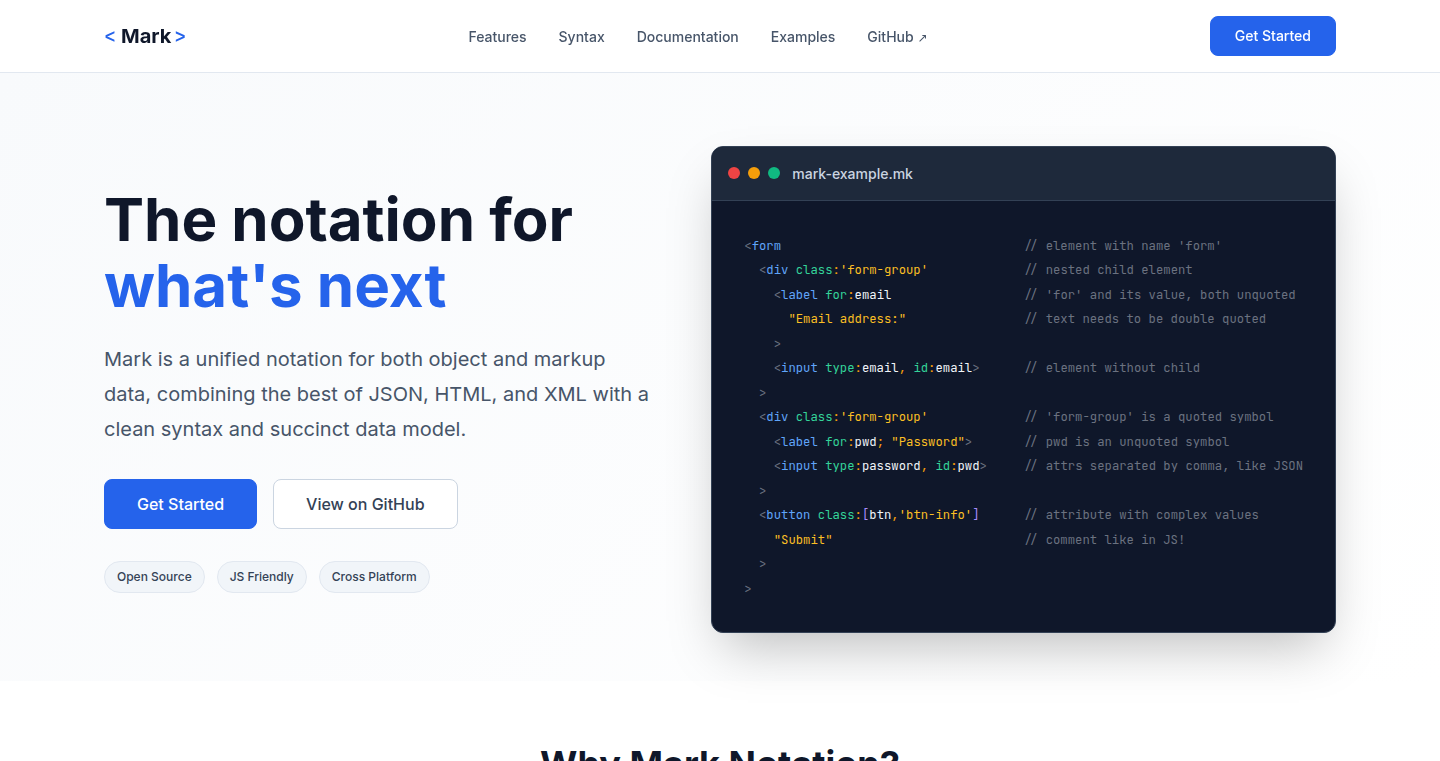
Author
henryluo
Description
Mark is a new way to represent data that aims to simplify how we store and exchange information online. It cleverly combines the strengths of various existing formats like JSON, HTML, and XML, while shedding their complexities. Think of it as a universal language for data, making it easier for different systems and applications to understand each other. This 1.0 release marks the beginning of its journey to make the web a more efficient platform for data handling. So, this is useful because it reduces the friction of data exchange, saving you time and effort when working with different systems.
Popularity
Points 8
Comments 10
What is this product?
Mark is a unified data notation. It's like a super-charged version of JSON, HTML, JSX, XML, and YAML all rolled into one. Instead of learning multiple formats, you learn Mark. It uses a clean syntax and a simplified data model, allowing you to represent both structured data (like in JSON) and markup data (like in HTML) seamlessly. The innovation lies in its ability to be a single format for multiple purposes, simplifying data storage and exchange. So, this allows you to manage different data types with a single syntax, making your development work much easier.
How to use it?
Developers can use Mark in any situation where data needs to be stored, transmitted, or processed. Think of web applications, APIs, databases, and configuration files. You can write your data in Mark, and then use tools to convert it to other formats, or process it directly. This means if you're building a website that gets data from multiple APIs, you might use Mark as the common language to make it easy to integrate these data sources. So, it offers developers a simpler and more versatile tool to handle different data formats in various applications.
Product Core Function
· Unified Syntax: Mark provides a single syntax to represent various data formats, such as JSON, HTML, XML. This streamlines the data representation process and reduces the need to learn multiple formats. So, this reduces the cognitive load and allows you to focus on your application logic.
· Data Serialization/Deserialization: With Mark, developers can serialize and deserialize data. This allows converting data into a format suitable for storage or transmission and converting it back into a usable form. So, this allows you to easily move data between systems and applications.
· Data Interchange: Mark simplifies the data interchange between different systems and applications, fostering better interoperability. So, this means your applications can communicate more easily and efficiently with each other.
· Simplified Data Modeling: Mark provides a succinct data model, making it easier to represent complex data structures with cleaner syntax. So, this improves code readability and maintainability.
Product Usage Case
· Web Application Development: In building a web application that uses data from several APIs (some providing JSON, some XML), Mark can act as the common format to simplify data integration. Convert each API’s data to Mark, then process it within your app. So, this speeds up the development cycle by eliminating the need to manage different formats.
· Configuration Files: Mark can be used to create configuration files for your software. Instead of using different file formats (like JSON or YAML) for different projects, you use Mark. So, this reduces the chance of errors and makes configuration management easier.
· Data Storage: If you are creating a database, you can store your data in Mark. This way, regardless of what your data looks like (object, markup, etc.), you have a single unified format for storage. So, this allows you to easily access and process your data regardless of the original data format.
4
WebCodecs-Powered Media Renderer

Author
vanilagy
Description
This project presents a custom web media player built entirely using WebCodecs and without relying on the standard HTML `<video>` or `<audio>` elements. The core innovation lies in directly decoding and rendering media streams (video/audio) using WebCodecs APIs, offering fine-grained control over the rendering process and bypassing the limitations of browser-native media players. It solves the problem of building highly customized media playback experiences, potentially improving performance and providing more flexibility for advanced features. So this allows developers to build very custom players.
Popularity
Points 8
Comments 6
What is this product?
This project is a custom media player. It leverages the WebCodecs API, a set of new APIs in browsers. Instead of using the built-in `<video>` or `<audio>` elements (the standard approach), it directly decodes video and audio data. WebCodecs gives developers more low-level control, letting them process the media data directly. This means they can fine-tune the player's behavior, like how the video is displayed, or integrate special effects. It's like having the raw ingredients instead of a pre-made meal, letting you cook up something unique. So it allows you to customize media playback to your heart's content.
How to use it?
Developers can use this project as a foundation for building highly customized web media players. They can integrate it into their existing web applications by incorporating the JavaScript code. The code provides access to the decoded video frames and audio samples. This allows the developer to then control the rendering and playback process of the media in their own application. For example, it could be used to build a player with custom UI elements, add special effects to video streams, or to adapt the player to different network conditions. The project's value is in the flexibility it offers. So, if you want a unique player, you can start from here.
Product Core Function
· WebCodecs Decoding: The core function is using WebCodecs API to decode video and audio streams. This allows for extremely low-level access to the decoded media data. It is the foundation that enables all other features. It allows for precise control over how media is processed, giving developers the flexibility to implement unique features, and it potentially improves performance. This is useful if you want to manipulate the video data.
· Custom Rendering: Since the project doesn't rely on the native HTML video element, it provides flexibility over how media is displayed on the screen. The developers can write their own rendering logic. This is useful to create custom user interfaces, special effects, and to integrate with other web technologies. So, this lets developers customize how the media looks.
· Media Stream Handling: The project handles incoming media streams (e.g., from network or local files). This involves receiving, parsing, and managing the data necessary for decoding and rendering, including dealing with codecs and container formats. This is useful to build players that can handle various media sources.
Product Usage Case
· Building a video player with custom UI: Developers can create a fully customized user interface for their media player. By controlling the video frames, they have complete control over how the player looks. This lets developers build a truly unique and branded media experience. This solves the need to have a UI that matches the design of an application.
· Implementing video effects and filters: With access to individual video frames, developers can apply a range of effects and filters in real time. This could include color correction, blurring, or other image manipulations. This is helpful for creating interactive experiences, or for adding advanced features to the video. So, this can be used to add Instagram-like video effects to a player.
· Adaptive streaming with custom logic: The project's flexibility allows developers to implement custom adaptive streaming solutions. It allows you to customize how your application deals with network conditions, providing a better viewing experience. This means the video quality changes dynamically based on the viewer's connection. This allows you to customize how your application deals with network conditions, providing a better viewing experience.
5
RateMyPrompt: AI Prompt Sharing and Evaluation Platform

Author
jshchnz
Description
This project, RateMyPrompt, is a platform for sharing and rating AI prompts, essentially the instructions you give to AI models to get specific results. It's innovative because it not only allows users to share their prompts but also automatically evaluates them using multiple AI models (like Claude 3 and GPT-4 Mini). This helps users understand how well a prompt performs and identify the best ones. The project addresses the common problem of finding reliable and effective AI prompts by providing a community-driven, AI-assisted rating system. It focuses on prompt quality through both AI and human evaluation, categorizing prompts into various types and subjects.
Popularity
Points 9
Comments 4
What is this product?
RateMyPrompt is a community-driven platform where users can share and rate prompts for AI models. The core innovation lies in its automated evaluation system. When a prompt is submitted, it's automatically tested by multiple AI models. The results from these AI tests are combined with ratings from human users to generate an overall score for each prompt. This process uses different types of prompts (full prompt, enhancement, template, system, chain), grouped into many categories. So this is a tool that combines the power of AI with community feedback to help you find good prompts quickly, essentially an AI prompt search engine with evaluation integrated.
How to use it?
Developers can use RateMyPrompt to discover effective prompts for their AI projects, helping them save time and improve the quality of their outputs. You might be building a chatbot, writing AI-powered content, or automating tasks. By using the platform, developers can find prompts optimized for tasks like generating code, writing marketing copy, or creating creative content. The platform can be integrated into workflows simply by copying prompts into your desired AI models, or by reviewing the prompt examples. This allows developers to benefit from proven AI prompts without having to spend time creating and testing them from scratch. It's also useful for experimenting: if you already know a good prompt, put it in the system and see what the AI models think of it.
Product Core Function
· Prompt Sharing: Users can submit and share their AI prompts, creating a centralized repository of prompt examples. This helps other users build upon existing knowledge and accelerate their own projects. So this helps by providing a place to share and find useful prompts.
· AI-Powered Evaluation: The platform automatically tests prompts with multiple AI models to assess their performance and effectiveness. This automated evaluation provides a quick assessment of prompt quality. So this means you don't need to manually test, it's done for you.
· Human Rating: Users can rate prompts based on their experience, providing a subjective layer of feedback that complements the AI-driven evaluations. So this provides another way to judge the quality of a prompt.
· Categorization: Prompts are organized into categories, such as coding, writing, and marketing, making it easier for users to find prompts relevant to their needs. So this gives you a quick way to find prompts related to a specific task.
· Prompt Types: Supports different prompt types like 'full prompt', 'enhancement', 'template', 'system', and 'chain', catering to various user requirements and AI model interactions. So this means the prompts provided have the best formats for different AI use cases.
Product Usage Case
· A developer is building a marketing chatbot and uses RateMyPrompt to find and test prompts specifically designed for generating ad copy and engaging with customers. They quickly identify and adapt a few prompts that significantly improve the chatbot's marketing effectiveness, saving hours of research and testing. So you can improve your AI projects using the best prompts.
· A writer working on a blog post uses RateMyPrompt to find prompts that can generate creative writing ideas and optimize content for specific keywords. They utilize the platform to experiment with different prompt formats and categories to increase their writing productivity. So it helps writers quickly explore a variety of prompt formats and content styles.
· An educator wants to use AI to create lesson plans. They use RateMyPrompt to find prompts that can generate relevant educational content and interactive exercises. They adapt the prompts for their specific educational needs, improving the learning experience for students. So this allows educators to automate the creation of effective learning materials.
6
Brainfork: Instant Personal RAG MCP Server

Author
softwareiseasy
Description
Brainfork allows you to create your own Retrieval-Augmented Generation (RAG) Multi-Context Processing (MCP) server effortlessly. It addresses the need for quick and personalized access to information, offering a flexible solution for managing and querying multiple data sources. The core innovation lies in its streamlined setup and ability to handle complex queries across different contexts, providing users with immediate, customized insights. So this allows you to easily build your own smart assistant that knows everything about your personal documents and data.
Popularity
Points 11
Comments 1
What is this product?
Brainfork leverages the power of RAG, which means it combines a large language model (LLM) with a retrieval system. It lets you quickly build a system that can understand your data, even if it's in various formats or locations. Think of it as giving a smart assistant access to your personal library of information, but it also supports multi-context processing, meaning it can understand and answer your questions based on data from multiple, different sources at once. So, you can ask a question and Brainfork will find the answer across all your data.
How to use it?
Developers can use Brainfork by simply pointing it to their data sources (files, websites, databases). Brainfork will then automatically index and process the data. You can then query the data using a simple API. You can then integrate it into applications. For instance, embed it into your company's internal documentation, use it as a smart search for your website, or even as a personal assistant for researching a topic. So this makes it super easy to build a powerful knowledge-based system.
Product Core Function
· Rapid Data Ingestion: Brainfork quickly processes and indexes your data, no matter the format. This means you can have your system up and running quickly. So this saves you a lot of time and effort, so you don't have to manually process your data.
· Multi-Context Querying: Brainfork intelligently understands and answers questions by referencing multiple data sources simultaneously. Imagine you ask a question that requires information from several of your data sources. Brainfork handles the complexities for you, providing accurate and comprehensive answers. So this is useful when your data is scattered.
· Personalized Information Access: Brainfork lets you build your own personalized AI assistant, that understands your data. You can then interact with your data the way you want, allowing you to unlock your personalized knowledge base. So this is useful for accessing relevant information faster and making smarter decisions.
Product Usage Case
· Personal Knowledge Base: Build a personal assistant that understands your notes, emails, and documents. Quickly find information and insights without manually searching. So this allows you to organize your data, and get the information you need in a fraction of a second.
· Enhanced Customer Support: Integrate Brainfork into your customer support system to quickly retrieve answers from your documentation. Provide better and more efficient customer service. So this allows you to provide instant answers.
· Research and Analysis: Use Brainfork to analyze multiple data sources for research. Easily gather insights and make informed decisions by quickly accessing all the information. So this allows you to speed up research, and get insights faster.
7
MockFedCM: A Sandbox for Federated Credential Management
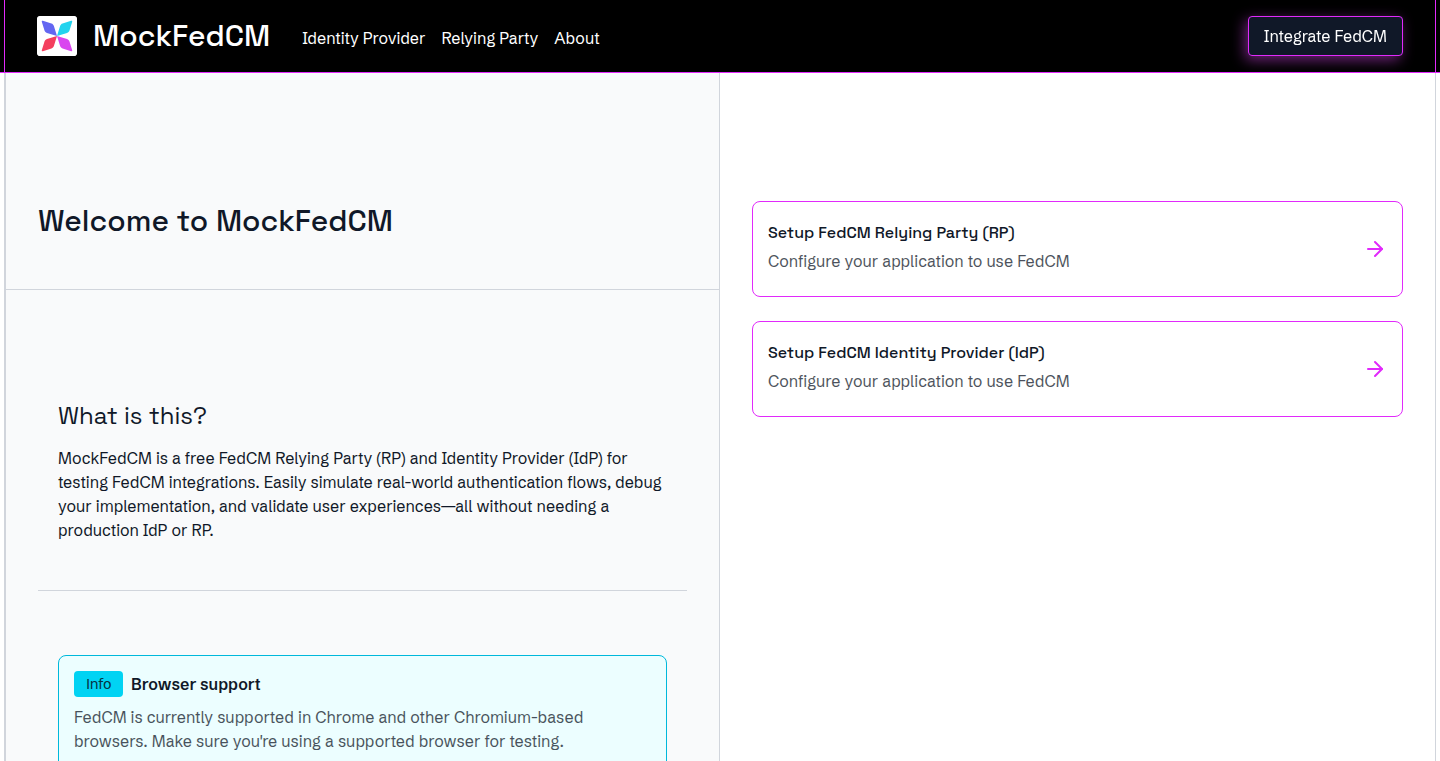
Author
portaouflop
Description
MockFedCM is a tool that lets developers test and experiment with FedCM (Federated Credential Management) without needing a real-world Identity Provider (IdP) or Relying Party (RP). It's like a playground for web authentication, allowing developers to simulate different scenarios and debug their FedCM integrations. The innovation lies in providing a controlled environment for testing, which significantly simplifies and speeds up the development process of FedCM based authentication systems.
Popularity
Points 11
Comments 0
What is this product?
MockFedCM is a mock service that mimics the behavior of both an IdP and an RP for FedCM. FedCM is a web standard that allows users to authenticate to websites using their existing accounts from identity providers (like Google or Facebook) without revealing their personal information. MockFedCM allows developers to test their FedCM integration in a safe and isolated environment. It simulates the interactions between a website (RP) and an identity provider (IdP), allowing developers to see how their implementation works, validate the user experience, and debug potential issues. So it saves developers time and resources by avoiding the need to set up a real-world FedCM system just for testing.
How to use it?
Developers can use MockFedCM by setting up a test environment on their local machine or a development server. They can then configure their website (RP) to interact with MockFedCM as if it were a real IdP. This involves specifying the MockFedCM's endpoint in the website's FedCM configuration. Developers can then simulate different authentication flows and test edge cases. For example, they can simulate user sign-in, account linking, and error handling. It’s especially useful for testing integration with other authentication flows or exploring different privacy settings.
Product Core Function
· Simulated Authentication Flows: It allows developers to simulate the entire authentication process, from user login to authorization. This allows developers to ensure their FedCM implementation works correctly in various scenarios. So it ensures the authentication process is smooth and user-friendly.
· Debugging and Error Handling: MockFedCM provides tools and mechanisms to debug the FedCM integration. It helps to identify and fix errors, such as incorrect configuration or invalid user input. So it helps quickly troubleshoot any issues.
· User Experience Validation: It allows developers to test the user experience of their FedCM integration, including the prompts and messages presented to the user during the authentication process. This ensures that users have a seamless and privacy-respecting authentication experience. So it makes sure users are comfortable with the login flow.
· Privacy-Focused Testing: It facilitates testing the privacy aspects of FedCM, such as how user data is shared between the RP and IdP. So it allows developers to ensure compliance with privacy regulations.
Product Usage Case
· Testing a new FedCM integration: Developers can use MockFedCM to integrate FedCM into a new web application, testing various scenarios like user login, account linking, and different user roles. This helps ensure the integration works flawlessly before the real-world deployment. So it helps to confidently implement and deploy new FedCM functionality.
· Debugging existing FedCM deployments: For existing websites using FedCM, developers can use MockFedCM to simulate different scenarios to reproduce and debug issues related to the authentication process. This helps quickly identify and resolve problems without affecting real users. So it assists in quickly resolving issues in live systems.
· Experimenting with different IdP configurations: Developers can use MockFedCM to simulate different IdP configurations, such as different levels of user data sharing. This allows them to experiment with different privacy settings and user experiences. So it can help improve the user privacy experience and customize the authentication flow.
· Automated Testing: Developers can integrate MockFedCM into their automated testing suite to ensure that FedCM integration is always working as expected, even after code changes. So this allows for more reliable builds.
8
RapidChart: Reimagining Diagramming for Modern Developers
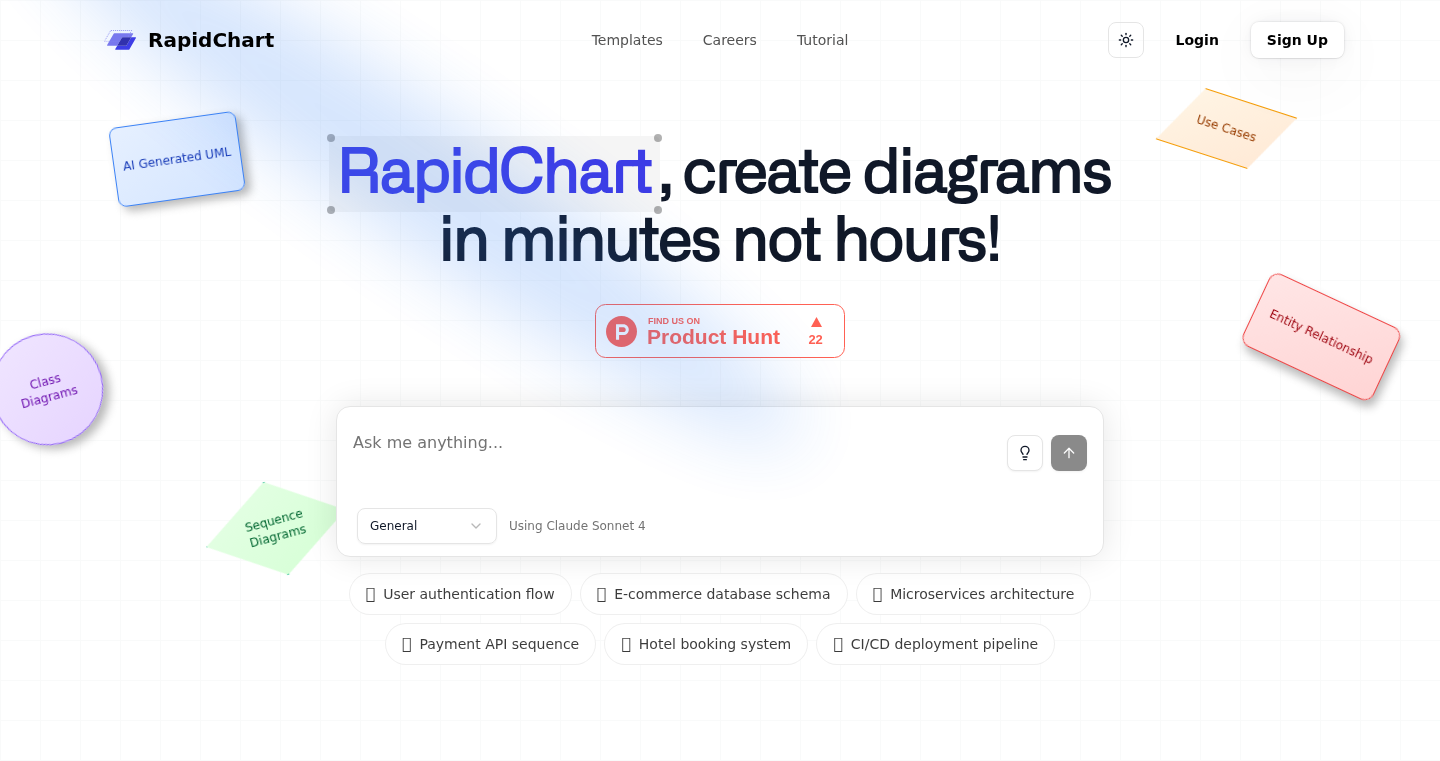
Author
SamiCostox
Description
RapidChart is a tool that aims to revitalize the outdated practice of creating UML diagrams by offering a fast, flexible, and developer-friendly experience. It addresses the common issues of traditional diagramming tools, which are often slow, difficult to modify, and become quickly outdated. The core innovation lies in its cursor-style interface, allowing for rapid diagram creation, complete customizability and exportability, and integration with AI to assist with diagram generation. So, this makes creating and maintaining diagrams much easier and faster, and better integrated into the development workflow.
Popularity
Points 5
Comments 3
What is this product?
RapidChart is a diagramming tool. Traditionally, developers use tools to draw diagrams that visualize their software systems, but these tools are often slow and cumbersome. RapidChart simplifies this process. It introduces a cursor-style interface, similar to how you might draw in a regular text editor, but for diagrams. It also lets you customize everything, so you can make the diagrams look exactly how you want. Plus, it incorporates AI, using tools like GPT-4, to help you build the diagrams more quickly. So, this means you can create and update diagrams much faster, making them a more integral part of your development process.
How to use it?
Developers can use RapidChart to create and manage diagrams representing their software architecture, data flows, and system designs. You would use it by going to the RapidChart website and starting to draw your diagrams using the cursor-style interface. It's designed to be intuitive, so you can quickly create diagrams. You can then use the AI assistance to generate diagrams from text descriptions or specifications. This saves time and effort. Diagrams can be exported in a variety of formats for easy sharing and integration into documentation. So, you can quickly create up-to-date diagrams that reflect your software and integrate them into your documentation to keep your team informed.
Product Core Function
· Cursor-style interface: Allows for rapid creation of diagrams. This differs from traditional tools by enabling you to sketch diagrams more naturally and quickly, similar to writing code, and reduces the time it takes to build and update diagrams. So, it makes diagram creation feel less like a chore and more like a natural extension of your coding.
· Customizability and Exportability: Provides full control over the visual style and format of the diagrams, and supports exporting in various formats. This feature ensures the diagrams fit your specific needs and can be seamlessly integrated into any documentation or presentation. So, it gives you the flexibility to tailor diagrams to your project requirements and share them easily.
· AI-assisted diagramming: Integrates with AI models (like GPT-4 and Claude) to generate diagrams from text descriptions or to automate diagram updates. This capability significantly speeds up the diagram creation process and helps ensure accuracy. So, this will help you generate diagrams based on your code or requirements, making documentation much simpler.
Product Usage Case
· Software Architecture Documentation: Use RapidChart to create diagrams that visualize the components of a complex software system and their interactions. For example, a developer can generate a diagram representing microservices, API calls, and database connections. So, you have a clear understanding of your architecture and can easily share it with your team.
· Data Flow Visualization: Create diagrams to illustrate how data moves through a system. For instance, during an e-commerce site implementation, a developer uses RapidChart to depict the flow of data from the user's request to the final order processing, showing different data systems interactions. So, this gives you a clear view of your data processing systems.
· Technical Documentation: Integrate RapidChart diagrams into technical documentation to explain complex concepts visually. For example, using a diagram to illustrate a complex API interaction in a developer guide. So, you will improve the clarity of your documentation.
9
Child Affordability Index - A Data-Driven Exploration
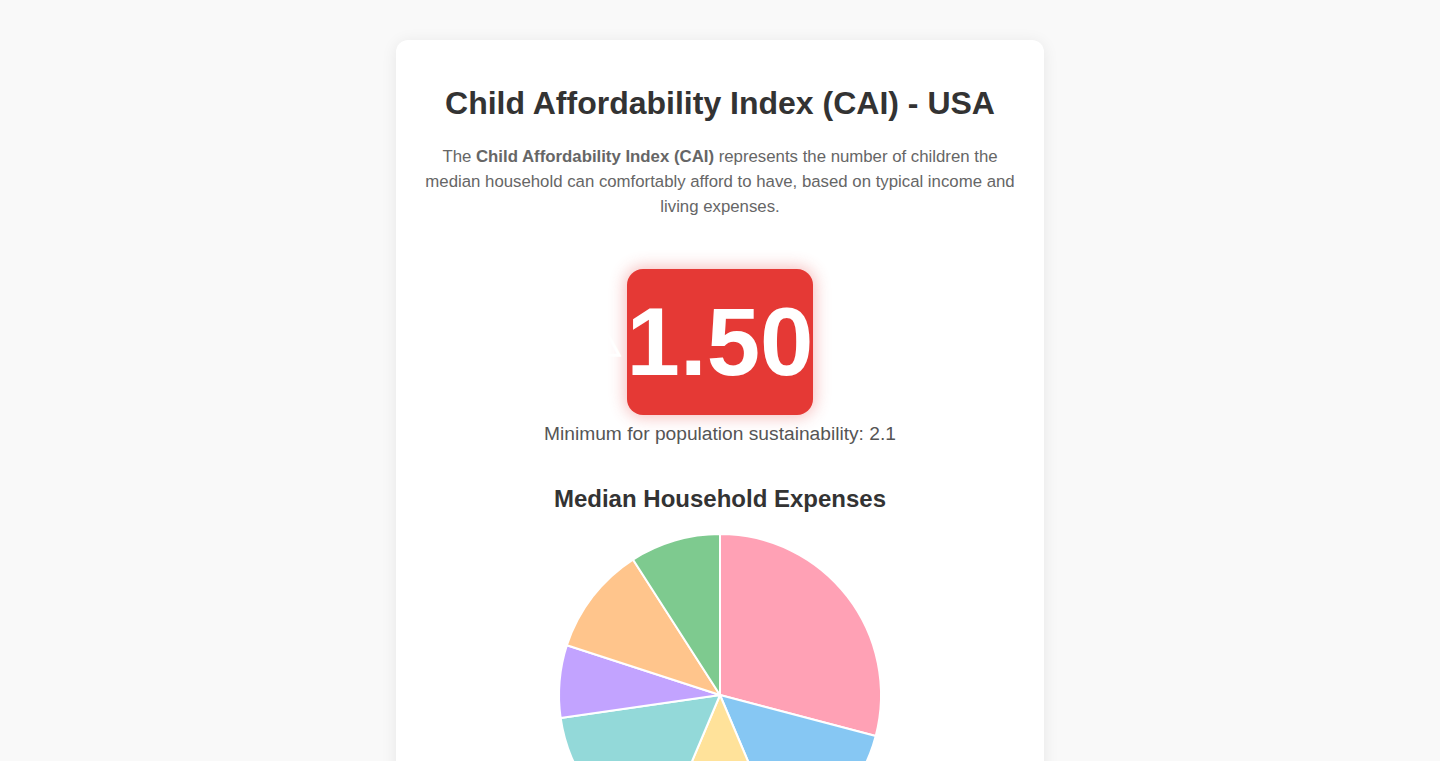
Author
simplekindofman
Description
This project presents a 'Child Affordability Index,' aiming to quantify the financial burden of raising children in different geographic locations. It leverages publicly available data, such as housing costs, childcare expenses, and income levels, to generate an index that reflects the relative affordability. The technical innovation lies in its data aggregation and analysis pipeline, offering a practical tool for understanding and comparing child-related financial realities.
Popularity
Points 4
Comments 3
What is this product?
This project is essentially a data-driven calculator that tells you how affordable it is to raise a child in different places. It's not just a simple comparison of costs, it dives into the details by collecting and analyzing a bunch of public data. Think of it as a smart way to see where your money goes when you have kids, and how that changes depending on where you live. It uses a data analysis pipeline to process the information and present it in a user-friendly format. So it provides a practical way to understand how child-related expenses vary across different locations.
How to use it?
Developers can use this as a starting point for various applications. They could integrate the index into their own financial planning tools, create interactive maps displaying affordability, or build dashboards for urban planners to analyze child-related costs in different neighborhoods. You could also incorporate it into websites that help families relocate. Essentially, it's a dataset and analysis framework ready to be integrated into other projects or further refined. It could be integrated through APIs or data downloads, depending on the specific implementation.
Product Core Function
· Data Aggregation and Cleaning: It collects data from various public sources (e.g., housing costs, childcare expenses, income levels). The value is that it automates the process of finding and cleaning the data, which is often the most time-consuming part of any data project. This saves developers time and effort. Application: Used to create a reliable dataset for affordability analysis.
· Index Calculation Algorithm: This is the core of the project, where the data is processed and the affordability index is calculated. The value is the creation of a consistent and comparable metric. Application: Allows for direct comparison of affordability across different regions.
· Visualization and Reporting: This project likely includes ways to visualize the index (e.g., through maps or charts). The value is that it provides a clear and easily understandable way to present the data. Application: Facilitates quick understanding of affordability trends and variations across regions.
· Data Source Tracking: Keeping track of where the data comes from, and how often it gets updated. The value here is transparency and ensuring the index stays current. Application: Enables users to understand the source's reliability and monitor data quality.
· Potential for Open-Source Contribution: The very nature of a Show HN project often means it is open-source. This project provides a basis to open-source the code to the community for collaborative development and improvement. Application: Other developers can learn from the approach, contribute enhancements, and even adapt it to other contexts.
Product Usage Case
· Financial Planning Tool Integration: A financial planner could integrate this index into their software to give clients personalized advice about where to live based on child-related expenses. For example, imagine a financial advisor using it to help a young family decide between two cities, considering the cost of living and other financial factors related to raising children.
· Relocation Website Integration: A website that helps people relocate could use the index to help users compare the affordability of different cities and towns. This empowers users with a data-driven perspective, thus helping them make informed decisions about where they want to live.
· Urban Planning Analysis: City planners could use the index to assess the financial burden of raising children in different neighborhoods within their city, potentially identifying areas where support programs might be most needed. This provides a way for planners to evaluate the social and economic impact of urban planning decisions.
10
Fluent-state: Declarative React State Management with a Fluent API
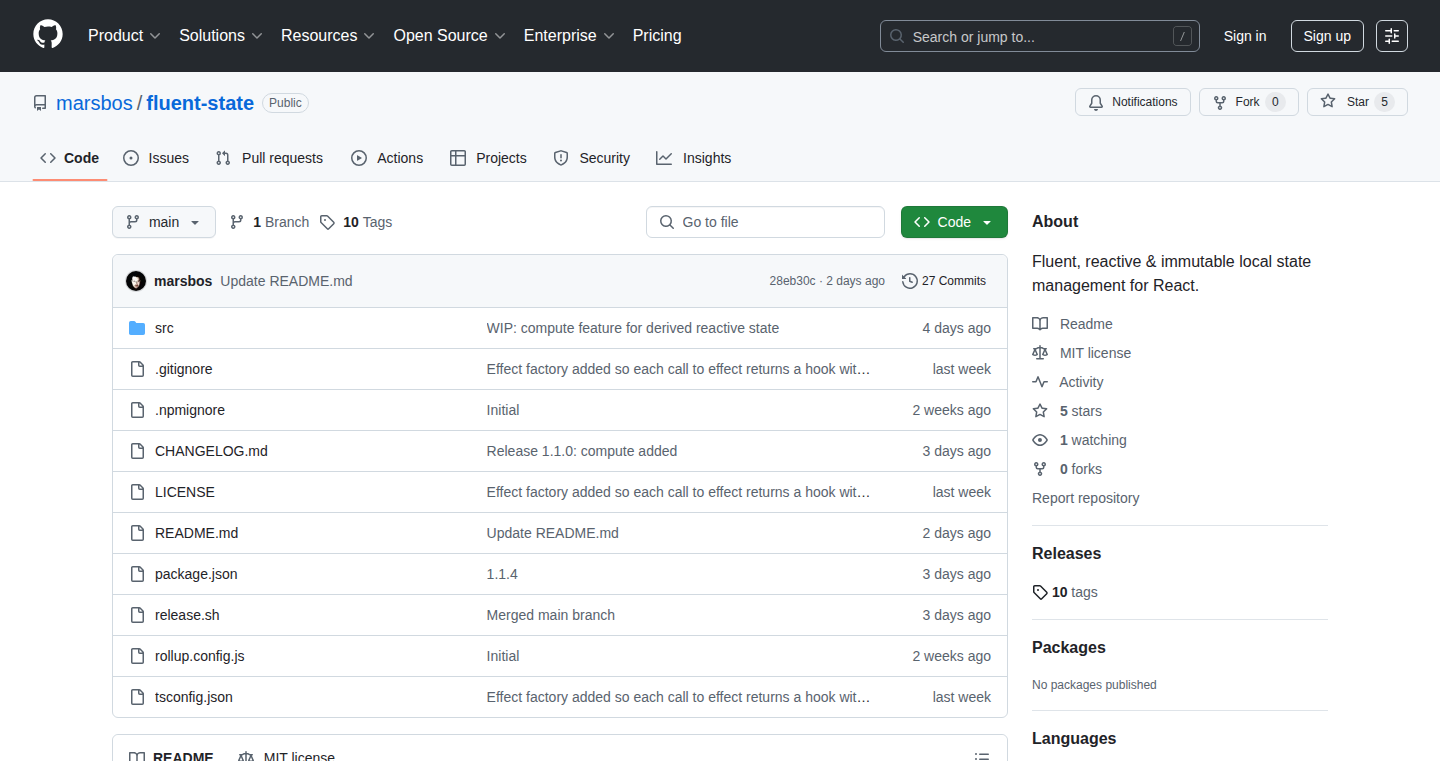
Author
bosmarcel
Description
Fluent-state is a lightweight React hook designed to simplify state management by replacing `useState`, `useReducer`, `useMemo`, and `useEffect`. It offers a fluent, proxy-based API for easy state manipulation, immutable updates without the need for spread syntax, automatic dependency tracking, and built-in functions for reactive derived state and side-effects. It aims to provide a clean and declarative approach to manage local state, particularly for nested structures, reducing boilerplate and giving developers full control. This is a new approach to state management in React, offering improved readability and reduced complexity.
Popularity
Points 5
Comments 1
What is this product?
Fluent-state is a new library that provides a streamlined way to manage the state of your React applications. It simplifies the process by offering a more intuitive and readable API. Instead of using multiple React hooks like `useState`, `useReducer`, `useMemo` and `useEffect`, Fluent-state combines their functionalities into one cohesive package. The core innovation lies in its use of a 'fluent' API, meaning you can chain commands together in a natural way, like `state.user.name('Joe')`. This makes your code easier to understand and less prone to errors. It also handles immutable updates automatically, so you don't have to worry about accidentally modifying state directly. Furthermore, it automatically tracks dependencies, which helps optimize performance by only re-rendering components when necessary. So this helps you write cleaner and less complex React code. This means less time spent debugging state-related issues and more time focusing on building features.
How to use it?
Developers can integrate Fluent-state into their React projects by installing it via npm or yarn. Once installed, they can replace their existing state management code with Fluent-state's hook. The usage is straightforward: create a state object and use its fluent API to read, write, and compute derived state. For instance, if you have a user object, you could update the user's name by calling `state.user.name('New Name')`. You also can define computed values that automatically update when their dependencies change. This library provides developers with a more elegant and efficient way to manage complex state within their React applications. This reduces the amount of boilerplate code and makes state management more intuitive. So you will write more maintainable and easy-to-understand code.
Product Core Function
· Fluent, Proxy-Based API: This allows you to interact with your state in a very readable and intuitive way, similar to how you'd naturally describe data changes. For example, `state.user.name('New Name')` is much clearer than multiple lines using `useState`. This leads to fewer errors and faster development.
· Immutable Updates Without Spread Logic: Fluent-state automatically handles updates to your state objects in an immutable way. This prevents unintended side effects and makes it easier to reason about how your application state changes. It removes the need to manually use spread operators or other techniques for immutability.
· Automatic Dependency Tracking: The library automatically tracks dependencies for computed values and side effects (effects). This optimizes performance by ensuring components only re-render when the data they rely on changes. It avoids unnecessary re-renders, boosting application speed.
· Built-in `compute` for Reactive, Memoized Derived State: You can define computed values that automatically update based on other parts of your state. This avoids writing additional `useMemo` hooks and allows to build complex and interactive user interfaces.
· Built-in `effect` for Reactive Side-Effects: You can define side effects, like making API calls, that automatically run when specific state changes. This means less boilerplate and less complexity when dealing with effects in components and no need to define useEffect.
Product Usage Case
· Managing User Profile Data: In a typical user profile component, Fluent-state simplifies updating user information like name, email, and preferences. Instead of using `useState` for each piece of data, you can manage them as a single `user` object, making the component easier to understand and update.
· Handling Form Input Values: When building forms, Fluent-state streamlines the process of capturing and validating input data. You can easily bind form fields to state properties and automatically update the form data as users type. This makes the code more maintainable.
· Implementing Dynamic UI Components: If you are building UI components that change based on state, Fluent-state enables developers to define derived state values. This simplifies the code that manages these dynamic UI elements. For example, you might have a component that displays a list of filtered items. When the user changes the filter criteria, the filtered list is automatically updated.
· Data Fetching and API Integration: Fluent-state's `effect` functionality simplifies the integration with external APIs. You can trigger API calls based on changes in your state. For instance, when a user clicks a button, you can automatically fetch data from an API and update the UI based on the returned values.
· Real-time Applications: In real-time applications, like chat apps or collaborative tools, state changes need to propagate quickly and efficiently. Fluent-state's dependency tracking and reactive capabilities ensures that components are updated in real time. This creates a responsive and engaging user experience.
11
Toy LLM Daydreamer: A Simple Exploration of LLM Concept Connections
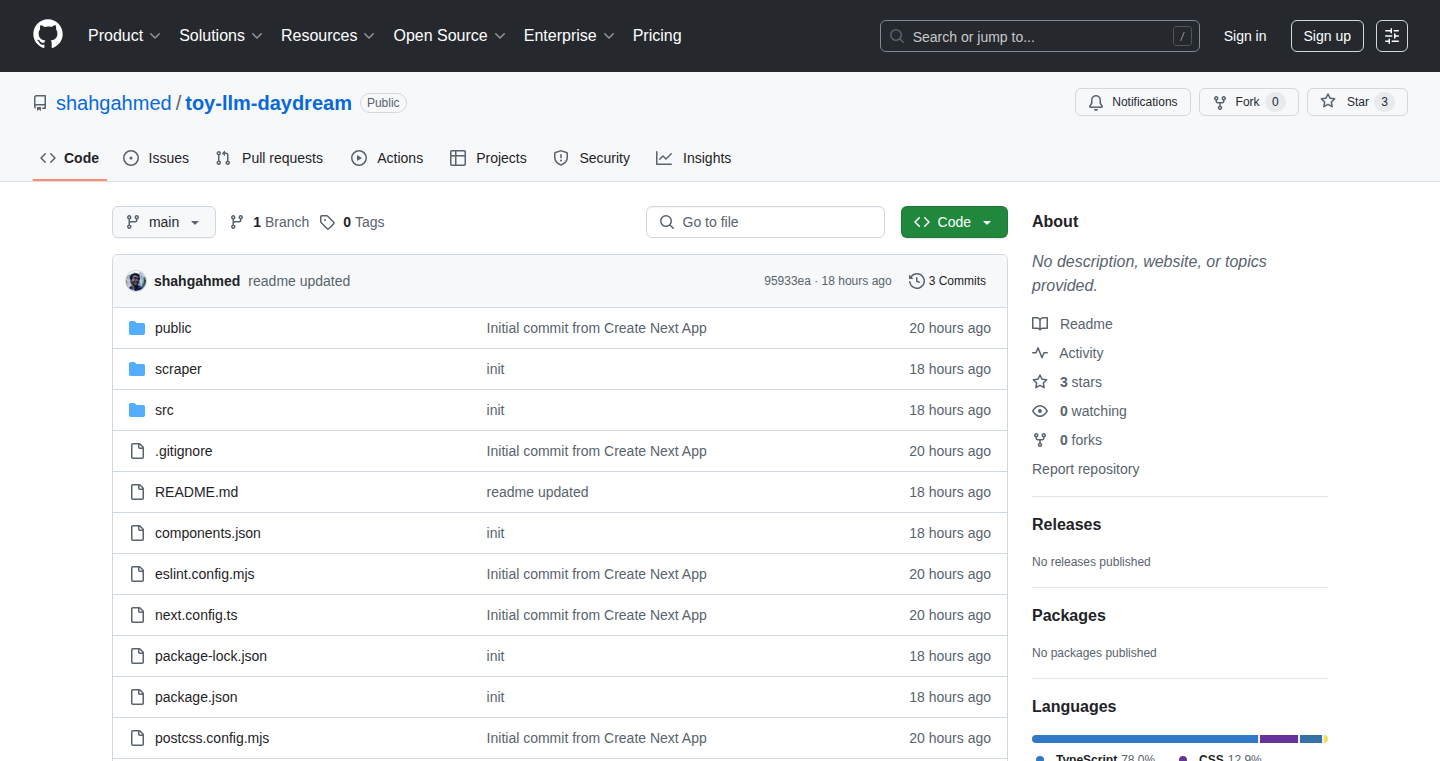
Author
shahahmed
Description
This project is a straightforward Next.js application that explores the 'daydreaming' capabilities of Large Language Models (LLMs). It uses a loop to repeatedly prompt an LLM with Wikipedia article titles, observing how the model connects different concepts. The core innovation lies in its simplicity: it provides a quick and easy way to visualize the associative thinking of LLMs. It leverages existing LLMs to explore the relationships between different concepts, offering insights into how LLMs process and connect information. So this shows the ability of LLMs to make connections between topics, which could be really useful for research or creative brainstorming.
Popularity
Points 6
Comments 0
What is this product?
This project is essentially a playground for experimenting with how LLMs connect ideas. It takes Wikipedia article titles and feeds them into an LLM in a continuous loop. The LLM then generates text based on these titles, creating an output that reveals its understanding of the relationships between these topics. It's innovative because it simplifies the process of observing LLM behavior. So, you can better understand how a language model thinks and connects ideas. It is an open-source project for a good starting point.
How to use it?
Developers can use this project as a starting point for more complex experiments with LLMs. They can modify the prompts, change the input data (e.g., different article titles, their own data), and integrate the app into their own projects to explore the connections made by the LLM and study their behavior. It gives developers the ability to create their own experiments. So, if you're working with LLMs, you can use this to test new ideas or gain insights into how they work.
Product Core Function
· Automated Prompting Loop: The project automatically feeds Wikipedia article titles into an LLM in a continuous loop. This enables a quick and sustained exploration of LLM responses without manual intervention. This feature provides a way to generate a lot of creative content quickly.
· Concept Association Visualization: The app allows to observe how an LLM links disparate concepts from different Wikipedia pages together, in real time. This offers a peek into the internal workings of the LLM. So, if you want to see how different concepts are connected, you can use it to find unexpected relationships between ideas.
· Simple Next.js Application: Built using Next.js, the project is easy to deploy, modify, and experiment with. It provides a simple interface for users. This provides an easy, ready-to-go solution for working with and experimenting with LLMs.
Product Usage Case
· Research Brainstorming: Researchers can feed scientific papers or historical events into the tool to generate new ideas and discover relationships between concepts. For instance, inputting titles from different fields can help visualize potential crossovers and new research areas. So, if you are researching, this tool will help you discover relationships between concepts.
· Creative Writing: Writers can use the LLM to generate creative text, using article titles as inspiration. The tool can generate plot ideas, character interactions, or thematic explorations. So, if you are a writer, this allows you to easily find creative inspiration.
· Educational tool: Educators can use the app to showcase how an LLM processes information and connects ideas. By inputting titles related to a particular subject, educators can highlight the relationships that the LLM draws, making it a good way for students to learn.
12
BrowserBash: Interactive Command Line Tutorial
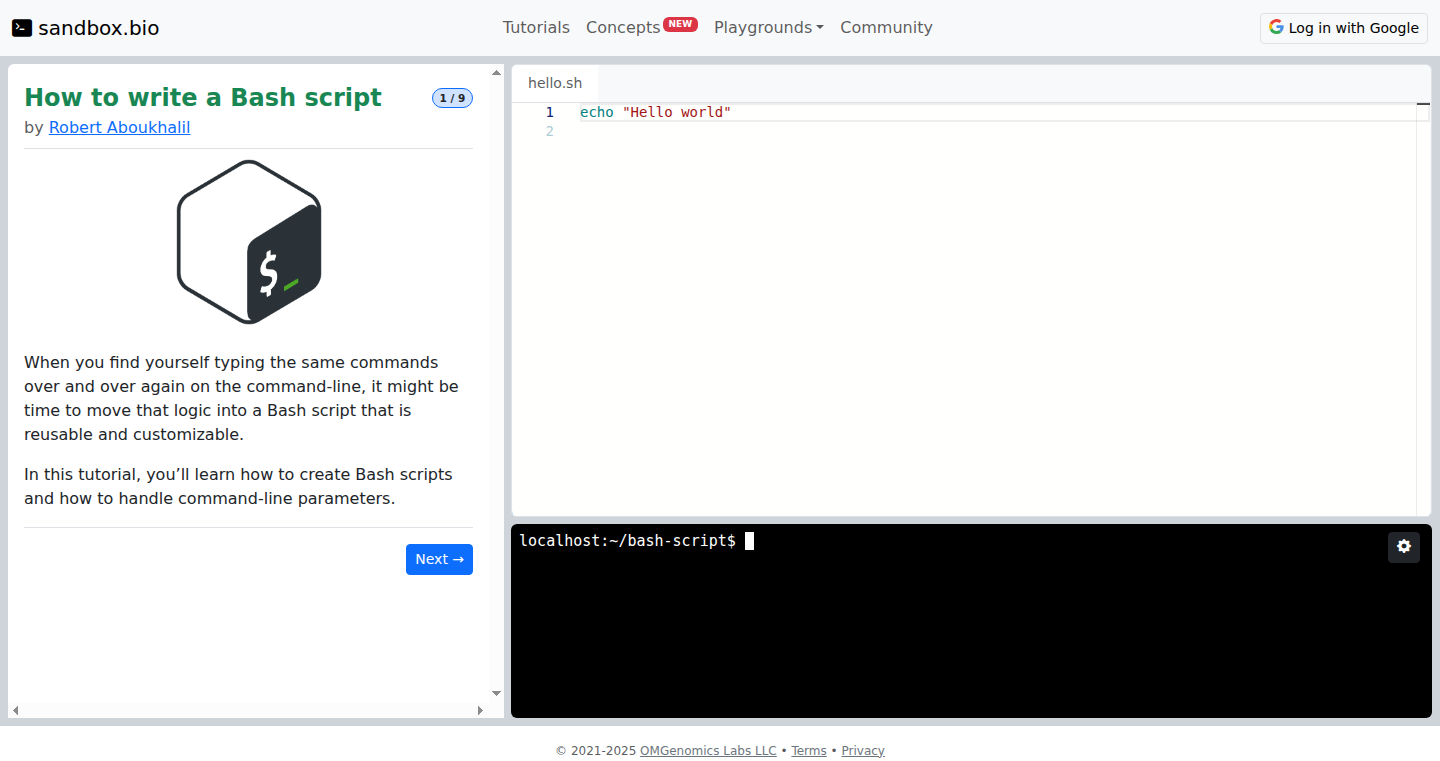
Author
raboukhalil
Description
BrowserBash is an innovative project that allows you to learn and practice Bash scripting directly in your web browser. It leverages v86, an x86 virtualization emulator, to run a full command-line interface (CLI) environment entirely within the browser. The code editor is powered by Monaco, providing a rich and familiar coding experience. This project solves the problem of needing a dedicated terminal environment to learn Bash, making it accessible and convenient for anyone with a web browser. It removes the initial setup hurdles, allowing users to dive straight into the learning process. So this allows for a quick and easy way to learn bash without needing to install anything.
Popularity
Points 6
Comments 0
What is this product?
BrowserBash is a web-based interactive tutorial that runs Bash scripts in your browser. It uses v86, a powerful emulator, to simulate a complete Linux environment inside your browser. Think of it as a mini-computer within your web page. When you type commands, they're executed in this simulated environment. The code editor is built using Monaco, the same technology used in Visual Studio Code, providing features like syntax highlighting and auto-completion. So, it's like having a fully functional terminal right in your web browser.
How to use it?
Developers can use BrowserBash to quickly learn and test Bash scripts without needing to set up a local Linux environment or install any software. You can simply open the tutorial in your browser, start typing and running commands, and see the results immediately. This is great for experimenting with scripts, debugging, and understanding how Bash commands work. You can also integrate BrowserBash into educational content or documentation, providing interactive examples and tutorials directly within the learning materials. So this helps you explore different commands and experiment directly with them, enhancing your understanding in a hands-on approach.
Product Core Function
· In-browser Bash execution: The core functionality is the ability to run Bash commands within a web browser, enabled by the v86 emulator. This simplifies the learning process by eliminating the need for local setup. So this is beneficial for those who want a quick and easy way to learn Bash.
· Monaco-based code editor: The integration of the Monaco editor provides a user-friendly coding environment with features like syntax highlighting and auto-completion, making the scripting experience more efficient and enjoyable. So this helps improve your coding experience by offering features like syntax highlighting and auto-completion
· Interactive tutorial format: The project presents a tutorial-based approach, guiding users through Bash scripting concepts with hands-on exercises. This is a practical way to learn and practice, directly enhancing learning through practical application. So this gives you a guided and hands-on learning experience.
· Cross-platform accessibility: BrowserBash runs in any web browser, meaning it can be accessed on any device (desktop, laptop, tablet) with an internet connection. This broadens accessibility, making it a versatile learning tool for everyone. So this means you can access it on any device, enabling easy learning from anywhere.
Product Usage Case
· Interactive documentation for Bash commands: A developer could integrate BrowserBash into documentation for Bash commands, allowing users to execute and experiment with the command directly within the documentation page. This improves understanding and engagement with the command. So this allows for interactive documentation for Bash commands.
· Online coding courses: Educational platforms can use BrowserBash to create interactive Bash scripting courses, providing students with a hands-on learning environment directly within the course materials. This improves engagement and helps students with hands-on practice. So this enables interactive coding courses.
· Rapid prototyping and testing of Bash scripts: Developers can use BrowserBash to quickly prototype and test Bash scripts without needing to set up a local Linux environment, making the development process faster and more convenient. So this allows for rapid prototyping and testing.
13
BorderGuesser: A Geographic Deduction Game Engine

Author
wolfred
Description
BorderGuesser is a web-based game that challenges users to identify countries based solely on their bordering neighbors. It leverages a novel algorithm to analyze and visualize geographical relationships, offering an intuitive and engaging way to learn about global geography. The core innovation lies in its efficient spatial reasoning engine, which quickly processes complex border data to generate clues and evaluate user guesses. This project tackles the problem of making geographical knowledge accessible and fun, promoting a deeper understanding of global connectivity through an interactive experience.
Popularity
Points 3
Comments 2
What is this product?
BorderGuesser is a game that uses a clever algorithm to let you guess countries based on their neighboring countries. Think of it like a puzzle where you're given hints about where a country is located, but you don't see the map. The magic happens in how it understands the relationships between countries. It's like a super-smart map reader that knows all the borders and can use that information to give you clues. This is innovative because it uses this complex information in a fun and engaging way to help people learn and remember geography.
How to use it?
You can use BorderGuesser by simply visiting the website. The game presents you with a list of bordering countries, and you need to guess the target country. This is useful for both students who want to improve their geography knowledge and anyone who enjoys a challenging and educational game. For developers, this engine could be adapted to create geography-related educational apps, map-based games, or even used as a tool for geographical data analysis. You could integrate it into a quiz application to test users' knowledge of world borders. The project is likely using publicly available datasets for the country borders, which makes it a good base to develop more complex, educational geography games and tools.
Product Core Function
· Country Border Analysis: This function processes global border data to identify neighboring countries for each country, serving as the foundation for the game. The value is in creating the basic information required for spatial reasoning, making complex data digestible and creating a key function for all other functions. It helps us quickly generate neighbor data.
· Clue Generation Algorithm: This algorithm generates hints for players based on the target country's neighbors. This function's value lies in providing intelligent and challenging clues, creating an engaging gameplay experience. It ensures the game's interactive element.
· Guess Validation: The system verifies the player's guesses against the correct answer, providing immediate feedback and tracking progress. This functionality is valuable for ensuring game correctness and offering direct learning feedback.
· User Interface: It provides a simple and intuitive user interface to display game information and player interactions. The UI makes the game easy and fun to play.
Product Usage Case
· Educational Geography Games: Developers can utilize the core algorithm to build educational games where players learn about countries and their neighbors. The game engine provides the core puzzle logic, streamlining development. The value here is to create new types of engaging geography learning games.
· Geopolitical Analysis Tool: This project could be the starting point for more complex analysis tools. The base logic for visualizing neighbor relations, which can be adapted for analyzing political alliances, trade routes, or migration patterns. The value is in creating interactive maps to show these relationships in an easy-to-understand way.
· Map-based Quiz Applications: This technology can be easily integrated into existing quiz applications to test users' knowledge of global borders. So you could easily create geography tests and quizzes.
14
Convo SDK: Effortless LangGraph Checkpointing
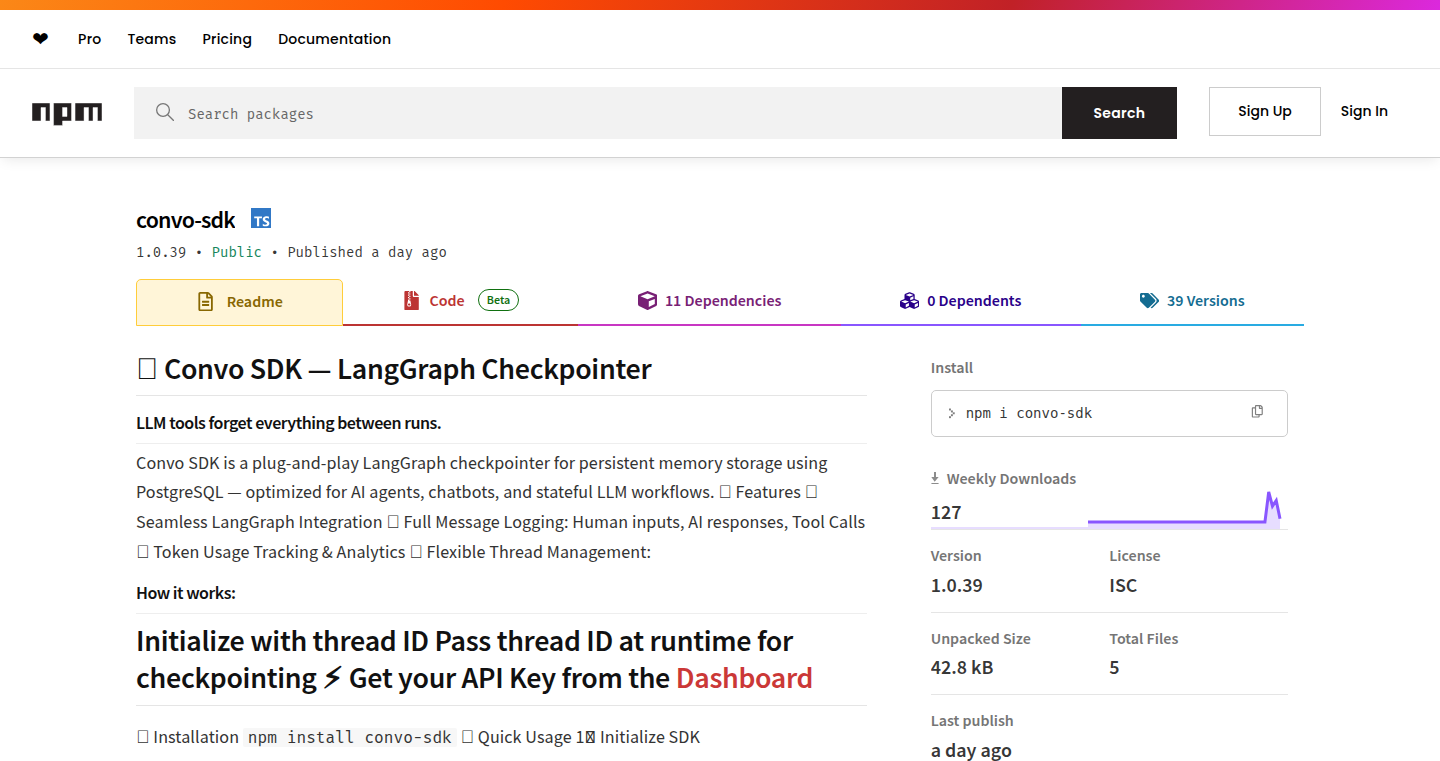
Author
raunaqvaisoha
Description
Convo SDK simplifies LangGraph's checkpointing process, which is essential for building AI agents with memory. The SDK provides a one-line solution to replace complex database setups (like Postgres or MongoDB) that are typically required for storing the state of these agents. It's a cloud-native persistence solution, eliminating the need for database management, handling multi-user applications efficiently, and providing tools for debugging agent behavior. This means developers can focus on building AI applications instead of wrestling with infrastructure.
Popularity
Points 4
Comments 1
What is this product?
Convo SDK is a streamlined solution for managing the memory and state of LangGraph-powered AI agents. Think of LangGraph as a framework for building complex AI workflows, and checkpointing as a way to save the progress of those workflows. Traditionally, setting up checkpointing involves dealing with databases, which can be a pain. Convo SDK solves this by offering a 'drop-in' replacement – a single line of code that handles everything automatically, eliminating the need for database setup and management. It uses cloud-native persistence, allowing the agent to reliably save and restore its state without the usual database hassles.
How to use it?
Developers can use Convo SDK by simply importing the SDK and replacing their existing database-backed checkpointer implementations with the `convo.checkpointer()` function. This provides a ready-to-use solution for handling agent state persistence. Integration is straightforward: you include the SDK in your project, replace the existing checkpointer code with the single-line call, and the SDK handles the rest. This means that instead of spending time setting up and maintaining databases, developers can instantly have access to a solution. For instance, consider building an AI agent that can have long conversations, and Convo SDK enables the agent to remember the context of conversations without needing complicated infrastructure.
Product Core Function
· Simplified Checkpointing: It replaces the complex setup of database-based checkpointing with a single line of code. Value: Makes implementing memory and state management in AI agents incredibly easy. Use Case: Quickly add memory to your AI agent without a steep learning curve.
· Cloud-Native Persistence: Utilizes cloud-based storage, removing the need for managing databases, connection pools, and infrastructure. Value: Reduces operational overhead and infrastructure costs. Use Case: Deploy AI agents without worrying about database scalability or downtime.
· Thread Management: Handles the complexities of managing concurrent users and their agent interactions. Value: Ensures that your AI agents work correctly in multi-user environments. Use Case: Develop chat applications where several users interact with AI agents simultaneously.
· Checkpoint Restoration for Debugging: Allows developers to inspect and restore the state of their agents at any point, crucial for debugging and understanding agent behavior. Value: Provides a powerful debugging tool for understanding and fixing issues in complex AI agent workflows. Use Case: Trace the steps of an agent to understand why it is behaving unexpectedly and fix the underlying problem.
Product Usage Case
· Building Conversational AI: If you're building a chatbot that needs to remember the history of conversations, you can use Convo SDK to store the chat history, essentially preserving the AI agent's memory. Value: Enhance the user experience by allowing more context-aware interactions. Use Case: Developing customer service chatbots with a persistent memory of the user's previous requests.
· Creating AI Agents for complex tasks: When you're building an AI agent that makes decisions over time, it must remember its previous steps and choices. Value: Allows AI agents to learn and adapt to their environment. Use Case: Developing AI that can manage complex workflows that have different states.
· Debugging AI Agent Behavior: You can use Convo SDK to save the complete state of an AI agent at any moment and restore to analyze past behaviours. Value: Simplifies troubleshooting and helps understand the behavior of complex AI agents. Use Case: Debugging the behaviour of an AI agent to understand the issues.
15
Reactylon: Interactive 3D & XR Framework for React
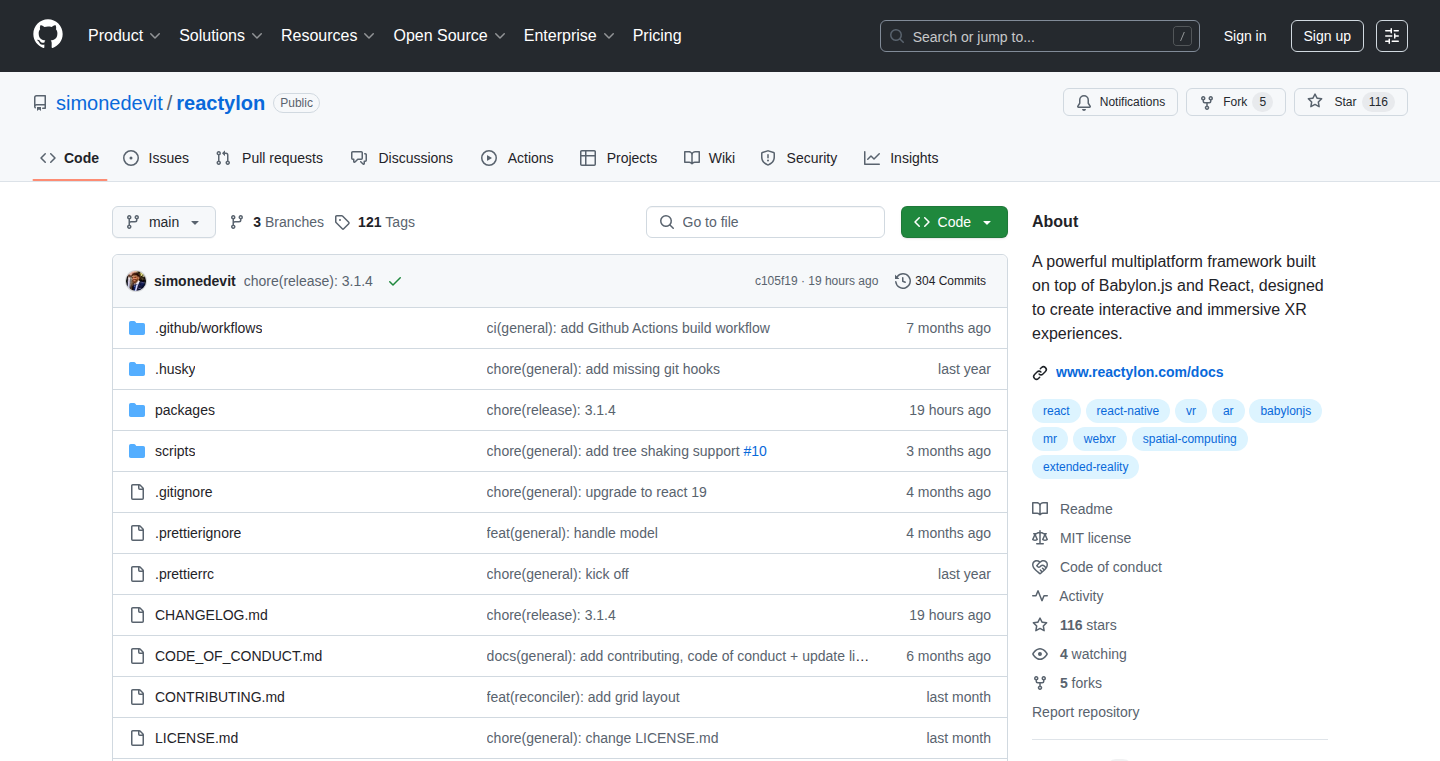
Author
lookingman_
Description
Reactylon is a framework that lets you build 3D and Extended Reality (XR) applications using React. It simplifies the integration of Babylon.js (a powerful 3D engine) into React, allowing developers to leverage the component-based architecture of React to manage complex 3D scenes. This project tackles the problem of creating interactive 3D experiences with a familiar React workflow, making the development process more efficient and accessible.
Popularity
Points 4
Comments 1
What is this product?
Reactylon is essentially a bridge between React and Babylon.js. It provides a set of React components that wrap Babylon.js's functionalities. Instead of writing Babylon.js code directly, you define your 3D scenes using React components. This means you can use React's state management, lifecycle methods, and component composition to build and manage 3D and XR experiences. The innovation lies in bringing the ease of React development to a traditionally complex area like 3D graphics and XR development. So what does that do for you? It allows developers to reuse the React ecosystem's toolset and rapidly build 3D/XR applications.
How to use it?
Developers can integrate Reactylon into their existing React projects. You import the Reactylon components, and then use them to create 3D objects, control the camera, add animations, and handle user interactions. It integrates with your existing React development workflow. For example, you define a 3D model with React components and use React's state to change its properties. Therefore, Reactylon allows developers to reuse the same skills and frameworks as with traditional web development, which cuts down on the development curve.
Product Core Function
· Component-based 3D scene definition: Defining 3D scenes with React components means you can structure your 3D content in a modular way, much like you would with a web application. This greatly improves code organization and maintainability. For instance, if you have a complex 3D scene, you can break it down into reusable components, making it easier to modify and update. So this helps you break down complex 3D scenes into manageable parts.
· State Management for 3D Objects: Using React's state management features to control the properties of 3D objects. You can change the position, rotation, or appearance of objects based on user input or other events. This makes creating interactive 3D experiences easier. For example, use React's context or state management libraries like Redux or Zustand to control your 3D assets. So this is good because you can use the tools you already know to build 3D animations.
· Integration with Babylon.js: Reactylon provides an abstraction layer that makes working with the powerful Babylon.js 3D engine much simpler. You can leverage Babylon.js’s rendering and features, while using the familiar React approach. For instance, use Babylon.js shaders or post-processing effects with the same React components that you use to define the scene. So this makes advanced 3D features much easier to use.
· XR Support: By working with Babylon.js, Reactylon implicitly supports creating VR/AR applications. This means that developers can build immersive XR experiences using their existing React knowledge. For instance, you can create a 3D model that a user can interact with in their VR headset. So that helps you to easily deploy VR and AR applications.
Product Usage Case
· Interactive Product Visualizations: Developers can create interactive 3D models of products that users can rotate, zoom in on, and explore. It will make it easier to showcase product features and details in an engaging way. It works by defining the 3D model with React components and controlling camera movements and interactions with React state. So this helps companies to show off their products.
· VR Training Simulations: Reactylon can be used to build VR training simulations for various industries, such as healthcare or manufacturing. It will allow you to create realistic 3D environments and simulations that users can interact with using VR headsets. It can be achieved by utilizing the Babylon.js 3D engine with React components to render and manage 3D scenes. So this allows you to train people.
· 3D Configurators: Developers can create applications where users can configure 3D models, such as cars or furniture. They can customize colors, materials, and features in real time, and Reactylon can handle all of the 3D rendering and interaction aspects. This can be done by combining React state to control the properties of the model with Babylon.js rendering. So it helps provide a visual way to configure a product.
· Web-Based 3D Games: Reactylon can be used to build browser-based 3D games. It allows developers to create game environments, characters, and interactions using the familiar React framework. For example, you can use React state to track player movements, and use Babylon.js to render and manage the 3D game world. This helps you to create games in the browser.
16
WickedFood - AI-Powered 3D Food Icon Generator

Author
shreyanshkotak
Description
This project uses Artificial Intelligence (AI) to create 3D food icons. It addresses the common problem of needing high-quality, customizable food visuals for various applications. Instead of spending hours designing or purchasing stock images, users can generate unique icons with AI, saving time and resources. The core innovation lies in the AI-driven generation of 3D assets, offering a new level of customization and visual appeal for developers.
Popularity
Points 2
Comments 3
What is this product?
WickedFood is a free tool that uses AI to automatically generate 3D food icons. The AI learns from a vast dataset of food images and generates new, unique icons based on user input. It's like having a virtual artist who specializes in food. The technology behind this is a combination of machine learning and 3D modeling techniques. So what's cool about this? It allows users to easily create high-quality visual assets, allowing them to customize the design. So this is cool because it generates the images, you don't need to go to a designer, and you can easily tweak the look. So this is useful for developers and designers who need food-related visual assets.
How to use it?
Developers can use WickedFood by accessing the free online tool. You provide a text description, and the AI generates a 3D icon based on that description. You can use the icons in various projects such as food ordering apps, restaurant websites, recipe blogs, or even educational materials about food. Integrate this by simply downloading the generated images and using them in your applications.
Product Core Function
· AI-Powered Icon Generation: This is the core feature. The AI interprets your text description (like "pizza slice") and generates a 3D icon. This saves time and resources, removing the need for manual design or costly stock images. So what’s the value? You get unique, customized icons at no cost, tailored to your exact needs. The application? Perfect for quickly visualizing food in your projects.
· Free and Accessible: The tool is free to use. This lowers the barrier to entry for anyone needing food-related visuals, regardless of budget. So what’s the value? It opens up possibilities for smaller projects and individual developers who don't have the budget for professional design services. The application? Everyone can access it, making it good for personal projects, tutorials, and testing ideas.
· 3D Asset Generation: Unlike 2D icons, these 3D images provide a more visually appealing and modern look. They can be used across different platforms and devices. So what’s the value? You get a high-quality visual element to create visually exciting user interfaces. The application? Use these icons to give your apps, games, and websites a more polished and modern look.
Product Usage Case
· Food Ordering App: A developer building a food ordering app needs icons for various food items. Instead of searching for existing icons or paying for custom designs, they use WickedFood to create unique 3D icons, ensuring their app stands out visually. It solves the problem of finding consistent and custom visual assets. It’s perfect for creating engaging interfaces, and improves the user experience. The value? Saves time and money while differentiating the app.
· Recipe Blog: A food blogger can use WickedFood to generate eye-catching 3D icons for recipes. They create custom icons for dishes like "Spicy Noodles" or "Chocolate Cake." The value here? More attractive content, encouraging more clicks, shares, and increased engagement on the blog. Also, it's a way to instantly visualize the food with unique 3D icons, setting the blog apart from others.
· Educational Materials: An educator creating a lesson on healthy eating can use WickedFood to illustrate different types of fruits and vegetables. The value? These icons add visual interest and improve comprehension. Teachers can also use this tool for generating interesting pictures. It aids in creating visually engaging educational content that's more appealing to students and viewers.
17
Text2Cypher: Optimizing LLMs for Graph Query Generation
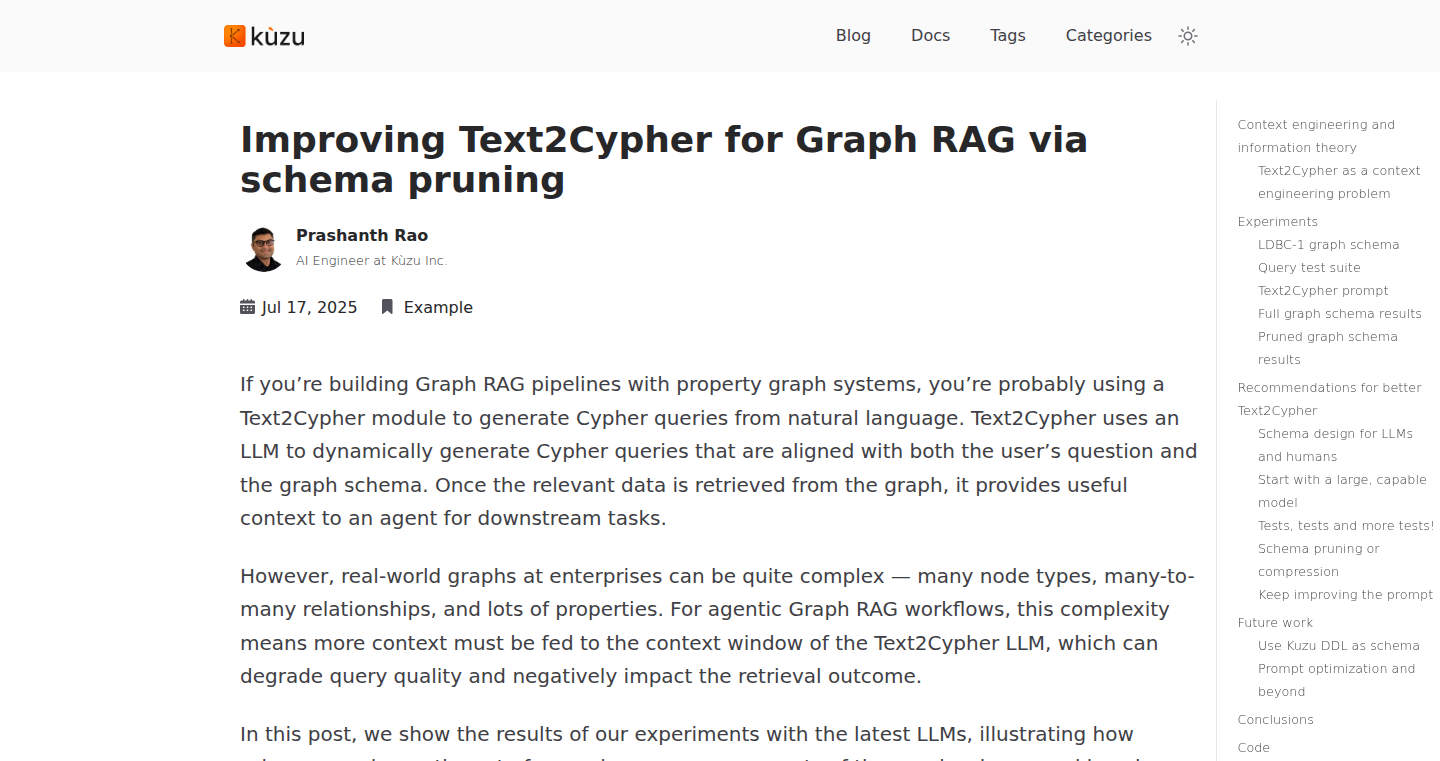
Author
laminarflow027
Description
This project explores how to make Large Language Models (LLMs) better at understanding and generating Cypher queries, the query language used for graph databases. The core innovation lies in experimenting with different schema formats (JSON, XML, YAML) when feeding graph data to LLMs and analyzing their impact on query accuracy. It also provides tips on designing graph schemas that are friendly to both LLMs and human developers. This helps improve the performance of graph-based applications by optimizing how LLMs interpret and interact with graph data, ultimately allowing users to query their data more effectively using natural language.
Popularity
Points 4
Comments 0
What is this product?
This project is about using LLMs to automatically generate Cypher queries from text descriptions. The key innovation is testing various graph schema formats (like JSON, XML, and YAML) to see which one helps LLMs perform best. It also focuses on strategies for crafting effective prompts to guide the LLM and structuring the underlying graph data. This is important because it makes it easier to interact with graph databases using natural language, instead of needing to write complicated code.
How to use it?
Developers can use this by studying the provided code and insights. They can apply the suggested prompt engineering techniques and graph schema design principles to their own Text2Cypher projects. This involves taking their graph data, structuring it in one of the tested formats (or adapting the suggestions to their preferred format), and using the prompt engineering strategies to guide their chosen LLM. The techniques can be integrated into any application that uses an LLM to interact with a graph database, such as a customer relationship management system or a knowledge graph.
Product Core Function
· Schema Format Experimentation: Evaluating JSON, XML, and YAML formats for graph schemas to determine their impact on LLM query generation. This helps developers choose the most effective format for their specific use case, improving the accuracy of generated queries. So this helps developers choose the right data format for better results.
· Context Engineering Techniques: Providing insights into creating effective prompts that include the most important parts of the graph schema. This helps improve the accuracy of LLM query generation. So this helps developers get more accurate results from LLMs.
· Graph Schema Design Tips: Offering suggestions for designing graph schemas that work well for both LLMs and human developers. This improves the overall usability and performance of graph-based applications. So this provides guidance on designing a user-friendly and performant graph.
· Performance Analysis: Offering results on latest LLMs, including hints for optimal prompt engineering. This helps developers identify and choose the best LLM models, and craft the most effective prompts for the best results. So this helps developers to improve performance by selecting the right models and prompts.
Product Usage Case
· Knowledge Graph Applications: In a knowledge graph used for scientific research, a researcher can describe a complex relationship between concepts in natural language, and the LLM (trained using this project's insights) will generate a Cypher query to retrieve the relevant information from the graph. So, instead of writing code, researchers can use natural language to find information.
· Customer Relationship Management (CRM) Systems: A sales representative can ask a CRM system, using natural language, to find all customers who have purchased a specific product and are located in a certain region. The LLM, leveraging the techniques from this project, can generate a Cypher query to search the CRM's graph database. This makes the system easier to use and improves efficiency. So, this helps in quickly finding customer data using natural language queries.
· Fraud Detection: An analyst investigating a fraudulent transaction can describe the suspicious activity in natural language. The LLM, utilizing the knowledge gained from this project, can generate a Cypher query to find related transactions and entities in a graph database. This speeds up the investigation process. So, this assists in quickly detecting fraudulent activities by analyzing graph data.
18
Jar.Tools - Feature-Rich .jar File Explorer

Author
Igor_Wiwi
Description
Jar.Tools is a comprehensive explorer for .jar files, offering advanced features for inspecting and manipulating Java archive files. It simplifies tasks like code decompilation, resource extraction, and manifest file viewing, addressing the common challenges developers face when working with compiled Java code. This tool's innovation lies in its ability to provide a detailed, user-friendly interface for navigating the often-complex structure of .jar files, making it easier to understand and modify Java applications without needing advanced command-line tools. It provides a graphical way to inspect and understand the internal workings of a .jar file.
Popularity
Points 2
Comments 2
What is this product?
Jar.Tools is like a magnifying glass for .jar files, which are essentially the building blocks of Java applications. It helps developers peek inside these files to see the code, resources (like images and text), and settings that make an application work. The innovation is that it offers a user-friendly graphical interface to replace the complex command-line tools typically needed to explore .jar files. It makes it straightforward to look at the code inside the .jar file, extract its resources, and check its manifest (which is like the application's ID card). So, it is an easier way to dissect and understand Java applications.
How to use it?
Developers can use Jar.Tools to analyze .jar files from various sources, such as third-party libraries or their own projects. Simply open a .jar file within the application. Jar.Tools then presents its contents in an organized view, allowing developers to navigate through packages, classes, and resources. They can extract files, view the source code (if available), and examine manifest files to troubleshoot issues or understand the structure of Java applications. The tool is a great complement to your existing IDE to understand how a specific library works, or to understand the code within a library. So, it makes analyzing and debugging Java applications much easier.
Product Core Function
· Class Decompilation: Jar.Tools allows developers to see the actual code inside compiled Java files (.class files). This helps understand the logic and functionality of the application or library components. This means you can directly inspect the code even when it's been packaged.
· Resource Extraction: Users can easily extract resources like images, configuration files, and other assets packed within the .jar. This is helpful for customizing or repurposing parts of an application. If you have a .jar file and want to grab a specific image or configuration file, you can do that easily.
· Manifest File Viewing: The application presents the manifest file, which contains important information about the application, such as its version, dependencies, and entry point. Understanding the manifest is crucial for diagnosing issues and understanding the application's behavior. So, you know what the application needs to run correctly.
· Package and Class Navigation: The tool provides an intuitive way to browse through packages and classes within the .jar file. This helps developers quickly locate specific code sections or resources they need. This helps you quickly locate parts of the program, saving you a lot of time when exploring a large .jar.
Product Usage Case
· Reverse Engineering of Libraries: Developers can use Jar.Tools to examine the code of third-party libraries to understand how they work, identify potential bugs, or learn best practices. This helps to understand the code logic if the source code is unavailable.
· Application Debugging: When debugging Java applications, developers can use Jar.Tools to inspect the contents of .jar files to identify the source of errors, understand dependencies, and troubleshoot runtime issues. This can quickly identify the source of a problem.
· Customization of Existing Applications: If a developer wants to modify an existing Java application, Jar.Tools can be used to extract resources or modify the source code (with proper licensing, of course) to tailor the application to their needs. This simplifies the ability to customize Java applications and add new features.
19
Benchstreet: AI-Powered Stock Prediction Benchmark
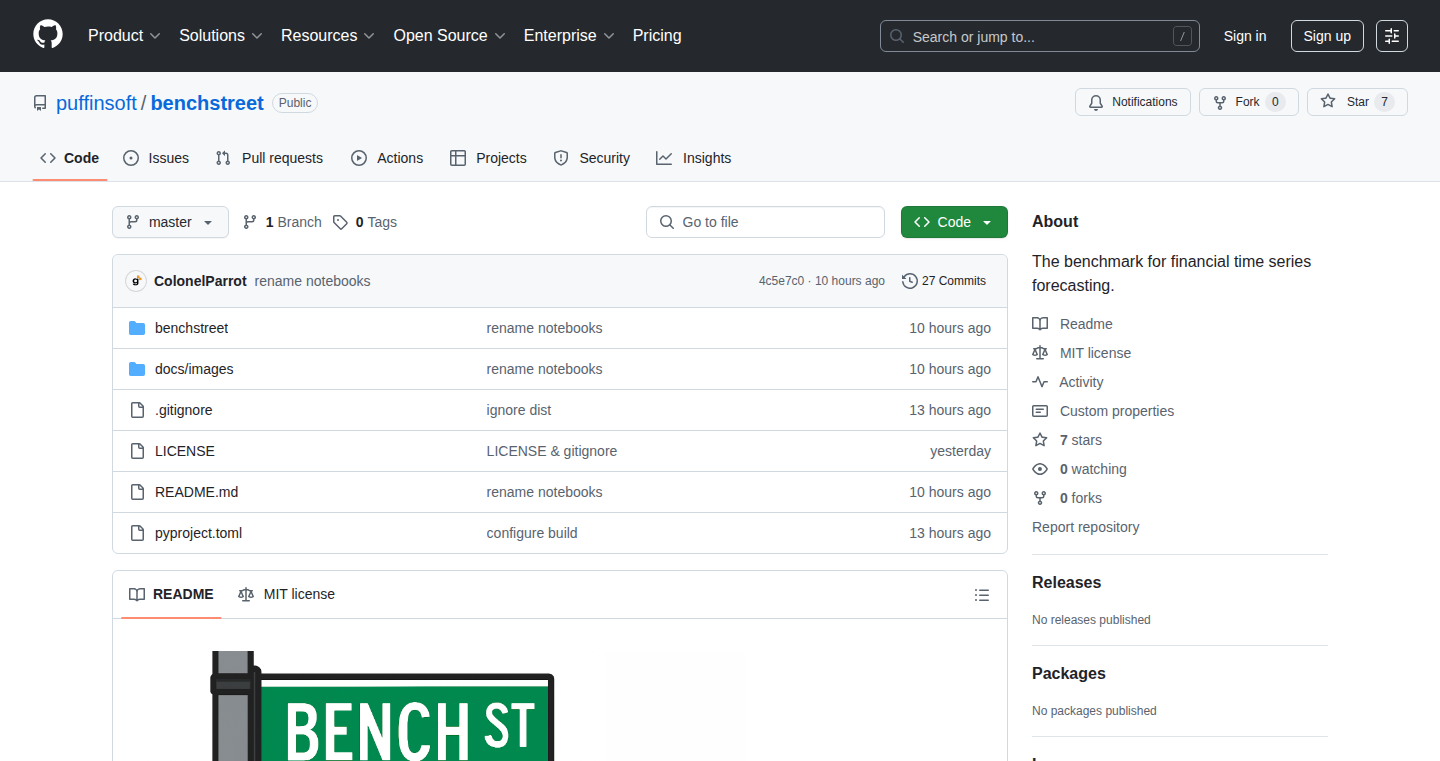
Author
ColonelParrot
Description
Benchstreet is a tool that allows developers to benchmark and evaluate the performance of their AI models designed for stock market prediction. It provides a standardized testing environment, allowing for direct comparison between different models and techniques. The innovation lies in its ability to provide a clear and reproducible way to measure the effectiveness of AI in a complex and volatile domain like finance. This addresses the common problem of evaluating AI models in financial markets, which often rely on proprietary datasets and evaluation methodologies, making it difficult to compare approaches.
Popularity
Points 4
Comments 0
What is this product?
Benchstreet is a benchmark platform for evaluating AI-driven stock prediction models. It offers a standardized set of tests, datasets, and evaluation metrics. Think of it as a rigorous race track for AI models that are trying to predict stock prices. The core innovation is providing a fair and reproducible environment for developers to compare their models. It simplifies the process of understanding how well a prediction model performs, which typically involves complex data processing and financial modeling.
How to use it?
Developers can use Benchstreet by integrating their AI models into the platform. They would provide their model's prediction for a given time series data, and Benchstreet will then calculate the performance metrics such as accuracy, profit, or loss. You can integrate the model by submitting predictions in a specific format, which is then compared against historical stock data within the platform's framework. This helps in identifying the strengths and weaknesses of the model and comparing it against other approaches. So, you get a clear view of how your model is doing in the financial market simulation, and you get the ability to share and compare results.
Product Core Function
· Standardized Datasets: Benchstreet provides a common set of financial data (e.g., stock prices, trading volumes) for all models to use. This ensures all models are tested under the same conditions, which is valuable for eliminating biases caused by data selection. It also streamlines the process of getting the data needed to test your prediction model.
· Evaluation Metrics: The platform calculates various performance indicators such as accuracy, Sharpe ratio (risk-adjusted return), and profit/loss. This gives the developers a complete view of the model's performance across many criteria. It helps developers identify what aspects their models are good at.
· Reproducibility: Benchstreet is designed to make the test results reproducible. By sharing their model and the data used, other developers can rerun the tests and verify the results. This enables you to build trust within your team and the open-source community.
· Benchmarking and Comparison: It allows for the comparison of multiple AI stock prediction models against each other. This allows users to compare different AI models and explore new approaches. The goal here is to stimulate innovation.
Product Usage Case
· Model Evaluation: A data scientist develops a new AI model for predicting stock prices. They can use Benchstreet to evaluate the model against existing models, obtaining a clear picture of how well their model performs compared to the current state of the art. This highlights areas for improvement and validation against accepted standards.
· Research and Development: Researchers studying different machine learning algorithms for financial forecasting can utilize Benchstreet to compare the effectiveness of various techniques, like comparing the performance of a Neural Network to a Support Vector Machine. This enables them to find the most effective approach to solving the problem.
· Trading Strategy Optimization: A quantitative analyst creates a trading strategy using AI. Benchstreet lets the analyst test and tune the strategy, which helps in figuring out parameters and strategies to optimize the prediction results. It is useful for backtesting and optimizing their model.
20
VinylSpin.video – Automated Vinyl Turntable Video Generator

Author
stagas
Description
This project, VinylSpin.video, allows users to automatically create visually appealing videos of vinyl records spinning. The innovative aspect lies in its automated process, leveraging image processing and animation techniques to generate these videos. It solves the problem of needing to manually film or edit videos of vinyl records, making it easier and faster to share music experiences online.
Popularity
Points 3
Comments 0
What is this product?
VinylSpin.video is a web tool that takes a picture of your vinyl record and generates a video of it spinning. It does this by using image processing to identify the record and then applying animation techniques to simulate the spinning effect. This is innovative because it automates a previously manual process, creating visually interesting content with minimal effort. So this is helpful because you don't need any expensive equipment or video editing skills to create a shareable video.
How to use it?
Developers can use this tool by uploading an image of a vinyl record. The tool then processes the image and generates the spinning video. You could integrate this into music platforms, record label websites, or personal blogs to enhance the user experience and provide a more engaging way to showcase music. So this allows you to offer something beyond just a static image of an album cover.
Product Core Function
· Image Processing: The core functionality involves sophisticated image analysis to identify the vinyl record's edges and features. This is achieved by looking for circular shapes in the image, calculating the size and dimensions. This is valuable because it can automate the detection of the record, reducing the need for manual selection. So this means you don't have to manually crop and edit the record image.
· Animation Generation: After identifying the record, the tool animates it to spin, simulating the effect of a turntable. This involves techniques to create a smooth and realistic rotation. This is useful for creating the visual appeal of the spinning record, making it more engaging. So this makes the video more visually interesting to the viewer.
· Video Output: The tool produces a final video in a shareable format, suitable for platforms like social media. This includes optimizing the video for different platforms. This is valuable because it makes the video easily shareable on various platforms. So this makes sharing music experiences easy and accessible to everyone.
· User Interface (UI) and Ease of Use: The project would likely have a user-friendly UI, ensuring that users can easily upload images and customize settings. This is useful because it improves the overall user experience, allowing people with no technical background to use it. So this makes it simple to use and share without any technical difficulties.
Product Usage Case
· Music Blog Integration: A music blogger could use this to create engaging video content for their blog posts about new vinyl releases. They can upload a picture of the record and generate a spinning video that complements their review, increasing reader engagement. This is helpful because it makes the content more appealing and shareable, driving up visitor traffic.
· Social Media Sharing: Musicians could use VinylSpin.video to promote their vinyl releases on social media platforms. This allows them to create eye-catching content without the need for complex video editing software. So this gives a much easier way to promote music to a larger audience, by creating visually appealing and easily shareable content.
· Record Label Promotion: Record labels can use this to create promotional materials for their artists' vinyl releases. This is valuable in the music promotion space because it offers a simple solution to generate high-quality visual content that enhances the overall brand image and marketing campaigns. So this is a way to generate high-quality marketing content without expensive resources.
· Personal Music Collection Sharing: Music enthusiasts can use this tool to create videos of their own vinyl collections for sharing on platforms like Instagram or YouTube. This facilitates the expression of passion and interest in music, allowing them to share their experiences with friends and other music lovers. So this offers a visually appealing way to showcase a music collection to others.
21
Take - Logic-Driven File Line Processor
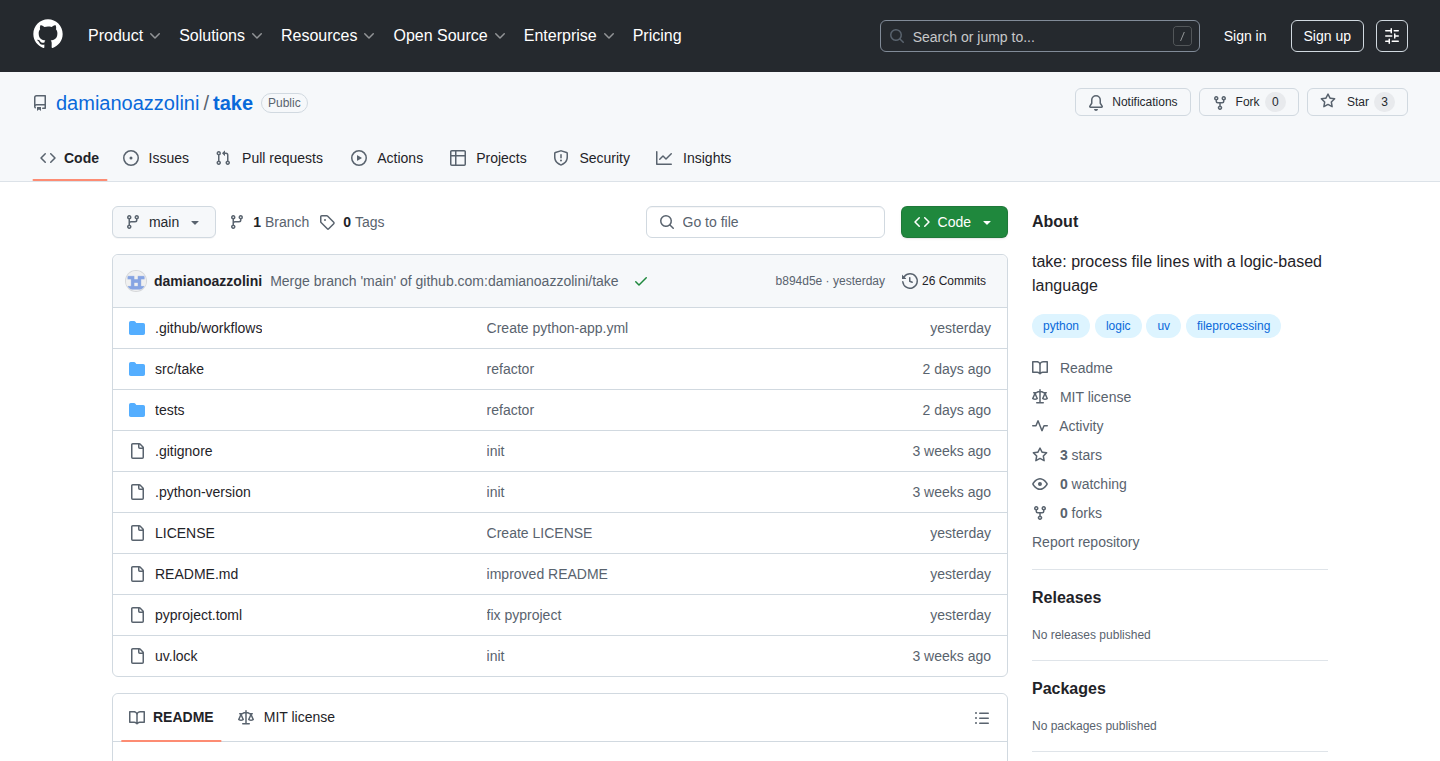
Author
0x07ca
Description
Take is a command-line tool that lets you process lines of text from files using a logic-like language. It's designed for situations where you need to filter, transform, and analyze text data without writing complex scripts. The innovation lies in its simple, declarative language that abstracts away the complexities of regular expressions and scripting, making text processing more accessible and efficient.
Popularity
Points 3
Comments 0
What is this product?
Take allows you to define rules using a simplified logic, similar to how you might describe a problem with 'if-then' statements. This contrasts with traditional methods that might involve complex scripting languages or regular expressions. The core idea is to simplify text processing by making the rules more human-readable and easier to maintain. So what? This makes it easier and faster to extract information from large text files, without the need for deep technical knowledge.
How to use it?
Developers can use Take in their command line or integrate it into scripts for tasks like data cleaning, log analysis, and data transformation. The user provides a rule file (a text file) describing the processing logic, and Take applies this logic to each line of the input file. Integration is simple: call Take from the command line, providing the input file and the rule file. So what? This eliminates the need to write long scripts for repetitive text processing tasks.
Product Core Function
· Filtering lines based on conditions: Take allows you to select specific lines from a file that match certain criteria. For example, you can filter log files to show only error messages. So what? This lets you quickly identify and isolate relevant information.
· Transforming lines: You can modify the content of each line, for example, extracting specific data fields or changing the format of dates. So what? This makes it easier to prepare data for further analysis or integration with other systems.
· Data extraction: Take helps extract specific pieces of information from text lines based on your defined logic. This could be extracting IP addresses, timestamps, or user IDs from log files. So what? This automates repetitive data extraction, saving time and effort.
· Pattern matching: While not using regular expressions directly, Take can incorporate logic to effectively match patterns within text lines. So what? This allows for complex analysis without needing to master advanced regex syntax.
Product Usage Case
· Log file analysis: Use Take to filter and extract specific error messages from server logs. For instance, you can pinpoint lines related to a specific time period or user ID. So what? This helps with debugging and identifying issues.
· Data cleaning: Clean up and standardize data from messy text files. You can remove unwanted characters, reformat dates, or extract relevant fields. So what? This helps in preparing data for further analysis or import into other applications.
· Configuration file processing: Take can be used to extract key-value pairs from configuration files or other text-based configuration formats. So what? This automates the process of extracting settings and avoids manual labor.
· Data transformation for data pipelines: Use Take as a component in data pipelines to prepare and transform data before loading it into a database or data warehouse. So what? This streamlines the data preparation workflow.
22
Exify: Browser Extension for Advanced Image Metadata Inspection
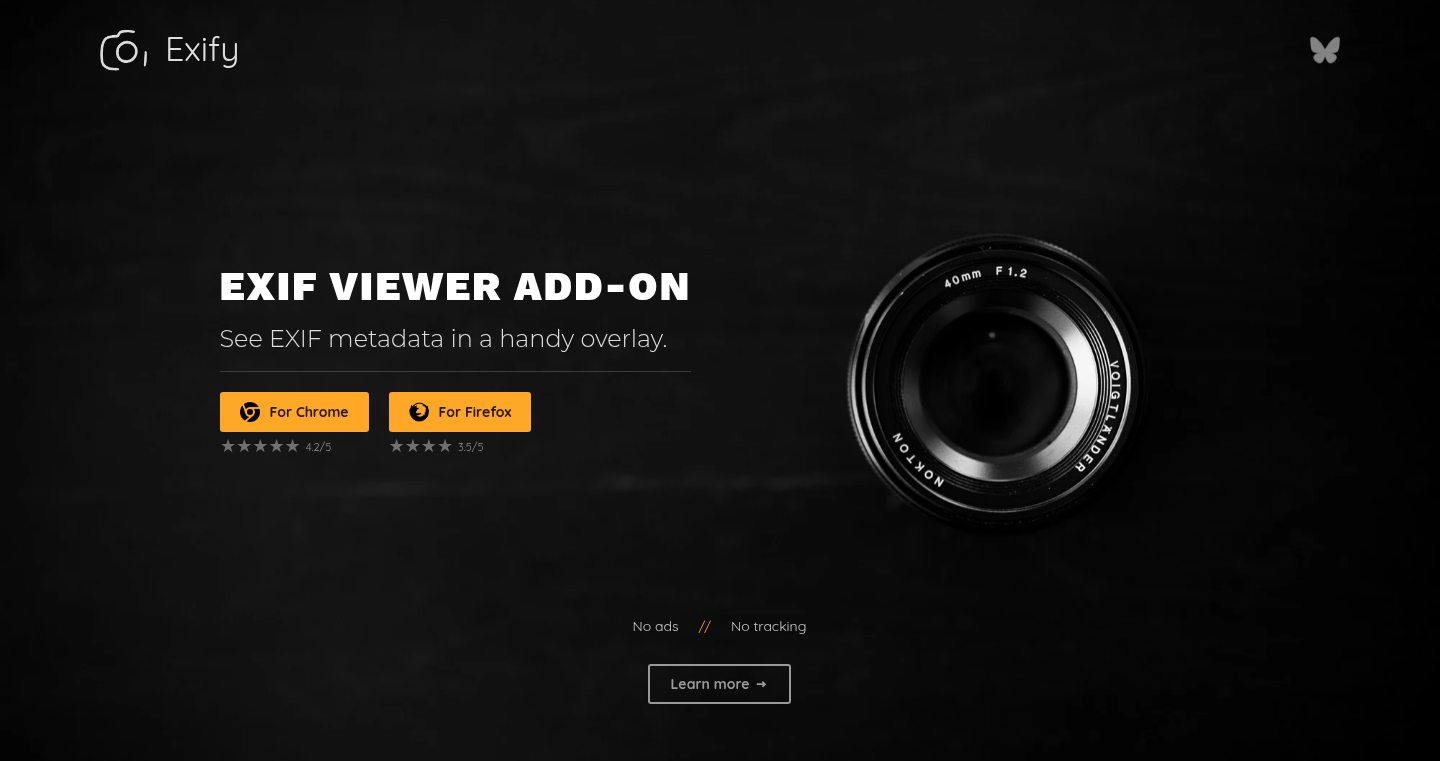
Author
antonpodolsky
Description
Exify is a browser extension that lets you easily view and search the hidden technical details (metadata) of any image you see online. Initially designed for photographers to quickly see camera settings, it now offers a comprehensive view of all metadata, including things like the camera model, lens used, exposure settings, and even the location where the picture was taken. It addresses the problem of inaccessible image data, making it easy for anyone to explore the technical aspects of a photograph.
Popularity
Points 2
Comments 1
What is this product?
Exify is a browser extension that uses web technologies to read and display the embedded metadata within images. When you hover over an image, Exify extracts and displays the EXIF (Exchangeable Image File Format) data, which is like a detailed record of how the picture was taken. The core innovation lies in its accessibility – making complex technical information readily available with a simple hover. So, it uses client-side JavaScript and browser APIs to analyze image data, not requiring any server-side processing which ensures user privacy.
How to use it?
Developers and users install the extension in their browser and it automatically works on any webpage. When you hover over an image, a small window pops up displaying the image's technical details. This is particularly useful for developers who need to understand how images are created or optimized, designers who want to analyze image properties, or anyone curious about the technical aspects of photography. You can use it on any website, no setup is required, making it very easy to integrate into your workflow. The extension allows you to view this hidden information without needing to download the images, right in the browser.
Product Core Function
· EXIF Data Extraction and Display: Exify extracts EXIF data using JavaScript, which includes camera model, aperture, shutter speed, ISO, and more. It displays this data in an easy-to-read format. So what? This is useful for photographers wanting to quickly see how a shot was taken or for anyone interested in learning more about photography techniques.
· Metadata Search: The extension provides a search function that allows users to search through the metadata of multiple images on a single webpage. This enables users to quickly find images with specific camera settings or created at a certain location. So what? It's great for researchers, designers, and developers looking for particular image data. You can quickly filter images.
· Cross-Platform Compatibility: Works on all desktop browsers. So what? It enhances accessibility across various operating systems, making the tool usable by a broader audience.
Product Usage Case
· Photography Analysis: A photographer can use Exify to analyze the settings of various images they find online to learn techniques or understand how others achieve certain effects. So what? Understand how a photo was taken can inspire your own creative process.
· Web Design and Optimization: A web developer can use Exify to check image file sizes, formats, and compression settings to ensure optimal performance and image quality on a website. So what? Helps optimize images for faster loading times and better user experience.
· Metadata Investigation: Digital forensics professionals and researchers can use Exify to analyze the metadata of images as part of an investigation. So what? Helps in identifying the provenance and authenticity of an image, providing crucial information.
23
Aletheia Protocol: A Blueprint for a Fair Web
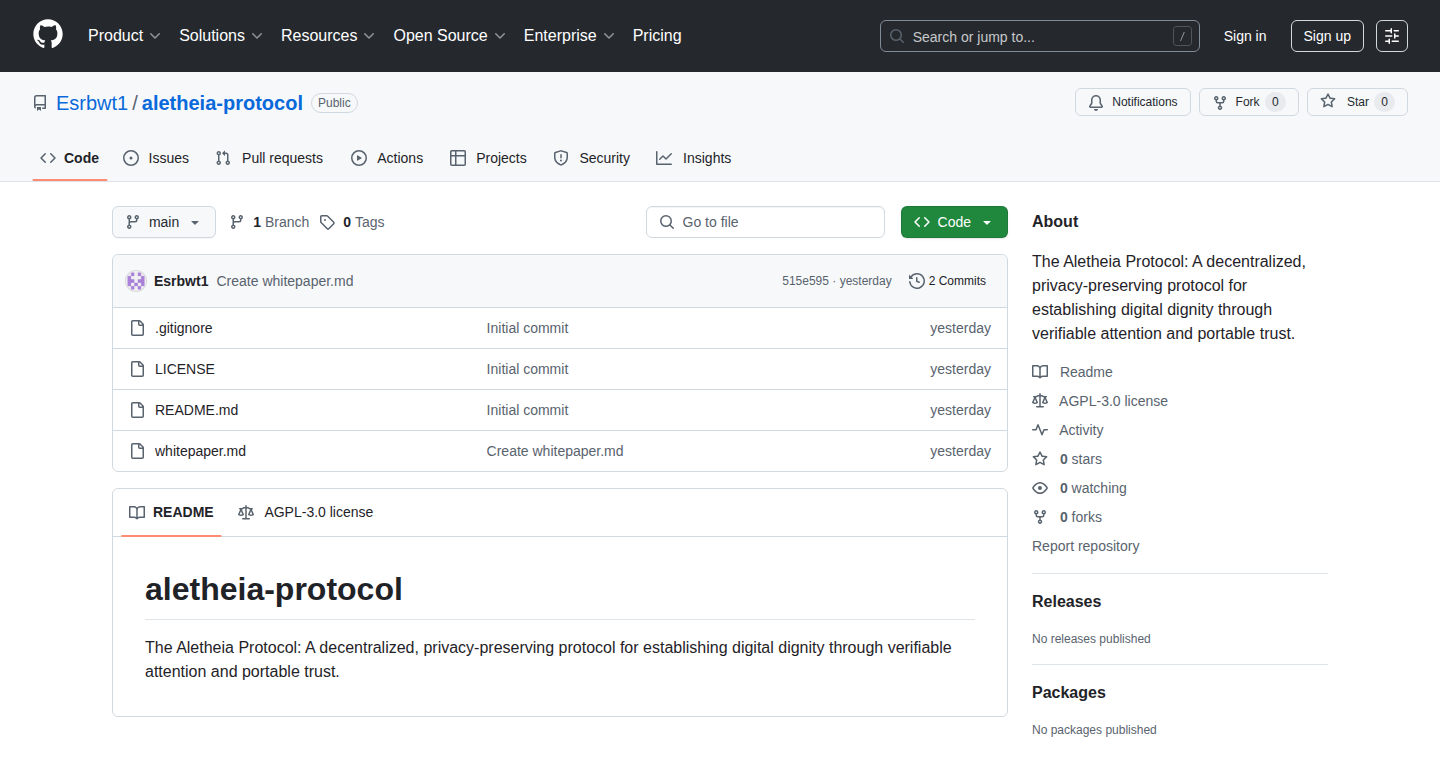
Author
Esrbwt
Description
Aletheia Protocol proposes a new way to build the web, focusing on fairness and preventing exploitation. It's like designing a new city where everyone has equal rights and no one can be unfairly taken advantage of. The core idea is to build a decentralized web with built-in protections against manipulation and data breaches. This project tackles the critical problem of user data privacy and unfair practices that plague the current internet.
Popularity
Points 2
Comments 1
What is this product?
The Aletheia Protocol isn't a specific piece of software you can download right now, but a set of principles and a technical roadmap for building a better web. It imagines a web where your data is secure, you control who sees it, and interactions are fair. It probably utilizes concepts like decentralized identities (like having a unique digital key), secure communication channels, and possibly even a new approach to how we store and share information online, to prevent existing issues like data breaches and unfair data usage. Think of it as a conceptual blueprint for the 'good' internet.
How to use it?
Developers can use the Aletheia Protocol as a foundation for building new applications and services. They can incorporate the principles of decentralized identities, secure communication, and user-centric data management into their projects. This might involve using new protocols, or implementing different ways of verifying who you are online, or designing applications that don't track your every move. For example, a developer building a social media platform could use the Aletheia Protocol to ensure that users have complete control over their data and prevent any data exploitation. This enables building new web3 application and improves on current web2.
Product Core Function
· Decentralized Identity Management: This is how the protocol will verify who you are without relying on a single company. Imagine a digital passport that you fully control. This prevents companies from tracking you across the web. So, what does this mean? This means better privacy: your information is safer.
· Secure Communication Channels: This is like having a private, encrypted tunnel for all your online conversations and interactions. This prevents eavesdropping and data breaches. This means more secure online interactions.
· User-Centric Data Management: This shifts control of data back to the user. You decide who sees your information and how it's used. This gives you true control over your information. So, this helps users have control over their data and improve privacy.
Product Usage Case
· Building a privacy-focused social media platform: Developers could use Aletheia Protocol principles to create social networks where users control their data, preventing targeted advertising based on unethical data collection. This protects the user's personal data and increases privacy.
· Developing secure and private messaging apps: This technology can be used to build communication tools where messages are encrypted, and users have control over who can see their conversations. This can protect from malicious attacks.
· Creating decentralized identity systems for websites: This simplifies the login process for websites while keeping user data secure. Users own their identities and their personal data.
· Data Security in Finance and Healthcare: Aletheia Protocol principles can secure financial and healthcare data by preventing unauthorized access and data breaches. This enhances the reliability of financial systems.
24
Mention.click - Reddit Conversation Navigator
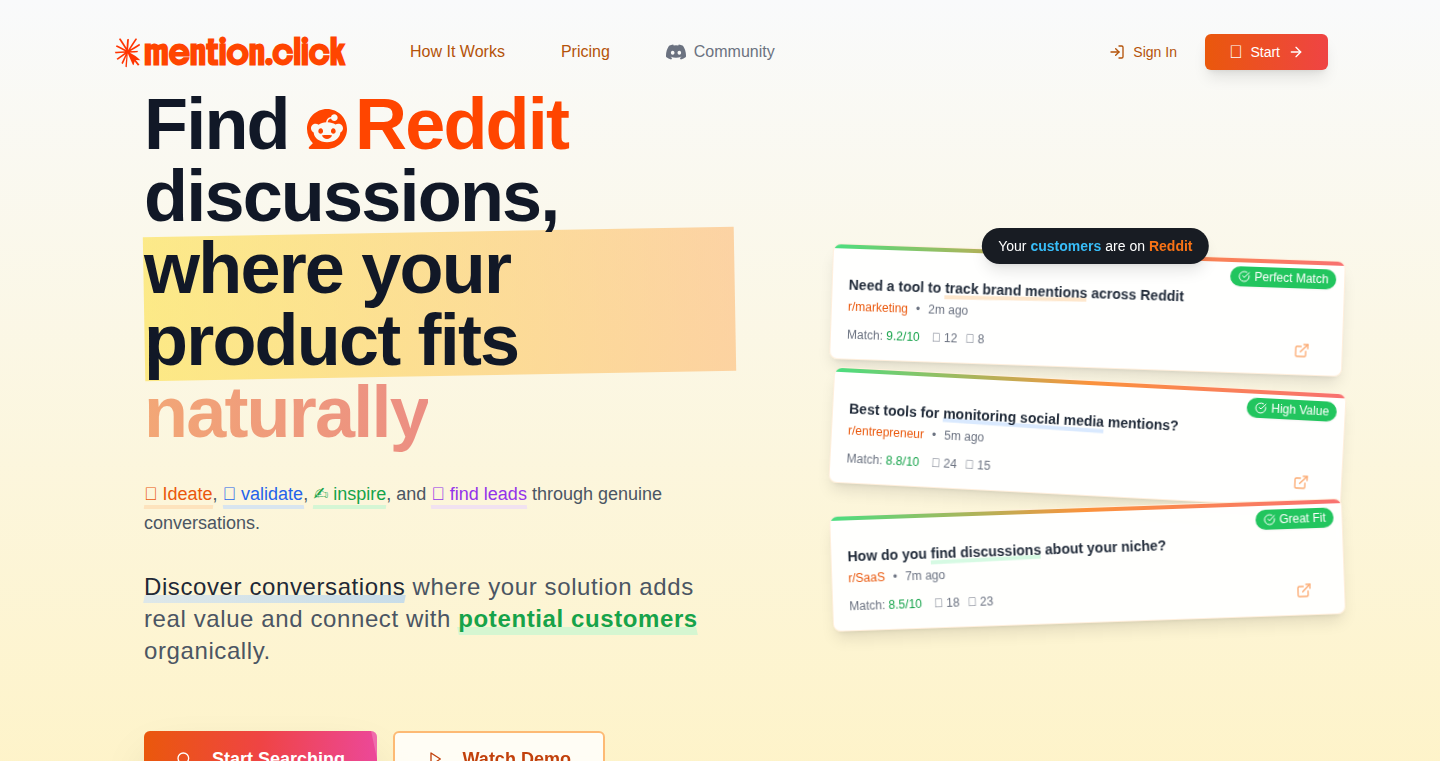
Author
lenvl
Description
Mention.click helps you discover relevant Reddit conversations where your product or service is a good fit. It uses a smart search engine to analyze Reddit posts and comments, identifying opportunities for lead generation, customer feedback, and growth. The core innovation lies in its automated identification of valuable discussions, saving you the time and effort of manually sifting through countless Reddit threads. So this is useful to identify potential customers and markets more efficiently.
Popularity
Points 3
Comments 0
What is this product?
Mention.click is a tool that automatically searches through Reddit, looking for discussions where your product or service could be relevant. Think of it as a specialized search engine for Reddit. It uses advanced algorithms to understand the context of conversations and identify potential customers or users who are actively discussing problems your product solves. So this tool uses smart technology to do the digging for you.
How to use it?
Developers can use Mention.click by providing keywords or descriptions related to their product or target audience. The tool then provides a list of Reddit threads and comments that match those criteria. You can then directly engage with these conversations, offering your product as a solution, gathering feedback, or simply learning more about your target market. For instance, you can integrate Mention.click into your marketing workflow to find and join relevant discussions effortlessly.
Product Core Function
· Automated Reddit Search: This is the core function. It uses intelligent search algorithms to pinpoint discussions that match your criteria, saving time and effort. It helps you to efficiently find leads by targeting relevant online conversations.
· Keyword and Contextual Matching: The tool understands not just keywords, but also the context of the conversation. This means it can find discussions that are highly relevant even if they don't use the exact keywords. This is useful because it improves the quality of the leads you find.
· Lead Generation: Identify individuals or communities actively discussing problems that your product solves. It helps you directly contact potential customers.
· Feedback Gathering: Directly access user discussions, which can inform product decisions.
· Market Research: Learn from user opinions and conversations to understand the market and your competitors better. So it provides data to fine-tune product and marketing strategies.
Product Usage Case
· A software developer creates a project management tool. They use Mention.click to search Reddit for conversations about project management challenges. They then directly engage in these conversations, offering their tool as a solution to the problems discussed. So you can turn problems into solutions and gain new users.
· A SaaS company launches a new product and wants user feedback. They use Mention.click to find discussions about similar products and ask for direct feedback. This provides invaluable data to inform product decisions.
· An e-commerce business uses Mention.click to find discussions about specific product needs. They then tailor their marketing efforts to target users with those needs, improving conversion rates. This helps businesses improve marketing performance by finding the right audience.
25
Roceet Review - Collaborative Media Feedback Platform
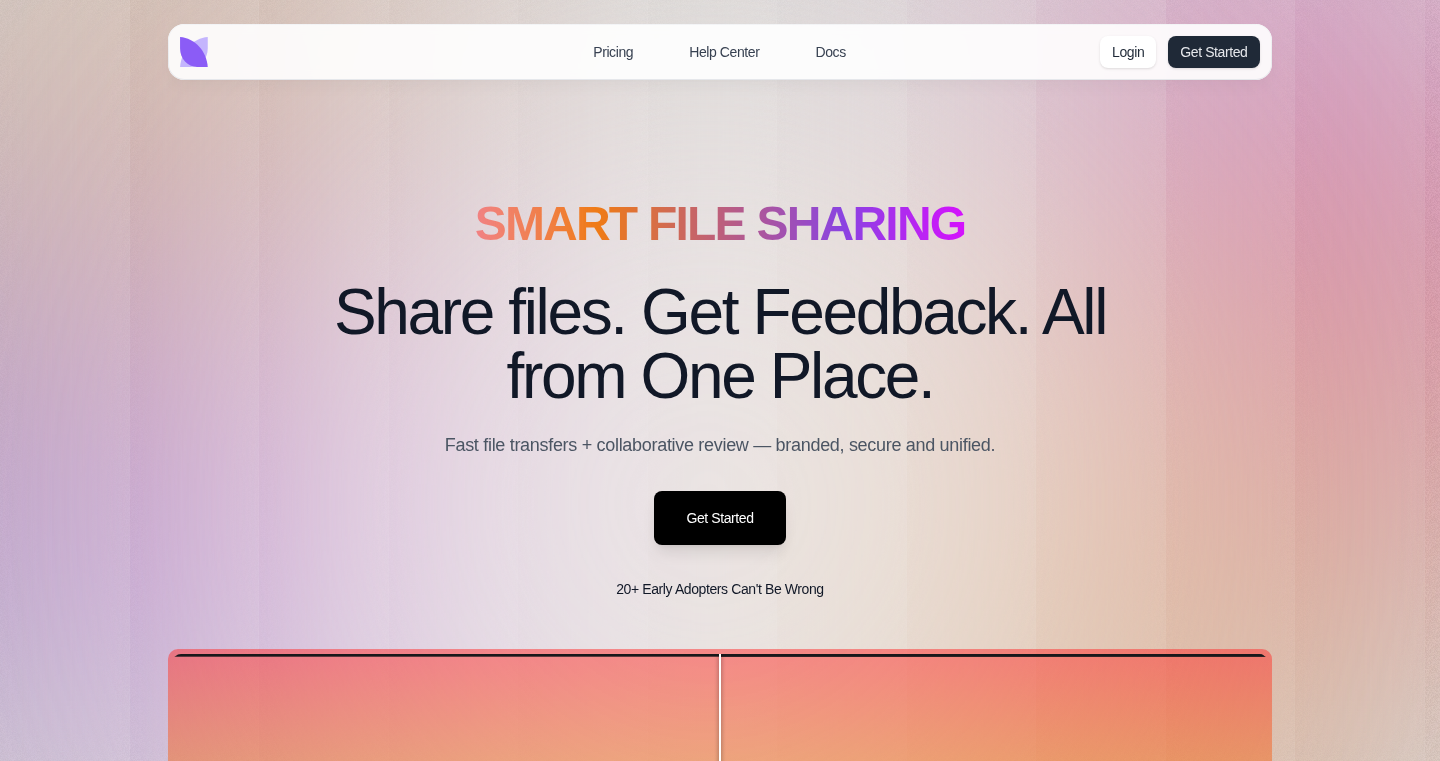
Author
yellow_dot
Description
Roceet Review is a platform designed to streamline the process of receiving feedback on media files (photos, videos, etc.). It allows users to upload files, share review links, and receive comments, approvals, and even drawings directly on the media. This innovative approach addresses the common problem of disorganized feedback and tedious file transfer, making it easier for creatives and their clients to collaborate effectively. It pivots from a previous file-sharing platform, leveraging existing architecture to build an additional, valuable tool. So, it's useful because it solves the communication headache with a structured feedback system.
Popularity
Points 2
Comments 1
What is this product?
Roceet Review is a web-based tool built on top of an existing file-sharing platform (Roceet). It simplifies media review by providing a central location for uploading files and gathering feedback. The core innovation lies in its interactive feedback mechanism, allowing clients to not only comment but also visually annotate the media directly. This visual feedback is crucial, providing clarity and reducing ambiguity in the review process. For developers, this illustrates how existing infrastructure can be leveraged to build new, valuable tools quickly and efficiently. Think of it as a collaborative digital whiteboard for media. So, the product improves the feedback process.
How to use it?
Developers can use Roceet Review to integrate into their own media workflow or build similar tools. You can integrate it into projects where visual feedback and file approval are critical. Simply upload your media files, generate a review link, and share it with your clients or team members. They can then view the files, leave comments, approve files, and even draw directly on the images or videos to provide specific feedback. This is useful for photographers, videographers, graphic designers, or anyone working on creative projects needing client or team approvals. So, it helps in easy integration with other tools.
Product Core Function
· Upload and share media files: This core function provides the basic infrastructure for media sharing. It allows users to upload photos, videos, and other file types. This allows everyone to see the media.
· Generate review links: Creates unique links for each review session. This enables controlled access and streamlined feedback collection. This saves time and provides easy access.
· Receive comments and approvals: Allows clients to provide feedback through comments and approval options. Facilitates organized and structured feedback. This helps in clear and organized communication.
· Interactive annotation tools: Enables clients to draw directly on the media to highlight specific areas or provide more precise feedback. This visual enhancement of feedback improves clarity and speed of edits.
· Leveraging existing architecture: The tool builds upon existing file sharing infrastructure to build another useful product. This helps in faster development and leverages existing product functionality.
Product Usage Case
· A photographer can use Roceet Review to receive feedback on photos from clients. Clients can comment directly on specific photos or draw on the photos to indicate areas that need retouching, dramatically improving the feedback loop and reducing back-and-forth emails. This saves time and keeps the creative process moving forward.
· A video production company can use Roceet Review to get feedback on video edits from clients. Clients can comment on specific frames and moments, with annotations to guide editors on needed adjustments. This enhances client satisfaction and reduces production delays.
· A graphic designer can use the platform to get feedback on design prototypes. Clients can annotate a design with clear instructions on what needs changing, enhancing the process of iterative design review.
26
WanImage: Transforming Video into Visual Stories
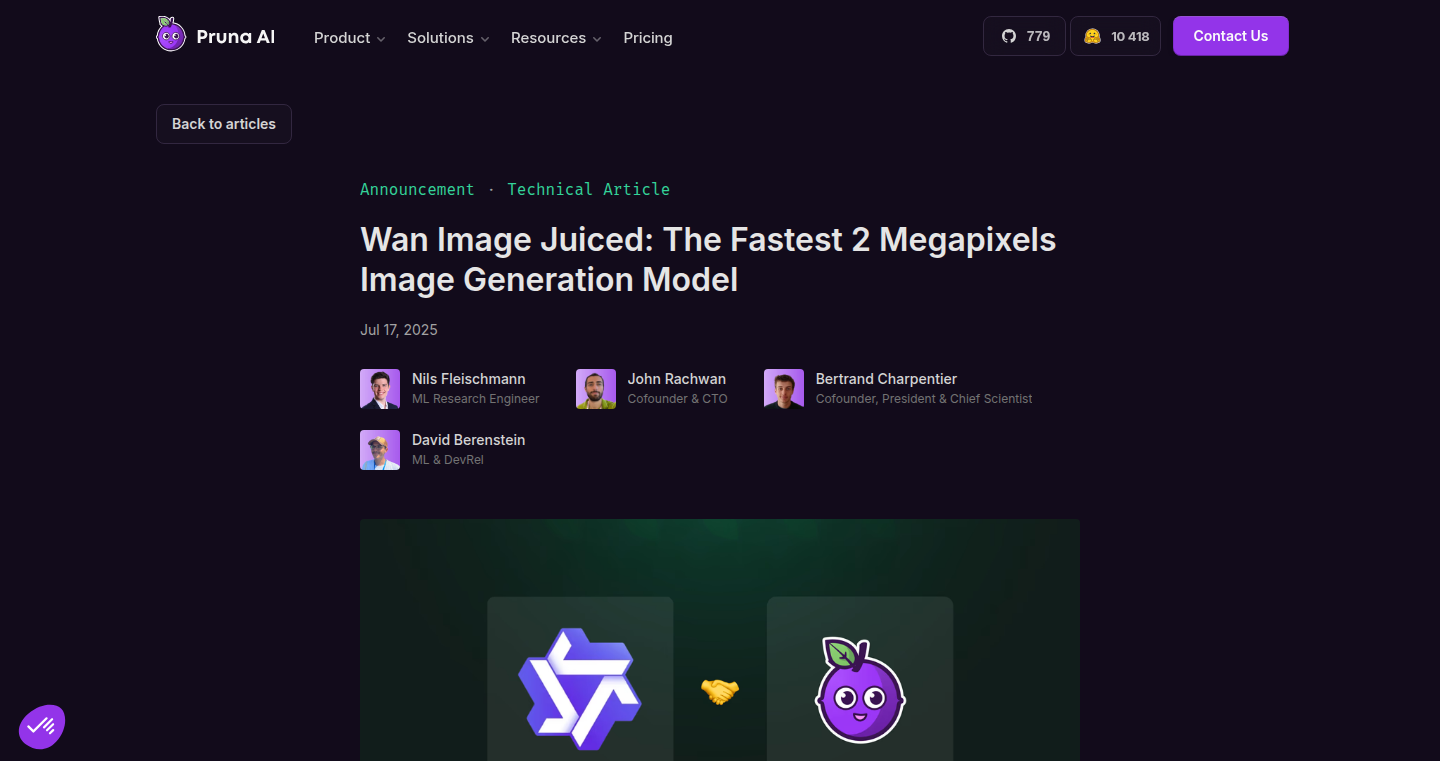
Author
dberenstein1957
Description
WanImage takes video files and automatically generates a series of representative images, creating a visual summary of the video content. The core innovation lies in its use of advanced image processing techniques and AI to select the most informative frames, addressing the common problem of quickly grasping the essence of long videos without watching the entire thing.
Popularity
Points 3
Comments 0
What is this product?
WanImage is a tool that analyzes a video and extracts a set of key images that best represent the video's content. It does this by using computer vision and AI algorithms to identify significant scenes and moments within the video. The technical innovation is in its automated frame selection and intelligent analysis, allowing users to quickly understand the video's core message without manual editing. So this means, if you have a long training video, you can just use this tool to generate snapshots of the important points and then you can understand what the training is about without wasting your time.
How to use it?
Developers can use WanImage through its API or command-line interface, integrating it into video editing workflows or creating automated content summarization tools. For example, a video platform could use WanImage to automatically generate preview images for uploaded videos. Its integration could be done via a script that calls the API to process the video file and returns the representative images. So if you are a developer of a video-hosting platform, you can use it to automatically generate preview thumbnails for your users' videos.
Product Core Function
· Automated Keyframe Extraction: This function analyzes video footage and automatically selects the most representative frames. It uses computer vision algorithms to identify scenes, detect motion, and analyze visual features, helping users save time and effort by avoiding manual selection. This enables users to create quick video summaries for presentations or social media.
· Scene Detection and Segmentation: The tool identifies distinct scenes within the video, allowing for more organized summaries. The use of AI-powered scene detection allows users to easily navigate and understand the video content. This function is particularly useful for analyzing long videos, such as webinars or lectures, by breaking them down into manageable segments.
· Image Processing and Enhancement: The selected keyframes are then processed to improve image quality and clarity. This may include noise reduction and color correction to enhance the visual appeal of the generated images. It helps to ensures that the output images are visually appealing and of high quality, increasing engagement.
· API and Command-Line Interface: WanImage is designed for integration with existing workflows and toolchains. This provides flexibility to use WanImage with any programming language, or integrate it into existing video processing pipelines. This functionality allows developers to automate video summarization tasks efficiently, saving time and resources.
Product Usage Case
· Content Summarization for Educational Videos: A teacher uploads a long lecture video and utilizes WanImage to generate a set of thumbnails representing key points. Students can quickly grasp the topics discussed, saving them valuable study time and helping them focus on the core concepts. This accelerates learning and improves comprehension.
· Automated Thumbnail Generation for Video Platforms: A video hosting site integrates WanImage into its platform. As users upload videos, the tool automatically creates representative thumbnails for each video, improving user experience and content discoverability. This increases user engagement and platform traffic.
· Creation of Promotional Material for Marketing Videos: A marketing team uses WanImage to quickly generate compelling visuals from their video footage for advertisements or social media. They can create engaging promotional content with the help of extracted images. It helps to boost marketing campaigns with engaging visual content.
· Video Asset Management and Indexing: A company uses WanImage to automatically extract key images from training videos, making it easy to index and search video content in its database. This enhances the company's video library search capability, saving time and enhancing productivity.
27
Near - Comprehensive OSINT Toolkit
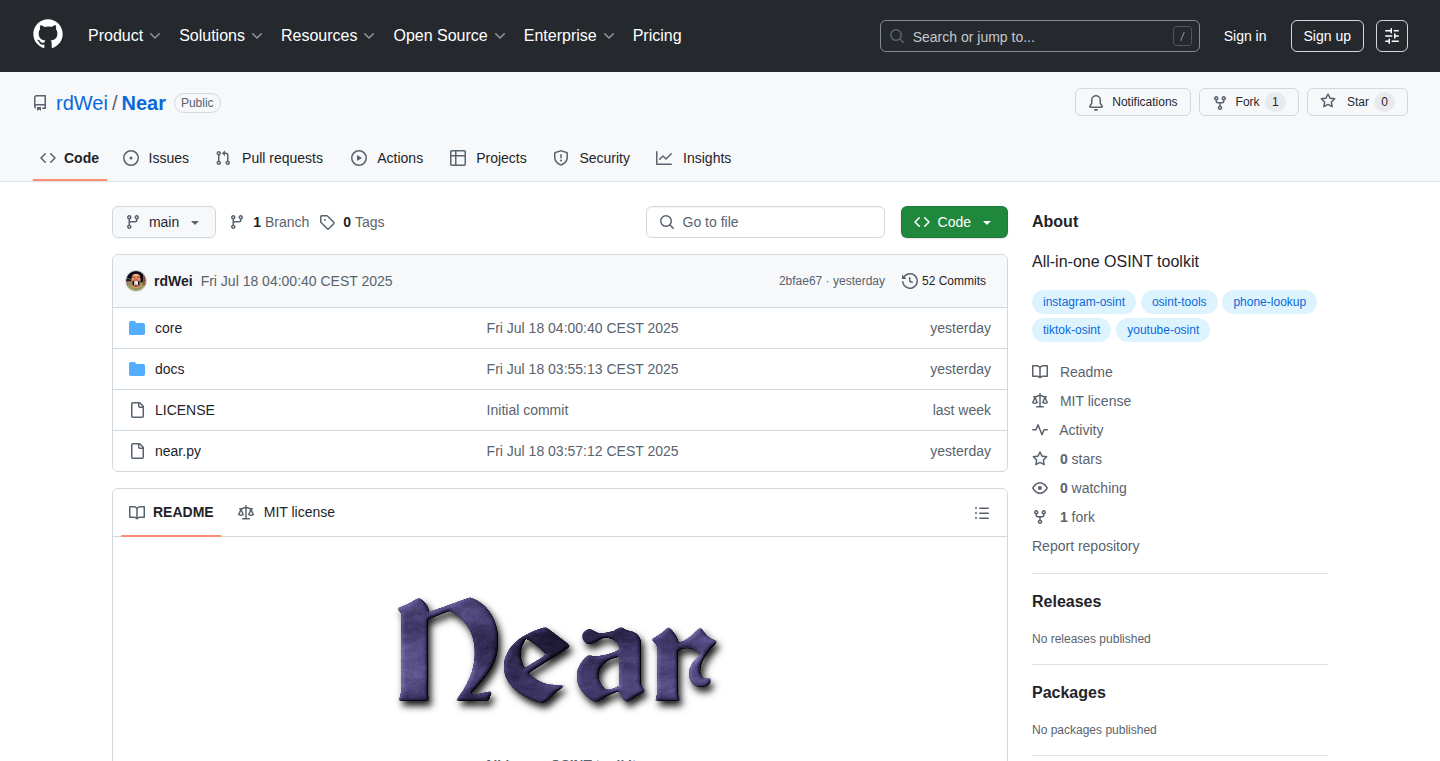
Author
osuser99
Description
Near is an all-in-one OSINT (Open Source Intelligence) toolkit. It simplifies the process of gathering and analyzing publicly available information, addressing the challenge of collecting and organizing data from various online sources. The core innovation lies in its integrated approach, automating the manual work involved in OSINT investigations and presenting the results in a user-friendly manner.
Popularity
Points 3
Comments 0
What is this product?
This toolkit combines multiple OSINT techniques into a single interface. It automatically searches for information across the web, including social media, public records, and other online sources. It then organizes and presents the data in a way that makes it easy to understand the connections and patterns within the information gathered. Think of it as a smart search engine for finding public data about people, organizations, or topics. So this is useful because it saves time and effort in manual research by automating the data collection and analysis process, allowing investigators to focus on interpreting the results.
How to use it?
Developers can use Near through its command-line interface or integrate its functions into their own applications via its API (if available). The toolkit is typically used by providing search terms, then it automatically gathers data from different sources. For instance, a developer building a security tool could use Near to quickly identify potential vulnerabilities or to get a quick overview of the public footprint of a specific user or organization. So this is useful because it provides a platform to build automation upon by providing the core logic used to find information in a readily available manner.
Product Core Function
· Automated Data Collection: Near automates the process of collecting data from various online sources, such as social media platforms, websites, and public databases. This saves investigators considerable time and effort compared to manually searching and gathering information from each source individually. The value lies in its ability to rapidly gather information from diverse sources for analysis.
· Data Aggregation and Organization: The toolkit aggregates the collected data and organizes it into a coherent format, often including timelines, relationships, and summaries. This makes it easier to understand the connections and patterns within the gathered information. The value here is to quickly organize collected data to make it easier to identify key pieces of information.
· User-Friendly Interface: Near offers a simplified interface for interacting with the OSINT process, making it accessible to both technical and non-technical users. This ease of use reduces the learning curve and allows investigators to quickly start their analysis. This is useful because it takes the complexity out of the process, allowing users to focus on interpreting the findings rather than the technical process of data collection.
· API Integration (Hypothetical): If Near offers an API, this would allow developers to integrate its functionality into other applications and tools. This would enable developers to build custom OSINT solutions or integrate Near's capabilities into existing workflows. This is useful because it allows you to build automation on top of the tool to work with your specific needs.
Product Usage Case
· Security Auditing: Security professionals can use Near to assess the public footprint of an organization or individual, identifying potential vulnerabilities or threats. For example, an auditor could use Near to quickly find which social media accounts are associated with a particular business and identify any public data that could be used in a social engineering attack. This is useful because it offers the ability to quickly perform a broad overview of an organization's public presence to assess security threats.
· Competitive Analysis: Businesses can use Near to gather information about their competitors, such as their online presence, customer reviews, and market activities. This can help businesses understand their competitive landscape and identify opportunities. This is useful because it allows you to quickly understand a competitor's brand and market positioning.
· Investigative Journalism: Journalists and researchers can use Near to gather and analyze information for investigative reporting. For example, a journalist investigating a corruption case could use Near to quickly identify the online activities and associations of individuals of interest. This is useful because it offers a means of gathering information to support research and to build a timeline of the actions of different people.
28
Presenton: Local AI-Powered Presentation Generator
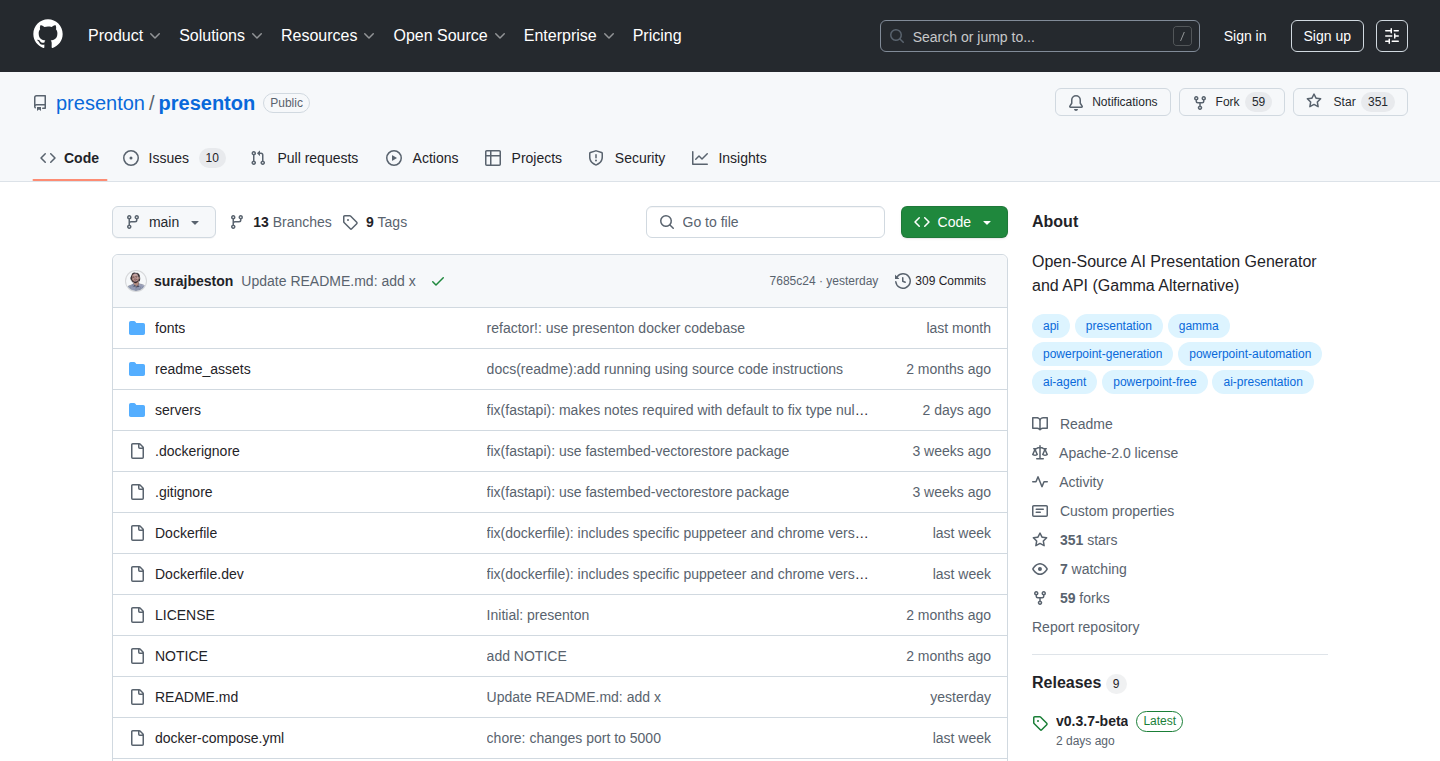
Author
sooraz_zha
Description
Presenton is an open-source application that lets you create presentations using the power of artificial intelligence, and it runs entirely on your own device. This means your data stays private. It's like having a smart presentation assistant that works locally, using models like OpenAI, Gemini, or even your own custom-built AI models through Ollama. The innovation lies in bringing AI presentation generation to your desktop, ensuring privacy and control over your data.
Popularity
Points 2
Comments 1
What is this product?
Presenton is a program that uses AI to automatically create presentations. It connects to AI models, such as those provided by OpenAI or Google (Gemini), but importantly, it can run on your own computer. This means your presentation content and data are never sent to the cloud, protecting your privacy. The core technology uses natural language processing (NLP) to understand your ideas and then generates slides with text, and potentially, images. So this is like having a personal AI-powered presentation maker on your computer; you keep control of your data.
How to use it?
Developers can use Presenton in several ways. First, you can use it directly as an application on your computer, feeding it your ideas and letting it create the presentation. Second, you can integrate it into your own applications or workflows by using its open-source API, which provides the backend for AI presentation generation. The key is that this can be done locally, opening up possibilities for custom solutions that keep data private and safe. So you can have a private, AI-powered presentation tool integrated into your workflow, giving you complete control.
Product Core Function
· Local AI-powered Presentation Generation: This is the core feature. It allows users to create presentations without uploading their data to the cloud. The value is in data privacy and control, appealing to users concerned about data security. It can be used whenever you need a presentation, without sacrificing your privacy.
· Support for Multiple AI Models: Presenton works with different AI models like OpenAI, Gemini, and Ollama. This offers flexibility and choice. Developers can swap between models and even use their own hosted models. This gives them a high degree of flexibility and control over how the application behaves.
· Open-Source API: The API lets other developers integrate the presentation generation capabilities into other tools and workflows. The API makes it easy to add presentation features to another app or tool. This can be used to add presentation features to your current applications.
Product Usage Case
· A security-conscious company can use Presenton to generate internal presentations about sensitive data, ensuring all information stays within their network and preventing potential data breaches. You are able to protect your sensitive company data while still using the power of AI.
· A researcher developing a new scientific tool can integrate Presenton into their program to automatically generate presentations summarizing experimental results. You can save time creating presentation for your research findings.
· An educator can use Presenton to create lesson summaries and lectures, ensuring that student data remains local, while still getting the benefits of AI-generated content. You can create visually appealing and informative content without compromising student data.
29
AI File Sorter: Intelligent Local File Organizer
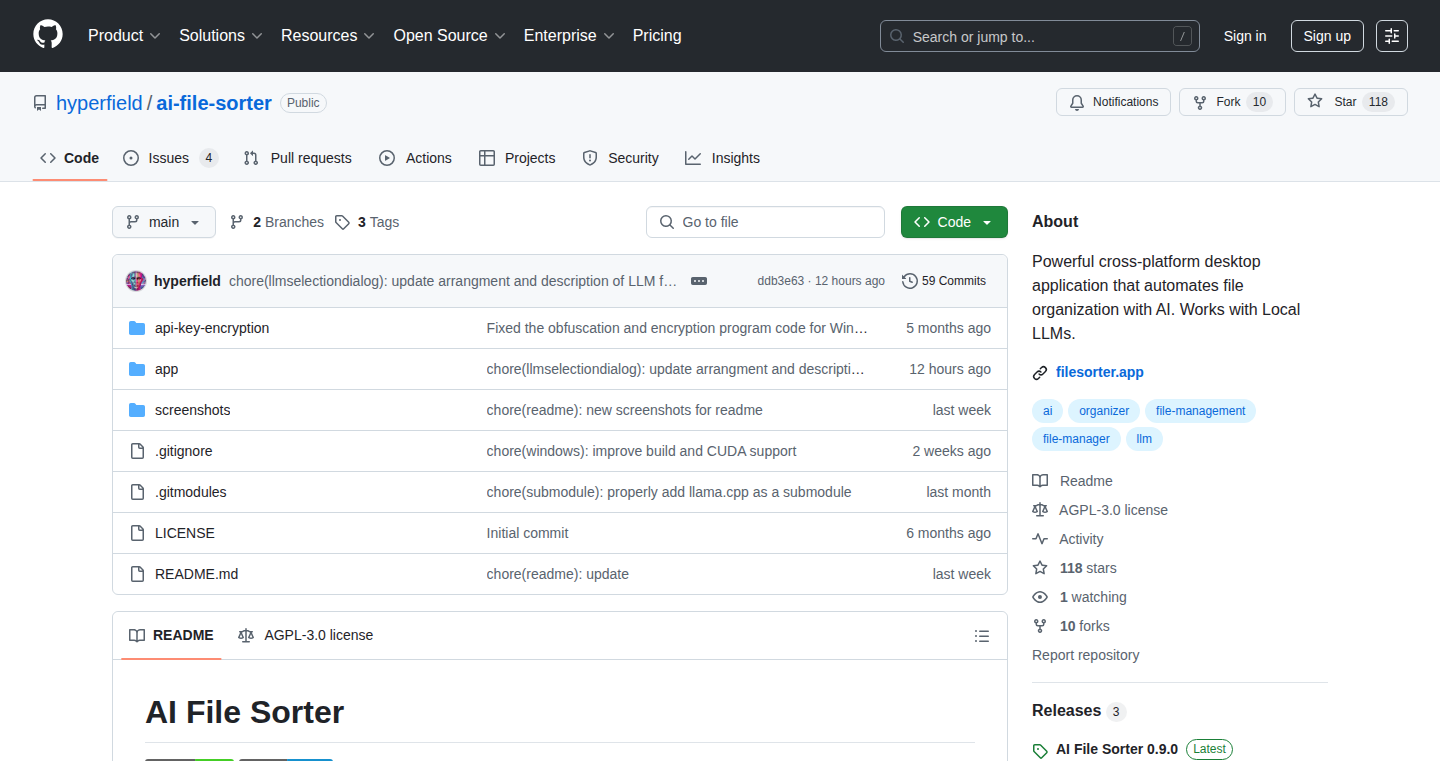
Author
hyperfield
Description
This project utilizes the power of AI, specifically leveraging Local Large Language Models (LLMs), to automatically organize your files and folders. It addresses the common problem of messy file systems by intelligently categorizing and sorting files based on their content and context. The innovation lies in its ability to perform these operations locally, ensuring user privacy and eliminating the need for cloud-based processing. So, this project provides a convenient and private way to keep your digital files well-organized.
Popularity
Points 3
Comments 0
What is this product?
This is a tool that uses Artificial Intelligence (AI) to automatically sort and organize files on your computer. It works by using a Local Large Language Model (LLM), which is a powerful AI program that understands and interprets text. When you run the tool, it examines your files, understands what they are about, and then puts them into appropriate folders. The cool thing is that all of this happens on your computer, keeping your files private. So, it’s like having a smart assistant that cleans up your digital mess. The innovation lies in its use of local LLMs, offering a privacy-focused and efficient file organization solution.
How to use it?
Developers can use this tool by downloading and running it on their operating systems (Windows, macOS, Linux). You would point the AI File Sorter at a specific folder, and it will analyze and organize the files within that folder. This can be integrated into existing development workflows, especially for managing large amounts of project files, documentation, or media assets. For instance, when working on a new project, you can use it to automatically categorize all the assets. The simplicity lies in that you just need to give the tool a folder, and it does the rest.
Product Core Function
· Intelligent File Categorization: Analyzes file content to understand what the file is about (e.g., a document about coding, an image, etc.), and then places it into an appropriate folder. This is valuable because it removes the need to manually read and organize files, saving significant time and effort. It is also great for quickly finding files later.
· Context-Aware Sorting: Considers the context of the files (e.g., file names, surrounding files) to make more accurate categorization decisions. This means the AI makes smarter decisions to keep the files more logically organized. This is valuable because it goes beyond basic keyword matching, understanding your data more accurately, so you find what you need, faster.
· Local Processing: Processes the files locally on your computer without sending any data to the cloud. It ensures the privacy of your files and avoids reliance on an internet connection. This is valuable because you do not need to upload your sensitive data and it keeps your data secure, giving you total control.
· Support for Various File Types: Capable of handling a wide range of file types, including documents, images, audio, and video files. This is valuable because the AI system can handle your diverse file collection to provide broad file organization.
· Integration with Local LLMs: Employs the use of local Large Language Models (LLMs) for analysis. This enables advanced natural language processing capabilities, improving the accuracy of categorization and understanding of file content. This is valuable because it gives a powerful AI tool that works on your computer without requiring the cloud.
· Cross-Platform Compatibility: Runs on Windows, macOS, and Linux, which makes this tool is accessible to a wide range of users. This is valuable because it provides a consistent file organization solution across different operating systems.
Product Usage Case
· Software Developers: Use the AI File Sorter to automatically organize project files, code snippets, documentation, and assets. This improves the speed and ease of finding the necessary components, ultimately saving time and boosting productivity. For example, when you have a big project with many types of files, the AI File Sorter puts everything where it belongs, so you quickly can find the right files.
· Researchers and Academics: Use it to manage research papers, datasets, and supporting documents by automatically categorizing them based on content and topics. This improves research workflows by keeping the study materials well organized for quick retrieval and review. For instance, the AI File Sorter will help you organize all your research papers with the same topic to make it easier to compare and contrast information.
· Digital Content Creators: Can be used for managing large media libraries, including images, videos, and audio files, by automatically sorting them based on their characteristics and tags. This increases efficiency of media management by making the searching and retrieval process much more convenient. For example, you can organize all images and videos of your vacations or different events, quickly and easily.
· Personal File Management: Individuals can use it to keep their personal files, photos, documents, and media organized on their local machines. This leads to easier file navigation, saving time, and making digital life more efficient. For example, you can use it to automatically sort all your pictures by event, person, or date, eliminating the need to manually sort and label thousands of photos.
30
Numbl - Daily Number Puzzle Generator

Author
henryjburg
Description
Numbl is a daily number puzzle game, blending elements of Wordle and Sudoku. The core innovation lies in its puzzle generation algorithm, which creates unique number puzzles every day. The game uses constraints (sum, odd/even numbers, ranges) to make players fill rows and columns with unique digits from 1 to 9. The creator used this project as a testbed to experiment with incorporating AI in the development workflow, demonstrating the power of AI for rapid prototyping and validation. This approach allows for faster iteration and refinement of game mechanics, without sacrificing core engineering principles. So what does this mean for you? This means a new, engaging puzzle every day, and a glimpse into how AI can speed up the creation of games and other creative projects.
Popularity
Points 2
Comments 1
What is this product?
Numbl is a daily number puzzle generator. It creates puzzles similar to Sudoku, but with the added twist of constraints. The core technology is an algorithm that generates a unique puzzle each day based on rules like row/column sums, or whether numbers are odd or even. It uses AI, specifically for rapid prototyping and validation, to help in development. So what does this mean for you? It gives you a new challenging puzzle to solve daily, and it shows how AI can be integrated into development processes to make them more efficient.
How to use it?
Players access the game on a daily basis to try the puzzle. They can also generate random puzzles. For developers, this project showcases how you can use AI tools to help in the development process. This involves rapid prototyping and validation of the puzzle rules and game mechanics without needing to outsource fundamental design or affecting the engineering process. So what does this mean for you? For players, it means a fun daily puzzle. For developers, it’s a case study on integrating AI for efficient development.
Product Core Function
· Daily Puzzle Generation: The core function is generating a new, unique puzzle every day. This is achieved through an algorithm that ensures each row and column adheres to certain rules. This ensures that players always have a fresh challenge. So what does this mean for you? You get a constantly updated puzzle, keeping the game fresh and engaging.
· Constraint-Based Puzzle Design: The puzzles are designed with constraints, such as the sum of numbers in a row or column, or rules on odd and even numbers. These constraints create more varied and challenging gameplay. So what does this mean for you? It makes for more intellectually stimulating gameplay that requires deeper strategic thinking.
· AI-Assisted Development: The developer leveraged AI tools for the process of rapid prototyping and validation of the game rules. This improves the efficiency of development. So what does this mean for you? It suggests that games, and development in general, can become quicker without sacrificing quality.
· Random Puzzle Generation: Players can generate random puzzles for additional gameplay. This extends the game's lifespan and gives more opportunities to play. So what does this mean for you? The game has much more lasting value because it can generate new puzzles on demand.
Product Usage Case
· Game Design Prototyping: This project can be used as a case study to show how to design game mechanics rapidly. You can use it to show how constraints can be added to a game to give players more of a challenge. So what does this mean for you? This helps you learn design principles and quickly iterate with game mechanics.
· AI Integration in Game Development: Developers can learn from this project about how to use AI for quick prototyping. The project helps them visualize the integration of AI into their workflow. So what does this mean for you? You can start integrating AI to make your development process more efficient.
· Algorithm Design for Puzzles: This showcases how to design algorithms to generate number puzzles. The algorithm ensures that each puzzle has a unique solution. So what does this mean for you? It helps in understanding how to create algorithms for generating puzzles or other logic-based games.
31
Property AI Tools Navigator

Author
DaniTurner
Description
This project compiles a curated list of the best AI applications specifically designed for real estate professionals. It addresses the problem of information overload by aggregating and categorizing various AI tools, saving users hours of research. The innovative aspect lies in its focus on practical, business-ready AI solutions and the continuous updating to reflect the rapidly evolving AI landscape.
Popularity
Points 1
Comments 1
What is this product?
It's a directory, think of it like a categorized shopping list, but instead of groceries, it's AI tools for real estate. It tackles the problem of finding useful AI applications by doing the research for you. The innovation is in the focused scope - only tools relevant for the real estate business are included and regularly updated. This saves you time and keeps you up-to-date.
How to use it?
You can use this by browsing the directory to find AI tools that fit your needs. Maybe you're looking to automate lead generation or improve property valuation. Just check the list for relevant AI apps. Then you can read up on the tool and try it out. You can integrate the tools recommended in the navigation into your workflow.
Product Core Function
· AI Tool Categorization: Tools are categorized by function (e.g., lead generation, property valuation). This provides an organized way for users to find specific AI solutions relevant to their real estate tasks. So what? This lets you quickly find the right tool for a specific job, saving you the time of sifting through irrelevant options.
· Curated List: The creator tests and vets tools, ensuring the list comprises reputable and business-suitable AI apps. What's the value? Reduces the risk of using unreliable or unsuitable software, providing a higher degree of trust and efficiency. It's like having a trusted advisor suggesting the best tools to use.
· Regular Updates: The list is updated regularly to include new tools and keep the resources current. What does that mean for you? You're always using the most relevant tools, no matter how fast AI changes. You won't miss out on the latest innovations or improvements.
Product Usage Case
· Scenario: A real estate agent wants to use AI to generate more leads. Using Property AI Tools Navigator, the agent can find a list of recommended AI-powered lead generation tools. This streamlines the process of discovering and comparing different software options. How this help? The agent saves hours of researching, finds the perfect tool faster, and then drives more business.
· Scenario: A property manager wants to use AI to estimate property values. By looking at the resource, they can find a selection of AI-powered valuation tools. This removes the need to sift through countless options and then simplifies finding the right solution. How does it help? The manager saves time and gets more precise estimates, and then they make better decisions.
32
API Radar: Real-time API Key Leak Detection

Author
zaim_abbasi
Description
API Radar is a tool that constantly scans public GitHub repositories to find exposed API keys from major AI providers like OpenAI, Claude, and Gemini. It solves the critical problem of leaked API keys, which can lead to significant financial loss, unauthorized access to services, and data breaches. The innovation lies in its real-time monitoring capability and the provision of a clean dashboard to visualize these leaks as they happen. It is built with Fastify for the backend, MongoDB for the database, and Next.js for the frontend, demonstrating a modern and scalable technology stack. This helps developers and security professionals to stay ahead of potential security threats. So this helps me to protect my projects and business from potential security risks.
Popularity
Points 2
Comments 0
What is this product?
API Radar works by continuously crawling public GitHub repositories, looking for patterns that match known API key formats of various AI services. When a match is found, it flags the leak and provides information about the repository where the key was exposed. The system then aggregates the leaked keys, provides a real-time feed, and generates leaderboards to identify trends and patterns. The project’s innovation is its automation and real-time monitoring of these exposures and also provide a user-friendly dashboard for monitoring. So it provides a centralized view of potential vulnerabilities.
How to use it?
Developers and security professionals can use API Radar to monitor their own API keys or the keys of their organization or clients. By integrating with the API Radar dashboard or using its data feed, users can get immediate alerts when their keys are exposed. They can also use it as a research tool to understand and mitigate security risks associated with key leaks. This allows them to react quickly, revoke compromised keys, and take preventive measures. So I can identify the exposed keys, and take proactive measures such as revoking the exposed key, which reduces the impact of security breaches.
Product Core Function
· Real-time key leak detection: Constantly scans public GitHub repositories for exposed API keys, providing an immediate alert when a leak is detected. So I can avoid the security vulnerabilities quickly.
· Full redacted and raw key display: Shows both the fully redacted key (for privacy) and the raw key (for investigative purposes, with appropriate security considerations). So I can quickly understand what keys have been exposed.
· Real-time feed of exposed repositories: Displays a live stream of repositories where API keys have been leaked, allowing users to identify the sources of exposure. So I can immediately know the source of a key leak.
· Leaderboards by author, repo, and provider: Ranks users and repositories based on the number of key leaks, highlighting the most vulnerable areas. So I can discover security hotspots and take targeted actions.
· Filtering by provider (OpenAI, Claude, Gemini, etc.): Allows users to focus on specific API providers, enabling targeted security analysis. So I can focus on the security of specific API services.
Product Usage Case
· Security audits: Security researchers can use API Radar to audit the security posture of their own projects by scanning their public repositories for accidental key exposures. This helps identify vulnerabilities before they are exploited. So I can actively maintain my project's security.
· Incident response: When a security breach occurs, organizations can use API Radar to quickly determine if any of their API keys have been leaked and to identify the affected repositories. This helps streamline the incident response process. So I can reduce the impact of the breach.
· Developer training: Developers can use API Radar as a learning tool to understand the importance of API key security and the risks of exposing keys in public repositories. This can help reinforce secure coding practices. So I can educate my team on security best practices.
33
NoteSub: Offline-First Note-Taking with Social Media Aesthetics

Author
zahirbmirza
Description
NoteSub is a web application designed as a simplified alternative to Notion, focusing on ease of use and offline functionality. It allows users to quickly create and manage notes with a visually appealing interface reminiscent of a social media feed. The core innovation lies in its ability to function offline, ensuring accessibility even without an internet connection. This addresses the common issue of needing to access notes when connectivity is unreliable. It prioritizes quick note-taking and aesthetic presentation over complex features, appealing to users who prefer a streamlined and visually-driven note-taking experience.
Popularity
Points 2
Comments 0
What is this product?
NoteSub is a web-based note-taking app that works even when you're offline. Think of it as a simplified version of Notion, designed for quick note-taking and organized in a way that looks similar to your social media feed. Its technical innovation is its ability to store and access your notes locally on your device, providing a seamless experience regardless of your internet connection. So, what's the point? You can always access your notes, and it's easy on the eyes.
How to use it?
Developers can use NoteSub to quickly jot down ideas, draft project notes, or document code snippets, even when they are on the go. It can be especially useful for brainstorming sessions when you need to work without distractions. The app's simple interface allows for rapid note entry and organization, making it easy to keep track of thoughts and ideas. To use it, simply open the web app, choose a note type, and start typing. Because it stores information locally, you don't need to worry about setup or being online. You just start using it. So, what's the point? Capture your thoughts fast and never worry about losing them.
Product Core Function
· Offline-First Note Storage: The application uses local storage in the browser (like IndexedDB or similar mechanisms) to store notes, enabling access even without an internet connection. Value: Provides continuous accessibility, ensuring data persistence and availability. Use Case: Quickly capture and review meeting notes or project progress, regardless of network conditions.
· Simplified UI/UX: The user interface is designed for simplicity, focusing on ease of note creation and organization with a social media feed-like layout. Value: Enhances user experience by reducing cognitive load and encouraging quick note-taking. Use Case: Rapidly draft ideas during a coding session, or take notes while debugging.
· No-Setup Operation: The app requires no complex configuration or user account creation, allowing users to start taking notes instantly. Value: Reduces friction for users, allowing for immediate adoption and use. Use Case: Quickly capture impromptu insights during a code review or system design session.
· Note Type Selection: Offers different note types or formats. Value: Enables users to structure notes efficiently for different types of content. Use Case: Create different types of notes for TODO lists, code snippets, documentation, and ideas.
Product Usage Case
· Developer Documentation: A developer could use NoteSub to document API calls or code snippets while working offline on a train. This way they can have access to the documentation whenever they want. So, what's the point? Access your coding documentation, anywhere, anytime.
· Brainstorming and Idea Capture: During a hackathon or design sprint, developers can use NoteSub to rapidly capture and organize ideas. Even if the Wi-Fi is down, they can take notes. So, what's the point? Quickly record ideas without any distractions or need for internet access.
· Project Meeting Notes: A project lead could use NoteSub to record meeting minutes and action items on a laptop, even in areas with limited connectivity. These notes are always available. So, what's the point? Ensure that the latest project updates are always available.
34
Roadmap: Social Anxiety Combat Simulator

Author
tolarewaju3
Description
This project transforms social anxiety into a gamified experience, allowing users to practice and overcome real-life social situations. It leverages cognitive behavioral therapy (CBT) principles by simulating anxiety-inducing scenarios and providing feedback on user responses. The innovation lies in applying game mechanics to mental health, offering a new approach to managing social anxiety through iterative practice and personalized challenges. It addresses the challenge of making mental health resources more accessible and engaging.
Popularity
Points 2
Comments 0
What is this product?
Roadmap is a simulator that lets you practice social interactions. It works like a game, putting you in situations that often cause anxiety. The core idea is that by repeatedly practicing these scenarios in a safe environment, you can build confidence and learn how to better manage your anxiety. Think of it as a workout for your social skills, using game principles to make the process more engaging and effective. So what's innovative? It's taking the science of cognitive behavioral therapy (CBT) – a proven method for anxiety – and making it interactive and fun. This approach makes mental health tools more accessible and less intimidating.
How to use it?
Developers can use Roadmap as a base or inspiration for similar mental health apps, incorporating gamification techniques and personalized challenge systems. It also allows developers to build their own simulation and create challenges with different scenarios, providing a framework to create engaging and interactive mental health tools. For instance, a developer creating an app for public speaking anxiety could adapt the scenario and incorporate elements of Roadmap for a personalized practice experience. So how can I use this? You can build your own platform that leverages the technology.
Product Core Function
· Scenario Simulation: Roadmap provides interactive simulations of social situations, letting users practice in a controlled environment. This feature is valuable because it allows users to face their anxieties in a safe space, build confidence, and develop coping mechanisms before real-life situations. It's like a virtual practice field for social skills.
· Personalized Challenges: The project could include the ability to customize scenarios and challenges based on individual needs and anxieties. This ensures a more targeted and effective practice experience. This is important as it allows users to focus on their specific triggers and address their individual anxieties effectively. So it adapts to me?
· Progress Tracking and Feedback: Roadmap would ideally track user progress, provide feedback on their responses, and offer encouragement. This helps users see their improvements over time and stay motivated. This feature helps users measure their progress. For developers: it offers the potential to incorporate data analytics and provide personalized insights, making the app more effective.
Product Usage Case
· An individual struggling with public speaking anxiety uses Roadmap to simulate a presentation, practicing delivery and handling difficult questions. This helps build confidence before an actual event. This use case helps with practicing for a meeting, a presentation, a party, or anything else.
· A developer integrates Roadmap's underlying simulation engine into a broader mental wellness app, creating a range of interactive exercises for managing various anxieties. The benefit is in providing users with diverse practice scenarios and expanding the app's functionality. For example: Imagine someone wants to learn how to talk to their crush, they can practice in the app.
35
SimpliPost: A Lean Social Media Scheduler
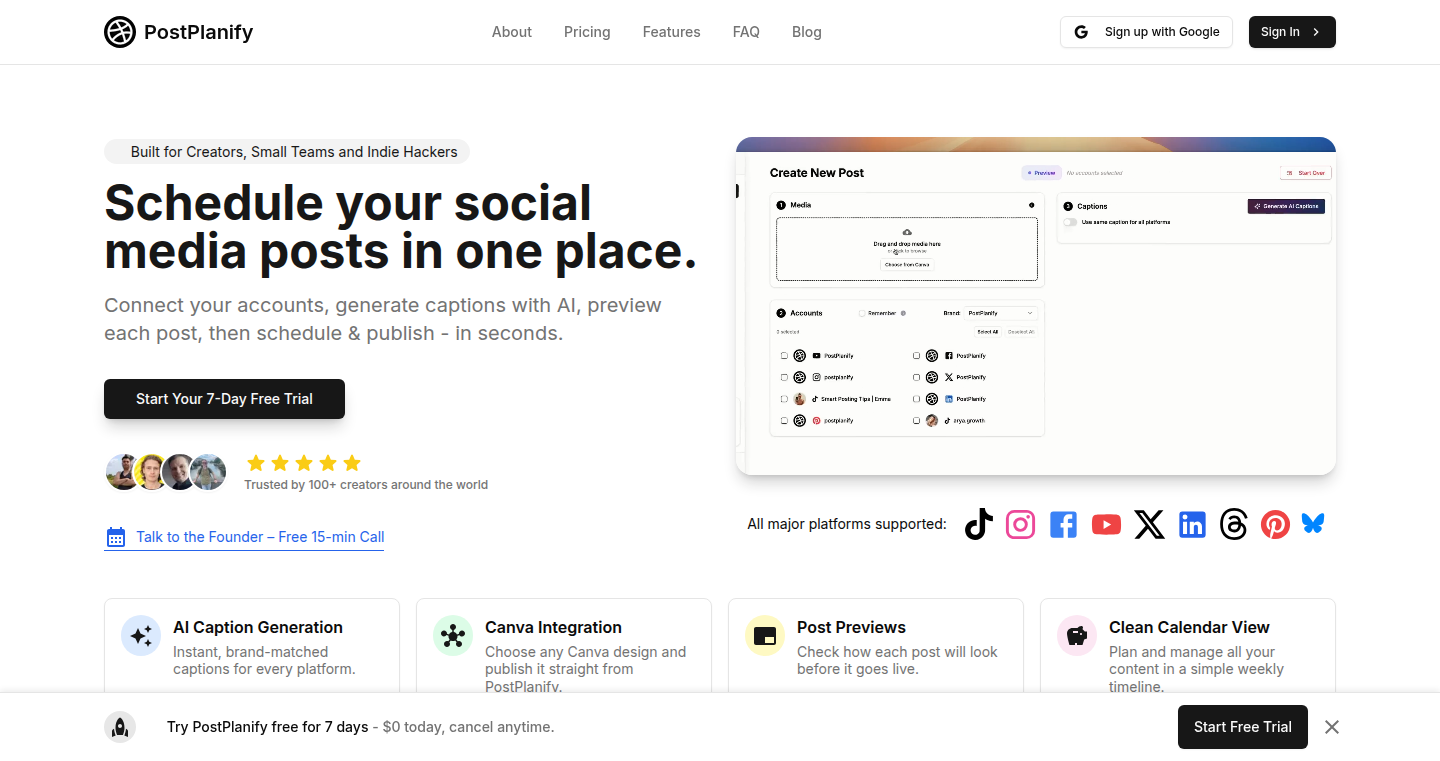
Author
hasancagli
Description
SimpliPost is a lightweight social media scheduling tool created as an alternative to bloated and expensive platforms like Buffer. It addresses the problem of over-featured and complex tools that are not suitable for solo founders and small businesses who need a simple way to schedule posts. The core innovation lies in its focus on essential features, user-friendliness, and affordability. It integrates AI-powered caption generation, Canva design integration, and multi-platform posting, providing a streamlined workflow for social media management. So, it offers a more efficient and cost-effective solution for scheduling your social media content.
Popularity
Points 2
Comments 0
What is this product?
SimpliPost is a simplified social media scheduler designed to solve the problem of paying for features you don't use. It allows users to schedule posts across multiple platforms (Instagram, TikTok, LinkedIn, X, Facebook, etc.), generate captions using AI, and integrate with Canva for easy design integration. The technical principle is based on automating the posting process through API integrations with various social media platforms and utilizing AI models for content generation. The innovation lies in its simplicity, focused feature set, and the integration of different services to create a seamless experience. So, it gives you a simple tool to schedule your posts and it's tailored for single users and small businesses.
How to use it?
Developers can use SimpliPost to easily schedule posts on their own social media accounts or for clients. You can integrate it into your marketing workflow by connecting your social media accounts, creating content (either manually or using the AI caption generator), designing visuals in Canva, and scheduling posts for future dates. The project also offers a good starting point for developers looking to understand how to interact with social media APIs or create their own scheduling tools. So, you can automate your social media content to save time.
Product Core Function
· Multi-Platform Scheduling: The core function is scheduling posts across various social media platforms. This feature is valuable because it eliminates the need to manually post to each platform, saving time and effort. It's applicable to any business or individual needing a consistent social media presence, as it simplifies the management of multiple accounts.
· AI-Powered Caption Generation: This feature leverages AI to generate captions for posts. The technical value is in automating the content creation process, freeing up users from brainstorming and writing captions manually. This is useful for users who want to quickly generate content and are looking for content inspiration, and for users who don't want to spend too much time generating content.
· Canva Design Integration: SimpliPost integrates with Canva, allowing users to easily import designs for their social media posts. This has the value of making the process of creating visually appealing content easier, which is important for attracting engagement on social media. It's especially useful for users who heavily rely on visual content, because they can use Canva to create and design visual content easily.
· Affordable Pricing Model: The product's cost-effectiveness addresses the problem of expensive social media scheduling tools. This is valuable for small businesses or solo users who need a solution that fits their budget. It allows them to access essential features without overspending, which is essential for businesses with restricted budgets.
Product Usage Case
· Small Business Owner: A small business owner can use SimpliPost to schedule product announcements, promotional content, and updates across multiple platforms, saving valuable time and improving their marketing efficiency. This is very useful for saving time so you can focus on the core functions of your business.
· Freelancer: A freelancer managing multiple social media accounts for clients can use SimpliPost to streamline their workflow. They can easily create, schedule, and post content across various platforms, improving their efficiency and allowing them to manage more clients. This is very useful for freelancers who need to be efficient in order to maintain multiple clients.
· Content Creator: A content creator can use SimpliPost to schedule their content in advance, ensuring a consistent posting schedule and maximizing their reach. The AI-powered caption generation can help brainstorm content ideas, which leads to more content ideas for posting.
36
PixelPerfect: Adaptive Image Compression Engine
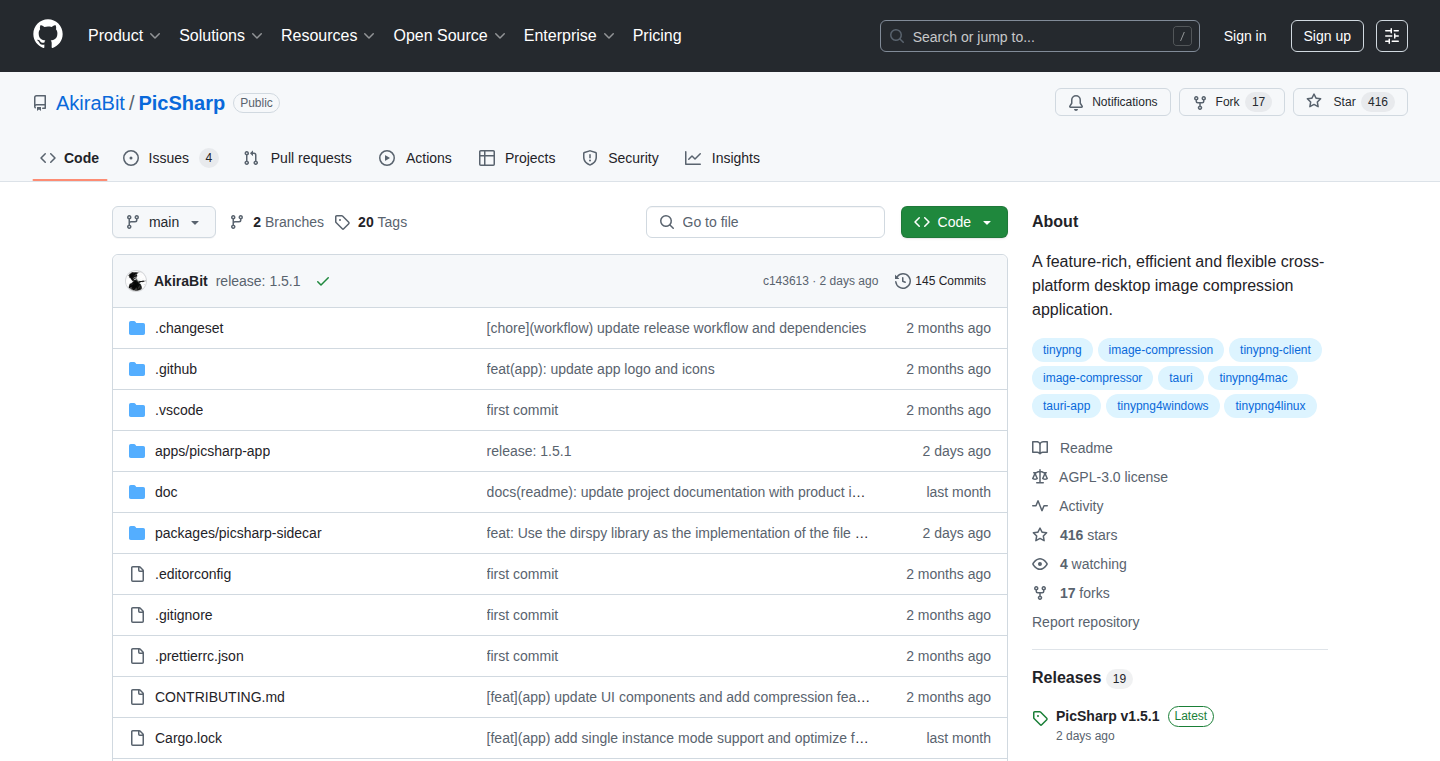
Author
AkiraBit
Description
PixelPerfect is a new image compression application designed for efficiency, flexibility, and rich features. The project focuses on optimizing image size without sacrificing visual quality, addressing the common problem of large image files slowing down web page loading times and consuming excessive storage space. It uses adaptive compression techniques to tailor the compression strategy to the specific image content, resulting in potentially significant file size reductions while maintaining a good visual experience. The main innovation lies in intelligent content analysis and dynamic adjustment of compression parameters. So this helps to make your websites load faster and save storage space.
Popularity
Points 2
Comments 0
What is this product?
PixelPerfect intelligently analyzes image content, such as textures, colors, and details, to determine the most effective compression settings. This means it doesn't use a one-size-fits-all approach; instead, it adapts to each image. It employs techniques like wavelet transforms and entropy encoding, common in image compression, but with an added layer of intelligence to optimize these methods based on the content. This results in more effective file size reduction compared to generic compression tools. So this allows for smaller image files without a noticeable loss of quality.
How to use it?
Developers can use PixelPerfect as a command-line tool or potentially integrate it into their web development workflows. For example, it can be run before deploying images to a website, automatically compressing them. Or, if integrated into a content management system (CMS), images uploaded by users could be automatically optimized. The application could also be used as part of an image processing pipeline for applications dealing with large image datasets. So it is easy to use to improve the performance of websites and applications.
Product Core Function
· Adaptive Compression: The core function is the adaptive compression algorithm. This intelligently analyzes image content and adjusts compression parameters, such as quantization levels and entropy encoding methods, to achieve optimal file size reduction while maintaining visual quality. This saves bandwidth and speeds up web pages.
· Format Support: It supports a range of image formats (like JPEG, PNG, and potentially WebP) for compression and optimization. This versatility ensures compatibility with different web development needs and image sources. So it handles different image types.
· Batch Processing: Allows users to compress multiple images at once, which is useful when needing to optimize an entire folder of images for a website or application. So you can save a lot of time processing images.
· Quality Control: Offers a level of control over the compression quality through configuration settings, providing a balance between file size and visual fidelity. This lets you decide how important image quality is.
· Metadata Preservation: Preserves important image metadata such as EXIF data, which includes camera settings, date taken, and other important information. So you don't lose extra information about your images.
Product Usage Case
· Web Development: A web developer uses PixelPerfect to optimize images for their website. By reducing file sizes, the website loads faster, improving user experience and search engine ranking. This makes the website more user-friendly and more visible online.
· E-commerce Platforms: An e-commerce platform uses PixelPerfect to compress product images. Reduced image sizes lead to faster page loading times, improving customer shopping experiences and potentially increasing sales. This leads to increased customer satisfaction and sales.
· Content Management Systems (CMS): A CMS integrates PixelPerfect to automatically compress uploaded images. This ensures that all images on the website are optimized, reducing storage space and bandwidth usage. So it helps CMS to manage images automatically.
· Image Libraries: A developer builds a digital image library using PixelPerfect to store and serve images. The application optimizes images for storage efficiency and bandwidth use. This makes the images easy to store and share.
· Mobile App Development: A mobile app developer uses PixelPerfect to optimize image assets for their app, reducing the app size and improving performance. The app becomes faster and less storage-intensive.
37
ArticleThread: Seamless News Discussion Overlay

Author
itzoen
Description
ArticleThread is a browser extension and website that allows users to discuss news articles directly on the article's original page, similar to Reddit. It solves the problem of disconnected discussions by integrating comments into the reading experience. The core technical innovation is an overlay that displays comments alongside the article content, providing context and facilitating real-time discussion.
Popularity
Points 2
Comments 0
What is this product?
ArticleThread is a system that merges news articles with related discussions. It works by using a browser extension that recognizes when you are viewing a supported news article. The extension then overlays a comment section, pulled from the ArticleThread website, directly onto the article page. This is like having Reddit comments appearing right next to the news. The technical principle involves identifying the article URL, fetching the relevant comments from a centralized server, and rendering them as an overlay on the page. So this is useful because you don't need to switch between article and comment sections.
How to use it?
Developers can use ArticleThread by installing the browser extension and visiting supported news websites. The extension will automatically identify articles and display related discussions. They can also use the ArticleThread website to browse and participate in discussions. Furthermore, developers can leverage this approach to build their own content-integrated discussion platforms, using the extension as a model for overlaying content-specific discussions. So, you can integrate discussions directly into your reading experience.
Product Core Function
· Browser Extension Overlay: Displays comments on the article page. This is a powerful function because it eliminates the need to switch between a news article and a comment section. It streamlines the reading and discussion experience. It is useful for quickly getting context from others while you're reading.
· Centralized Comment Database: Stores and manages user comments, which is the backbone of how the discussions are served. This ensures comments can be accessed from different browsers. It is a great tool because it allows all comments to be accessed everywhere you go.
· URL Matching: Uses URL matching to identify news articles and link them to the appropriate comments. This is a good function because it helps ensure discussions align with the correct content. It's useful because it is a quick way to see relevant comments.
· Real-time Comment Updates: Refreshes comments in real-time, keeping the discussion current. This keeps the conversation fresh and dynamic. It's useful to keep up with the latest discussions and have all the needed information.
Product Usage Case
· News Aggregators: News aggregators can use this as a template to integrate discussions directly into their articles to increase user engagement and offer a more immersive reading experience. In the end, more users can enjoy your platform and see all the information in a more streamlined way.
· Educational Platforms: Educational platforms can apply this to provide comments to academic articles. This can enhance learning and help students understand content faster. So in the end, the learning becomes more efficient and can give the students more information.
· Content Creation Tools: Content creators can use this to build a platform around specific topics for community engagement. This provides an interactive way to show discussions and build a community. So, you can build a platform where your audience can always engage.
38
ctx: Git-Powered Context Manager for LLMs
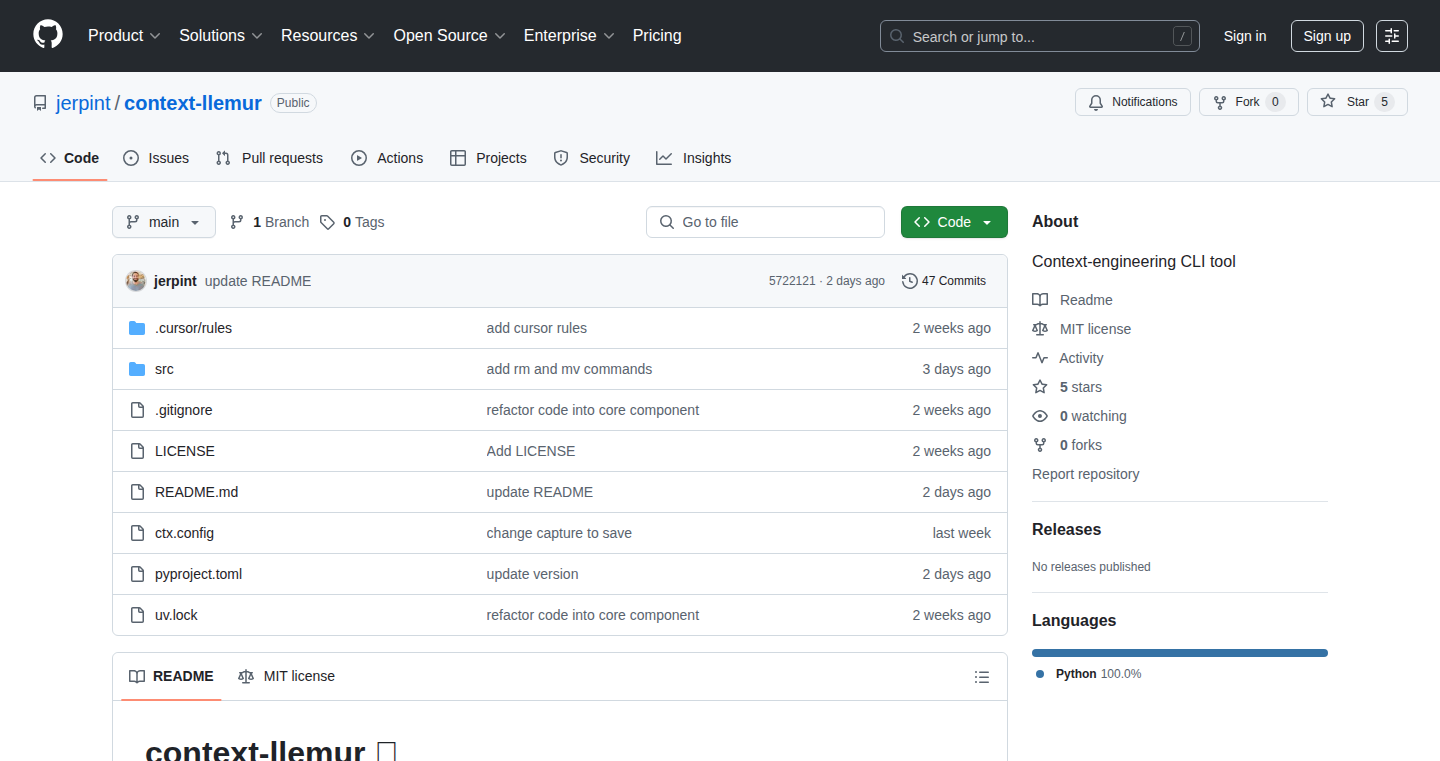
Author
jerpint
Description
ctx is a clever tool that solves the problem of constantly re-explaining your project and goals to AI language models (LLMs) like Claude or Cursor. It uses Git, the version control system beloved by developers, to manage and track the context of your work. Instead of repeatedly feeding your AI the same information, ctx allows you to create a 'context' for your project, save it like you save code, and load it instantly whenever you interact with an LLM. This boosts efficiency, saves time, and makes AI tools more helpful.
Popularity
Points 2
Comments 0
What is this product?
ctx is a context manager for LLMs, built on Git. When you work with an LLM on a project, you often need to provide the same context – the goals, the project's state, your preferences – over and over again. ctx automates this. It works by creating a Git repository for your context data. You can then save updates to this context using simple commands. When you want to use your context, you just 'load' it, and the LLM immediately has all the necessary information. The core innovation is using Git's version control for context, making it easy to track changes, revert to previous versions, and ensure the LLM always has the most up-to-date information. It uses simple text files, avoiding complex techniques like embeddings or vendor lock-in, and works smoothly with popular LLM tools.
How to use it?
Developers can use ctx in any situation where they interact with LLMs to work on projects, such as writing code, debugging, or brainstorming. First, you create a new context with 'ctx new', which sets up a Git repository. Then, as you make progress, you can save updates with 'ctx save 'progress update''. When you need your context in your LLM tool, just use 'ctx load'. ctx also integrates with LLM tools like Claude Desktop and Cursor. It utilizes a built-in MCP server, ensuring compatibility with a wide range of AI tools.
Product Core Function
· Creating and Managing Context Repositories: 'ctx new' initializes a Git repository for your project's context. This helps to organize your project's goals, preferences, and project state information, so you can quickly set the scene when starting a project with an LLM. So what? Save you time and ensure consistency, giving the LLM the right background context.
· Saving and Versioning Context: 'ctx save 'progress update'' versions your context like code. This function records the project's state at different points in time. So what? This ensures a consistent context that you can then review, update, and recall specific contexts as you work on different stages of a project.
· Loading Context into LLMs: 'ctx load' instantly provides the LLM with your full context. This gives your LLM the information it needs to work on the project. So what? Enables the LLM to perform better and saves the time it takes to explain a project.
· Built-in MCP Server: Integrates with tools like Claude Desktop and Cursor. This enables broader compatibility. So what? This makes the functionality of ctx easier to use and accessible across a variety of tools.
· Context Explanations: Each context folder includes ctx.txt. So what? This allows the LLM to understand how the context works, thus improving its performance.
Product Usage Case
· Code Generation: A developer is using an LLM to generate code for a new feature. They use 'ctx new' to create a context for the project, and then they use 'ctx save' to update their context with the requirements of the feature. When the developer uses the LLM, they just use 'ctx load', giving the LLM all the specifications and information. The LLM can use this information to generate better code. So what? Saves time by providing context quickly and ensures the generated code meets the requirements.
· Debugging: A developer is using an LLM to debug a complex piece of code. They use 'ctx new' to create a context with details of the bug and the current project status. They then use 'ctx save' to record each attempt to solve the issue. When debugging with the LLM, they use 'ctx load' to give the LLM the entire history and context of the bug. So what? Improves debugging by providing the LLM with the relevant background information, and enables faster bug fixes.
· Project Planning and Brainstorming: A project manager uses an LLM to brainstorm project strategies. They use 'ctx new' to set the project’s goals and then update the context with notes and preferences. When brainstorming with the LLM, the project manager uses 'ctx load' to give the LLM the project overview. So what? Enhances brainstorming sessions by providing a structured context and helps generate informed ideas.
39
Souko.ai: AI-Powered Web Data Extraction API
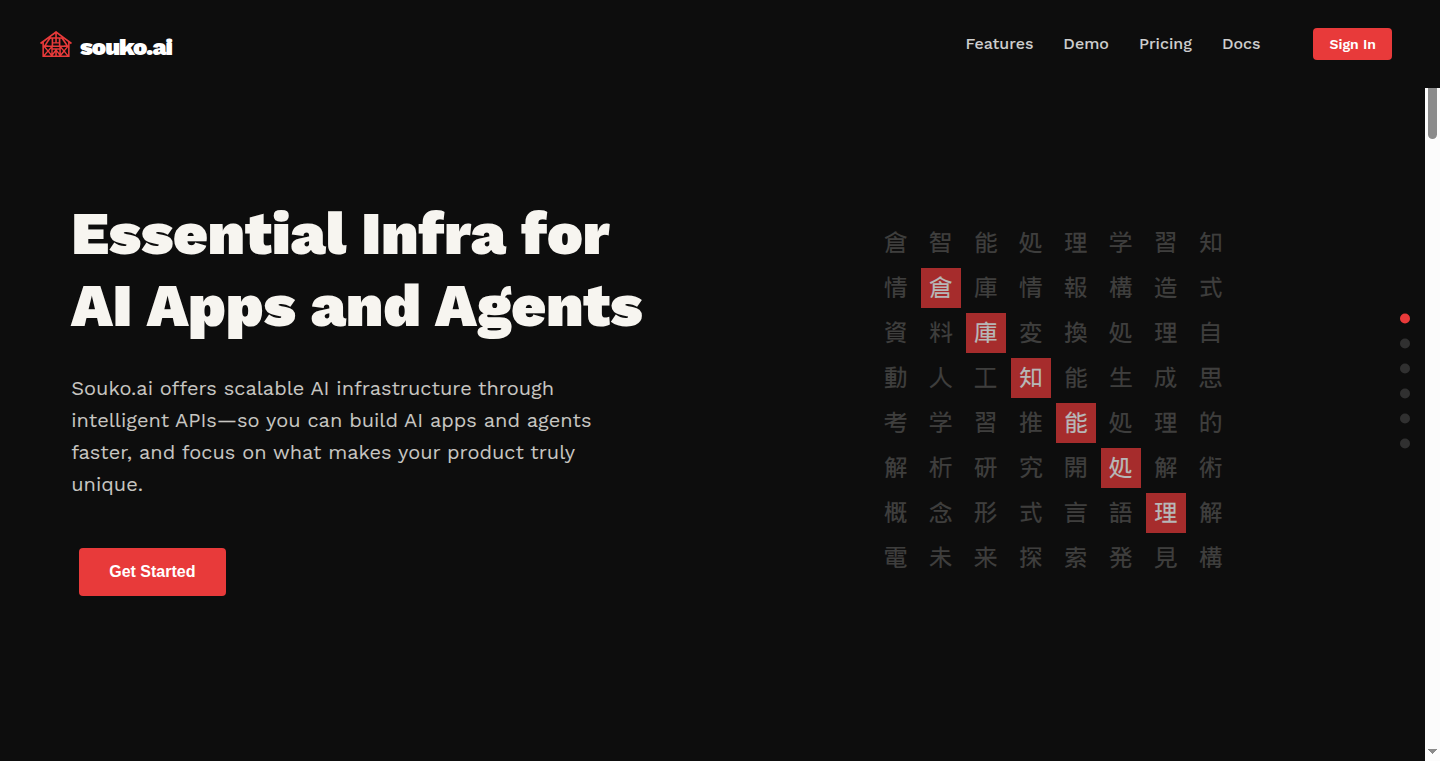
Author
ylian
Description
Souko.ai is a web scraping and data extraction tool designed to provide clean, structured data from any webpage for AI applications. It tackles the common problem of messy data from the web that wastes resources and hinders the performance of AI models. Its key innovation lies in combining web search and data extraction into a single API call, delivering LLM-ready data efficiently. This simplifies the process of finding and cleaning web data, saving developers time and resources. So this simplifies your AI development workflow and makes your models more reliable.
Popularity
Points 2
Comments 0
What is this product?
Souko.ai is like a smart data retriever from the internet. It uses AI to understand what kind of information you need from a webpage, extract it, and organize it into a clean, usable format (like Markdown, structured data or metadata) for your AI tools. The system is built to handle complex websites with JavaScript, ensuring the data is consistently formatted. It also has a built-in search feature that finds the relevant web pages for you, then extracts the information. So, it helps get reliable data for AI projects.
How to use it?
Developers can use Souko.ai via its API. You provide a search query and/or a webpage URL, along with instructions on what data you want to extract (using natural language or a JSON schema). The API returns clean, structured data that can be directly fed into an AI model. You can easily integrate it into your AI pipelines to automate data gathering and cleaning. This significantly reduces the work required to get useful information from the internet. So, it helps you automate the process of collecting and preparing data for your AI models.
Product Core Function
· AI-powered extraction with natural language queries: Allows developers to specify data extraction requirements in plain English, making it easy to get the right data. So, you don't need to learn complex code.
· Structured data output: Provides data in a pre-formatted, machine-readable format, like JSON, which is ideal for AI models. So, you get data your AI can use immediately.
· Web search combined with data extraction: Find relevant websites and extract the necessary data with a single API call. So, this saves time by reducing the need for separate search and scraping steps.
· Handles JavaScript-heavy websites: Can successfully extract data from websites that use complex JavaScript and dynamic content loading. So, you get the right data from almost all the websites.
· Focus on clean output and reduced token usage: The service aims to deliver data without unnecessary 'noise,' conserving LLM tokens and processing resources. So, it helps you save money on your AI project costs.
Product Usage Case
· Building a price comparison tool: A developer can use Souko.ai to search for product pages, extract pricing information and compare prices across different websites. So, you can easily build your price comparison app.
· Creating a news aggregator with structured data: A developer can use the tool to extract specific news headlines, summaries, and publication dates from news websites and automatically structure them for an AI-powered content curation system. So, it streamlines the process of collecting news data.
· Training an AI model on product reviews: By extracting and structuring product reviews from various e-commerce sites, developers can easily train AI models for sentiment analysis and improve recommendation systems. So, you can quickly gather data to train your AI to understand customer opinions.
· Automating market research: Developers can automate the extraction of market data, such as competitor information or industry trends, from various online sources. So, you can streamline your market analysis efforts.
40
FreelanceRateCalc: A Simple Expense-Aware Rate Calculator

Author
daniellax
Description
FreelanceRateCalc is a straightforward rate calculator designed to help freelancers determine their hourly or daily rates, taking into account their working days and expenses. The core innovation lies in its simplicity and direct approach, allowing users to quickly estimate a fair rate without getting bogged down in complex spreadsheets. It solves the common problem of freelancers undercharging for their services by providing a clear picture of their costs and desired profit margins.
Popularity
Points 2
Comments 0
What is this product?
This project is a web-based rate calculator specifically for freelancers. Its technical core is a simple algorithm that takes your desired income, working days, and expenses, and calculates the rate you should charge. The innovation here isn't groundbreaking technology, but the focus on user-friendliness and accessibility. It provides a quick way to get a realistic rate. So what does this mean to you? It is a faster way to figure out how much to charge for your work, ensuring you get a fair compensation.
How to use it?
You can access FreelanceRateCalc through a web browser. You would input data like how many days you plan to work in a month, what your desired income is, and your expected expenses. Then, the calculator does the math and gives you an hourly or daily rate. This is great for any freelancer trying to quote their projects. So what's the implication? You can use this calculator to quickly create a fair invoice and improve your financial stability.
Product Core Function
· Expense Input: The calculator allows users to enter their monthly expenses. This includes costs like software subscriptions, equipment, and marketing. The value is in understanding your real costs, so your pricing reflects your business's actual needs. For example, if you spend a lot of money on tools and subscriptions, this feature ensures you factor those in.
· Workday Input: Users input the number of working days per month. The function is to calculate the rate depending on how many days you plan to work, allowing to make sure you receive your target income. Suppose you work 20 days a month. This will then let you adjust your pricing strategy.
· Income Target: The calculator has a section for your desired monthly income. The technical concept allows you to reach your financial goals by setting a realistic income target. For example, if you want to make $5000 a month, the calculator helps you to achieve that, ensuring you are making a profit.
· Rate Calculation: The system takes the income target, expenses, and working days, and then spits out the hourly or daily rate. The value here is simple: it tells you the amount you need to charge to cover costs and make a profit. For instance, if you spend $1000 on expenses and you want to make $5000 a month, it calculates your hourly or daily rate to meet your goals.
Product Usage Case
· Freelance Web Developer: A web developer who uses this calculator can quickly figure out their hourly rate for a new client. They can input their monthly expenses (e.g., software licenses, internet), the number of workdays, and their desired income. This way, they provide accurate quotes quickly and ensure they get paid fairly.
· Graphic Designer: A graphic designer uses the calculator to price a logo design project. They include expenses for design tools, fonts, and marketing. By incorporating the cost of running their business, they calculate the appropriate project fee based on their time to complete a project and ensure they're compensated for their expertise.
· Content Writer: A content writer can utilize the calculator to price an article writing service. They input their expenses for research, writing tools, and the time spent to finish the article. This helps them calculate the required rate to charge their clients, including their cost and the desired income.
· Project Manager: A project manager can use this to calculate a day rate for a client. The inclusion of overhead and desired profit ensures fair compensation for their work. This ensures they are paid for their project management skills and responsibilities, covering their time and associated project costs.
41
Draggy: Clipboard-to-Drag & Drop Utility

Author
nberkman
Description
Draggy is a clever utility designed to simplify file transfers by allowing users to drag files directly from their clipboard to any application that accepts drag-and-drop. It addresses the common problem of needing to upload files downloaded via the terminal, which often requires switching between windows and breaking workflow. It works seamlessly with other tools like 'clippy' and 'pasty', providing a powerful suite for terminal file management. The core innovation lies in intercepting clipboard data and enabling it to behave like a file, making file transfer effortless.
Popularity
Points 2
Comments 0
What is this product?
Draggy is a menu bar application that extends the functionality of the clipboard. When you copy a file path or a file itself using tools like 'clippy' (a terminal-based file copier), Draggy makes that file available as a draggable item. Instead of navigating through file explorers, you can simply click the Draggy icon in the menu bar and then drag the copied file directly into any application that accepts drag-and-drop, such as web upload fields, Slack, or email. The innovation is turning the clipboard into a source for drag-and-drop operations, streamlining the process of transferring files from the terminal or other applications to where you need them. So this is useful because it saves time and reduces the number of steps needed to upload files.
How to use it?
Developers can use Draggy in conjunction with command-line tools like 'clippy'. First, install Draggy via Homebrew. Then, use 'clippy' to copy files from the terminal. After copying a file, click the Draggy icon in the menu bar; your clipboard contents are now represented by a draggable icon. Drag this icon to any application that accepts file uploads. For example, if you download an image using 'curl' in the terminal and then copy it using clippy, you can use Draggy to drag the image directly into a web form. So this allows you to easily integrate command-line operations with GUI applications.
Product Core Function
· Clipboard Monitoring: Draggy constantly monitors the system clipboard for file-related data. It detects file paths or file contents copied to the clipboard.
· Drag-and-Drop Enabling: When file-related data is detected, Draggy transforms the clipboard content into a draggable item. It uses system APIs to simulate a drag-and-drop operation.
· Menu Bar Integration: Draggy resides in the menu bar, providing a convenient access point for initiating drag-and-drop operations. Clicking the icon activates the drag functionality.
· Integration with clippy/pasty: Draggy complements tools like clippy and pasty by providing a drag-and-drop interface for files copied through these command-line utilities. clippy allows copying files from the terminal to the clipboard, and pasty lets you paste a file in Finder, so you can then use Draggy to put the file in a web upload.
· Interactive Recent Downloads Picker: The 'clippy -i' flag allows the user to select from recent file downloads, enhancing user experience and workflow efficiency.
· Server Integration with MCP (Message-passing-channel): Enables the use of Draggy with an MCP server, for example, Claude Code can directly place text in your clipboard which is compatible with Draggy.
Product Usage Case
· Web Upload Automation: A developer downloads a file using 'curl' in the terminal. Using 'clippy', they copy the file to the clipboard. Draggy then lets them drag the file directly into a web form for uploading. So this simplifies the upload process compared to manually locating and selecting the file.
· Slack File Sharing: A developer copies a screenshot to the clipboard. Draggy allows them to drag the screenshot directly into a Slack message to share with colleagues. So this simplifies the image sharing process.
· Email Attachment: A developer uses 'clippy' to download a PDF file from the terminal. They then use Draggy to drag the file directly into an email as an attachment. So this streamlines attaching files to emails.
· Integration with IDEs: A developer uses command line tools to manage code files, and Draggy makes it easy to drag and drop files into an IDE for editing or version control. So this makes it easier to move files between terminals and editors.
42
ts-explicit-errors: Error Handling as Values in TypeScript

Author
genshii
Description
ts-explicit-errors is a TypeScript library that fundamentally changes how you handle errors in your code. Instead of relying on the traditional try-catch blocks (which can sometimes be tricky to manage), this library allows you to treat errors as regular values. This approach enables more predictable and composable error handling, making your code more robust and easier to reason about. It tackles the common problem of implicit error handling leading to difficult-to-debug issues.
Popularity
Points 2
Comments 0
What is this product?
This library introduces a way to explicitly represent errors in your TypeScript code. Essentially, functions can return either a successful result or an error object, both clearly defined as types. This means instead of errors being thrown and caught, they become part of the function's return value. The core innovation is converting the error-prone side effect of exceptions into a predictable, type-safe data structure. So, this makes error handling more explicit and easier to manage, enhancing code clarity and preventing subtle bugs.
How to use it?
Developers integrate ts-explicit-errors by wrapping functions that could potentially fail. Instead of throwing an exception, these functions return a special type (often called a 'Result' or 'Either' type) containing either the successful result or an error. You then write code to handle both possibilities, which are statically typed and easily verifiable by the TypeScript compiler. This promotes a functional programming style for error management. So, it works by changing the return type of your functions to include the potential of errors, letting you handle them systematically.
Product Core Function
· Result Type: This core feature introduces a 'Result' type (or similar) that encapsulates either a successful value or an error. It's a fundamental concept, ensuring that every function explicitly signals whether it succeeded or failed. Application: Prevents unchecked errors and offers type-safe guarantees during development.
· Error Propagation: The library provides mechanisms to propagate errors up the call stack. If one function returns an error, the calling function can easily handle or propagate it without complex exception handling. Application: Simplifies complex workflows, reduces the chance of unexpected errors getting lost, and makes debugging easier.
· Error Transformation: Enables transforming errors into other types or formats for easier handling in different contexts. You might translate internal errors to user-friendly error messages. Application: Improves user experience and lets developers handle error messages in a centralized way.
Product Usage Case
· API Client Development: In building an API client, every network request might fail. Using ts-explicit-errors, you can make your `fetch` function return a 'Result' that either contains the API response or an error indicating the reason for failure (e.g., network timeout, server error). This forces the developer to explicitly handle all possible failure scenarios, preventing unexpected bugs and making the code more robust. So, you have much safer network requests.
· Data Validation: When validating user inputs, you can return a 'Result' that either includes the validated data or an error object containing details about the validation failures (e.g., invalid email format, missing required fields). This makes it easy to create a well-structured error response and report issues to the user accurately. So, you can write cleaner validation code, especially for web forms.
· Asynchronous Operations: For complex asynchronous operations, where failures can occur at any step, you can create a 'Result' for each step. This improves readability by avoiding nested `try-catch` blocks and makes it simple to debug each part of a complex task. So, debugging becomes much easier, and you can handle many failures with a clear pattern.
43
Symvol: AI-Powered Code Explainer Videos
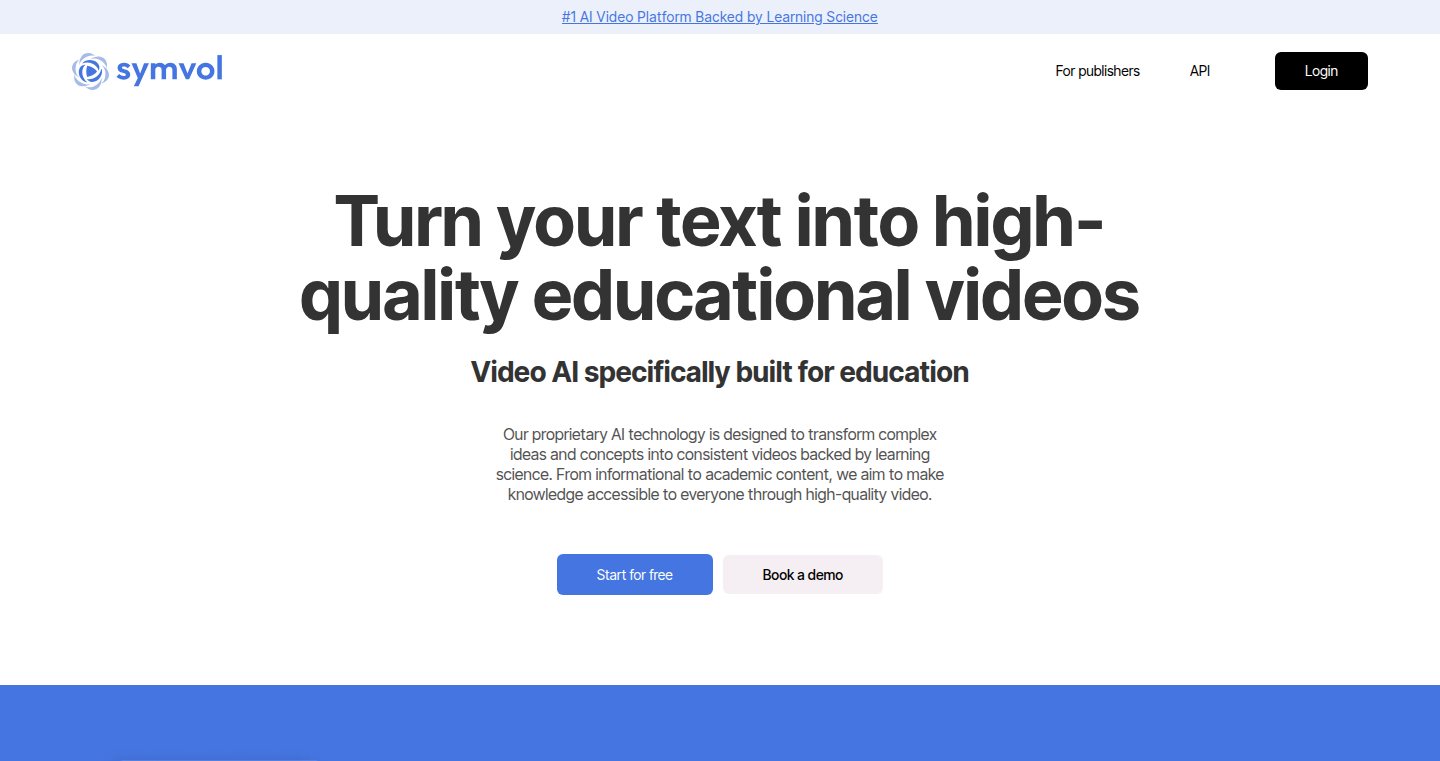
Author
feliks22
Description
Symvol transforms technical documents into AI-narrated videos in about a minute. The innovation lies in its ability to keep code blocks interactive; viewers can click to copy and run code snippets directly within the video. This solves the common problem of static documentation by making it dynamic and engaging, especially for learning and understanding technical concepts. So what's the use? It makes learning technical subjects much easier and faster.
Popularity
Points 2
Comments 0
What is this product?
Symvol uses AI to analyze a tech document (like a PDF or webpage) and generate a video explainer. The core technology intelligently identifies code blocks, ensuring they remain interactive within the video. Think of it as a smart video creator that understands code. So, this helps by making complex technical documents more accessible and interactive.
How to use it?
Developers can use Symvol in several ways. Upload a PDF of a technical document to their website, or use their Chrome extension to process any webpage. This allows them to quickly create video explanations of their code, libraries, or API documentation. This improves the documentation quality and user understanding of the technology.
Product Core Function
· AI-Powered Narration: Symvol generates an AI-driven voiceover that explains the technical content. This adds an interactive element to your content, making complex topics more digestible. This is useful for creating documentation for your projects, tutorial videos, or internal training materials.
· Interactive Code Snippets: Code blocks within the source documents remain clickable and copyable during video playback. This means viewers can copy and paste code examples directly from the video. This is very helpful for developers who are trying to learn something new because they can see and use examples on the go.
· Automated Video Generation: Symvol automates the video creation process, significantly reducing the time and effort required to create explainers. This is great for rapidly creating training or explaining project architecture quickly.
Product Usage Case
· Software Library Documentation: A software library developer can use Symvol to create video tutorials demonstrating how to use the library’s API, including interactive code samples. This makes it easier for developers to adopt and use the library.
· Technical Blog Posts: A technical blogger can use Symvol to create dynamic video explainers for their blog posts, allowing readers to better understand the concepts and interact with code samples directly. This results in improved engagement and helps drive visitors to your site.
· Internal Training: Companies can use Symvol to create training videos for their developers, explaining complex codebases and internal tools. This helps reduce training time and ensures new hires can quickly start contributing.
44
RunAgent: Universal AI Agent Deployment Platform
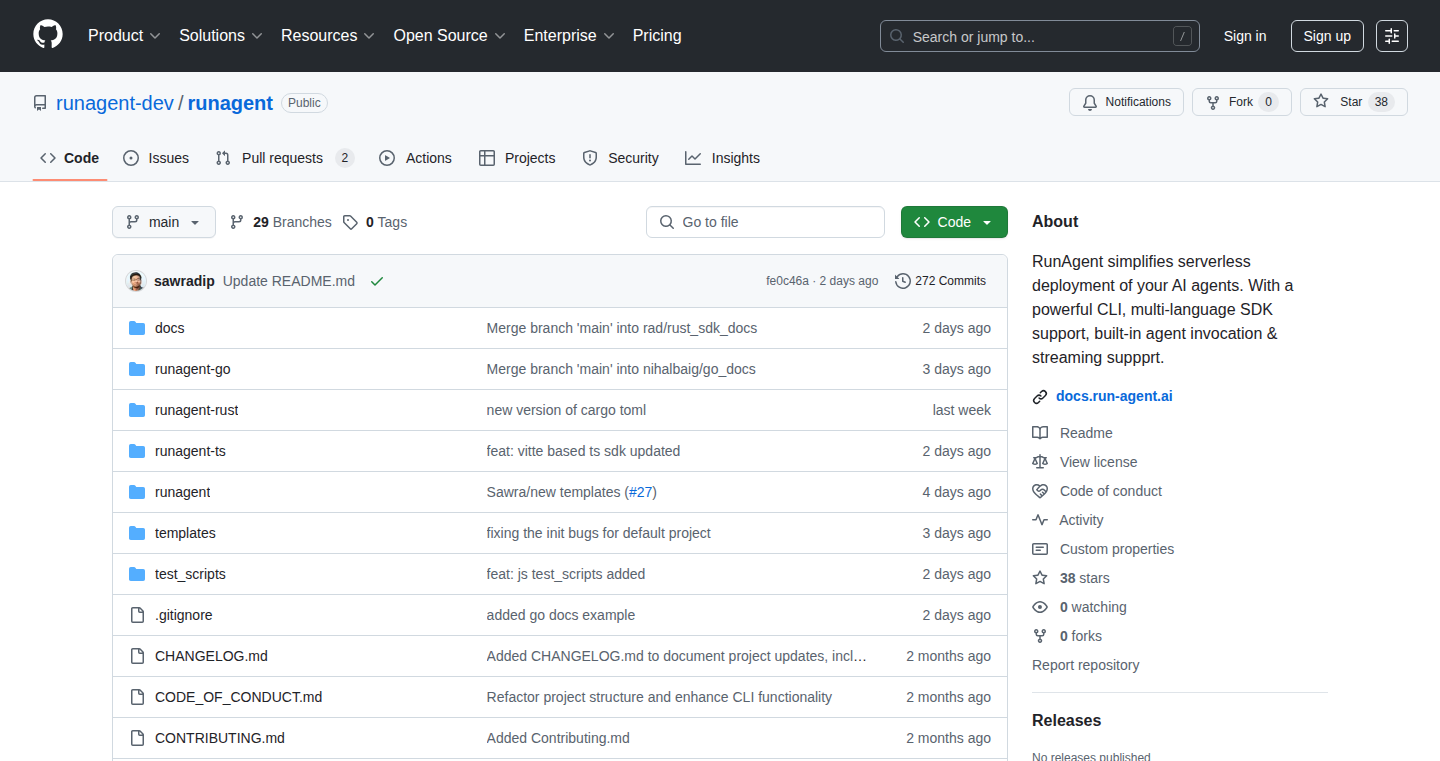
Author
adewba
Description
RunAgent is a platform that allows developers to create AI agents in Python (using frameworks like LangChain) and then seamlessly use them from other programming languages such as Rust, JavaScript, or Go. It solves the common problem of AI agent development being locked into specific languages and complex deployment processes. The innovation lies in a framework-agnostic entrypoint system and comprehensive SDKs. This means developers write the agent once in Python and deploy it with a simple command. Then, they can call the agent as if it were a native function in their chosen language, removing the language barrier. The project is open-sourced, aiming to foster community-driven development and make AI agents accessible across various programming languages. So what does this mean for you? It means you can leverage powerful AI tools without being limited to Python and simplify AI agent deployment, saving you time and effort.
Popularity
Points 2
Comments 0
What is this product?
RunAgent is like a universal translator for AI agents. It allows you to build an AI agent in Python, the most common language for AI development, and then use that agent directly in other languages, like Rust or JavaScript. The core technology is an entrypoint system where developers provide a configuration file and their agent code. RunAgent then handles the complexities of deployment, creating SDKs (Software Development Kits) in multiple languages. These SDKs allow developers to call the deployed AI agents as if they were native functions within their code. This removes the need to rewrite AI agents for different languages, which is a huge time saver. Think of it as 'MCP for Agent Deployment': Just as MCP standardized model context, RunAgent standardizes agent deployment and cross-language accessibility. The open-source nature promotes community-driven development, allowing developers to share and reuse agents easily. So what is the value? It helps engineers to easily integrate AI agents into existing applications written in different languages without major code changes.
How to use it?
Developers use RunAgent by first creating an AI agent in Python, using their preferred framework (e.g., LangChain). Next, they define a configuration file that tells RunAgent how to deploy and run the agent. Then, they deploy the agent using a single terminal command, obtaining an agent ID and endpoint. After deployment, developers using languages like Rust, JavaScript, or Go can use the provided SDKs to call the AI agent as if it were a native function in their own code. This is done by simply importing the SDK and calling the agent function with appropriate input data. For example, in a JavaScript application, you'd import the RunAgent JavaScript SDK, provide the agent ID and input parameters, and receive the agent's output. It's designed to integrate into existing development workflows with minimal friction. For example, you could use it to automate tasks in a web app built with JavaScript.
Product Core Function
· Cross-Language Agent Execution: Enables developers to build AI agents in Python and use them in Rust, JavaScript, Go, and other languages, removing language barriers and enabling wider adoption. So what does this mean for you? You can build a single AI agent and make it accessible to many other different apps.
· Simplified Deployment: Provides a streamlined deployment process with a single terminal command, abstracting away the complexities of server setup and infrastructure management. So what does this mean for you? It simplifies and accelerates the deployment of your AI agents.
· SDK Ecosystem: Offers comprehensive SDKs in multiple languages, making it easy to integrate AI agents into different projects and eliminating the need for complex API integrations. So what does this mean for you? Easier to integrate AI features into your existing projects without needing to build and maintain a custom API.
· Framework-Agnostic: Supports various AI agent frameworks, allowing developers to use their preferred tools and benefiting from the flexibility. So what does this mean for you? You are free to choose the best AI agent framework for your specific needs without being locked into a single platform.
· Open-Source and Community Driven: Promotes community contributions, creating a marketplace for AI agents and fostering innovation and collaboration among developers. So what does this mean for you? You can benefit from a large ecosystem of agents created by others and use them in your projects, or create your own and share with others.
Product Usage Case
· A Rust developer needs to add AI-powered document summarization to their application. Instead of rewriting the summarization logic, they find a Python-based summarization agent on RunAgent, deploy it with a single command, and then integrate it into their Rust code using the RunAgent Rust SDK. This removes the need to rewrite or manage the complexity. So how does this help? It dramatically reduces the development time and effort.
· A JavaScript developer wants to create a chatbot that uses AI for customer service. They build the core AI logic in Python, using a framework like LangChain. Then, they deploy it via RunAgent and integrate it with their JavaScript front-end, enabling users to interact with an AI chatbot written in Python directly. So how does this help? It makes building AI-powered apps easier and faster without rewriting all your code in the language you are using.
· A Go backend developer wants to incorporate data analysis capabilities in their service. They can find pre-built, community-contributed Python-based data analysis agents, deploy them using RunAgent and use the Go SDK to call the data analysis functions to make their application more data-driven. So how does this help? This simplifies the addition of AI functionality without complex integration.
· A team developing a game in C++ wants to add dynamic, AI-driven NPC (non-player character) behaviors. They can create the AI logic for the NPCs in Python, then deploy it with RunAgent. After that, using the RunAgent SDK for C++, the game's C++ code can call the AI functions, making the NPCs smarter and more responsive. So how does this help? This allows for quick AI features within your game.
45
Docdiff: Unveiling Content Differences Between Docx and PDF
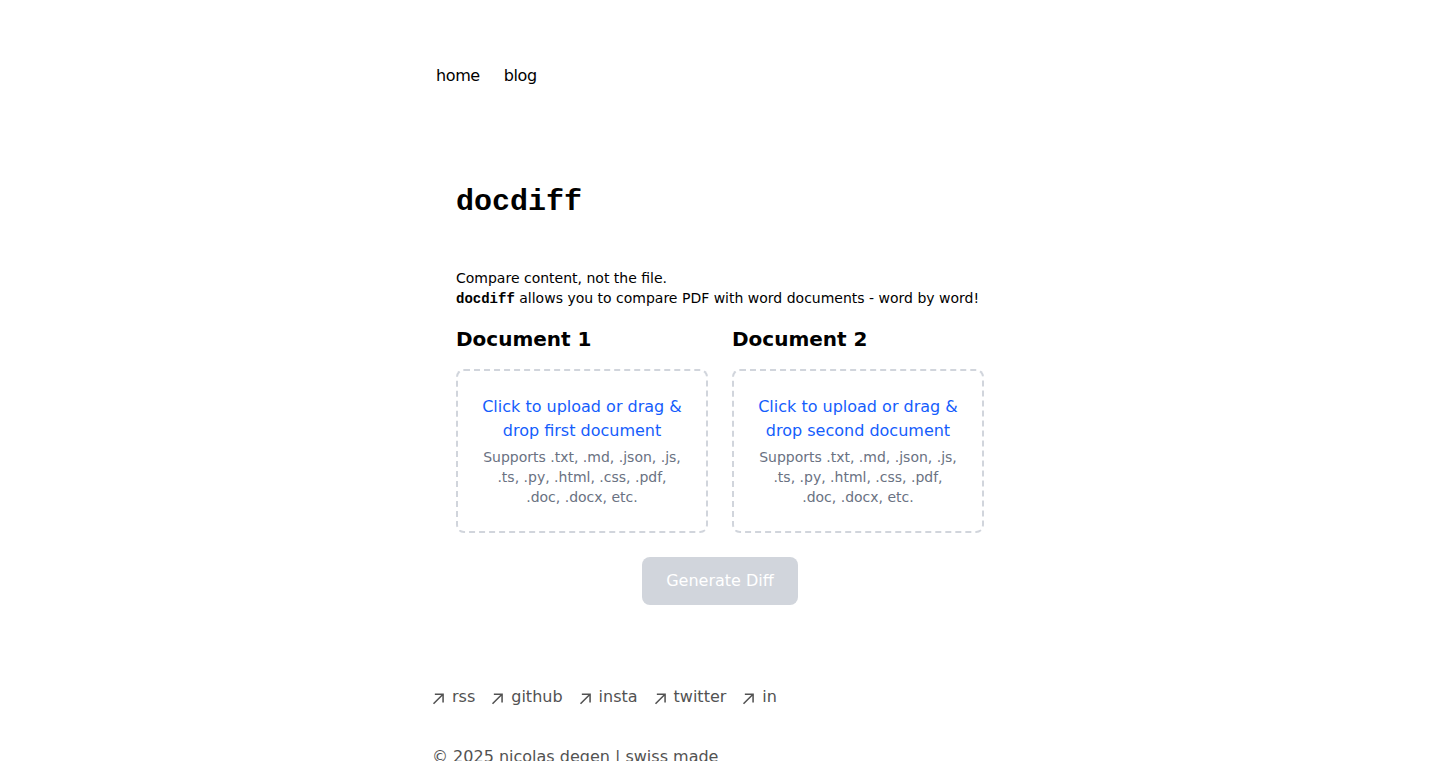
Author
nidegen
Description
Docdiff is a clever tool that helps you compare the content of Word documents (docx) and PDF files, highlighting the differences between them. It tackles the common headache of needing to meticulously check changes when dealing with legal documents or collaborative projects. The innovation lies in its ability to extract and compare text, handling formatting differences like font styles and layouts. So, instead of manually comparing every line, you can quickly see the edits, additions, and deletions.
Popularity
Points 2
Comments 0
What is this product?
Docdiff works by cleverly extracting the text from both your docx and PDF files. It then compares this text, looking for differences in content, like added, removed, or changed words and sentences. Its key innovation is handling the differences in how docx and PDF files store text, taking into account formatting variations. So, if you changed the font size in your Word document, Docdiff will still recognize that the content is the same. This approach offers a more accurate and user-friendly way to identify differences than simple file comparisons.
How to use it?
Developers would use Docdiff in scenarios where document version control is critical. Think of lawyers, editors, or anyone who needs to verify changes made to a document. You can integrate it into existing workflows, potentially automating the comparison process. For example, in a legal firm, you could use it to quickly review edited legal contracts to ensure they align with the original version. The developer typically runs Docdiff from the command line, specifying the docx and PDF files to compare, and it outputs a clear visual representation of the changes.
Product Core Function
· Text Extraction and Comparison: This function extracts text from both docx and PDF files and compares them. This is the core of the tool, allowing it to pinpoint differences in content. So this is useful for anyone needing to spot changes in their important documents.
· Difference Highlighting: Docdiff identifies and visually highlights the differences it finds, making it easy to spot edits, additions, and deletions. This is a critical feature, since it's the core feature that makes identifying changes easy and fast.
· Format Handling: The tool accounts for formatting differences between docx and PDF, ensuring it accurately compares the content regardless of how it looks visually. This is useful for any document needing change management.
Product Usage Case
· Legal Document Review: A law firm uses Docdiff to quickly compare an edited contract (docx) with the original (PDF) to verify that all changes have been accurately implemented. This saves time and reduces the risk of errors in critical legal documents. It's useful when you need to spot the details in a legal contract.
· Editorial Workflow: An editor uses Docdiff to compare a draft manuscript (docx) with a proofread PDF, identifying all changes made by the proofreader. This ensures all edits are reviewed and approved. It's useful when the editor needs to make sure the proofreader did the job.
· Software Documentation Updates: A developer uses Docdiff to compare the updated documentation (docx) with the published documentation (PDF) after making changes to the software, ensuring the documentation reflects the latest features and fixes. This helps keep documentation current and accurate.
46
Medici: Open-Source Expense Simplifier
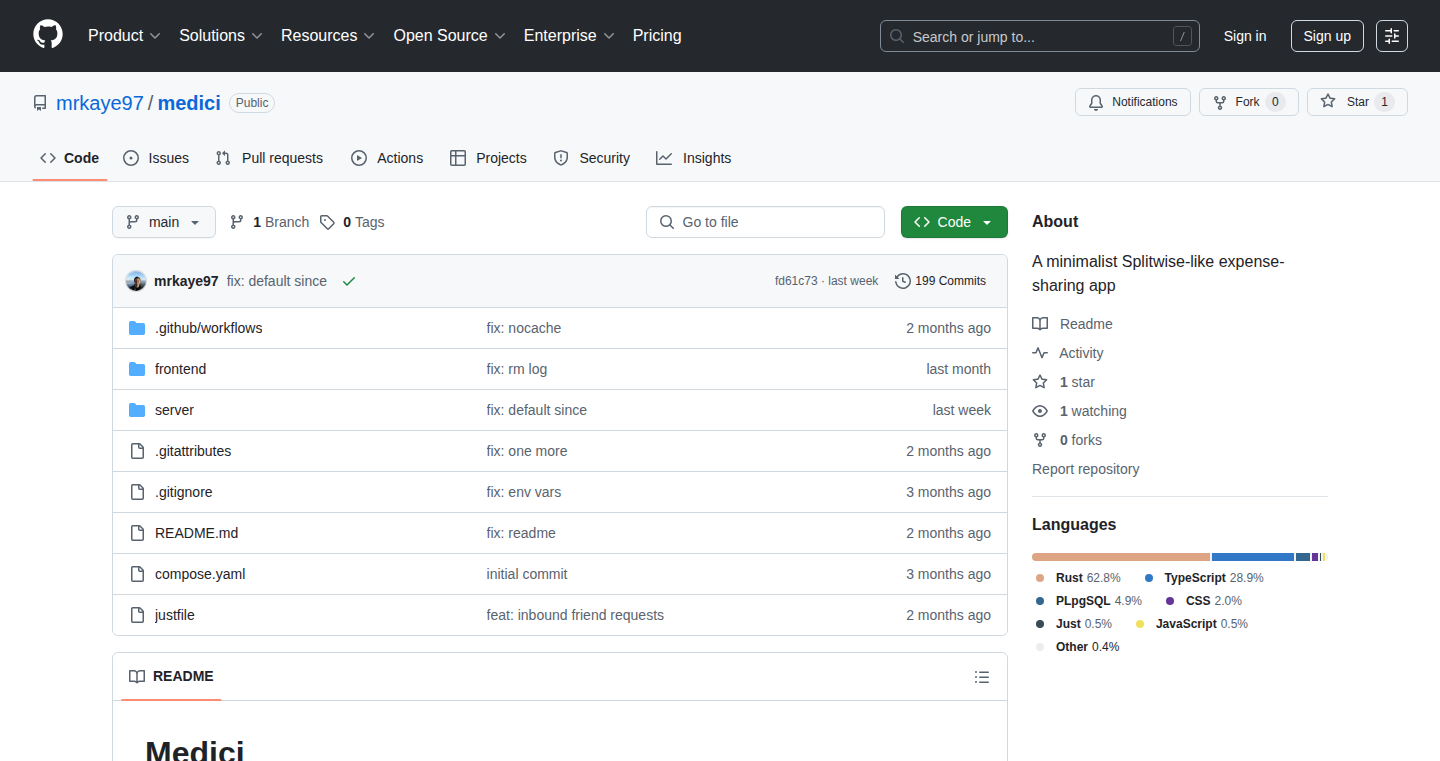
Author
mrkaye97
Description
Medici is a minimal, open-source alternative to Splitwise, designed to simplify expense sharing among groups. The core innovation lies in its algorithm for minimizing the number of transactions required to settle debts. This project directly addresses the frustration of limited expense submissions in other platforms, offering a self-hostable solution built with Rust. So, it helps people track and resolve shared expenses efficiently, reducing the hassle of multiple payments and complex calculations.
Popularity
Points 2
Comments 0
What is this product?
Medici simplifies shared expenses by determining the most efficient way to settle debts. Instead of requiring everyone to pay everyone else, it identifies the minimal set of transactions needed to balance the accounts. The project uses a simplification algorithm (the specific algorithm isn't detailed, but it's the key innovation) to find this optimal solution. Built with Rust, it offers a lightweight and self-hostable alternative. So, it takes away the headache of manually calculating who owes what to whom.
How to use it?
Developers can self-host Medici, meaning they can run it on their own servers. This offers complete control over their expense data. The primary use case involves inputting shared expenses and the people involved. Medici then calculates the debts and suggests the simplest payment plan. Developers can integrate it with other financial tools or use it as a standalone solution. So, it offers a private and customizable solution for managing shared expenses.
Product Core Function
· Expense Input: The core function is to allow users to input shared expenses, including the amount, the people involved, and who paid. It uses a simple interface for easy data entry. So, it provides a user-friendly way to record shared costs.
· Debt Calculation: Medici calculates the amount each person owes or is owed, based on the entered expenses and the split. This calculation is at the heart of its functionality. So, it accurately determines individual financial obligations.
· Transaction Simplification: The project simplifies the debts, generating the fewest transactions needed to settle everything. This is the unique selling point. So, it streamlines the process of repaying debts, making it easier and faster.
· Self-Hosting: It's designed to be self-hostable, meaning users can run it on their own hardware. This means complete control over the data and privacy. So, it guarantees privacy and allows for customization.
Product Usage Case
· Roommate Expense Tracking: Several roommates are sharing expenses like rent, utilities, and groceries. They use Medici to track these costs. Medici will tell them how much each person owes, simplifying the repayment. So, it avoids the need to manually calculate each individual's contributions.
· Travel Expense Management: A group of friends takes a trip and share hotel costs, food, and activities. They use Medici to log all expenses and quickly see how much each person needs to pay others. So, it makes travel expenses manageable and transparent.
· Small Business or Freelance Team Expense Tracking: A small team needs to track shared office costs or client expenses. Medici can simplify cost allocation. So, it supports efficient financial management of small organizations.
47
FigForm: Visual Form Builder with Figma-like Precision
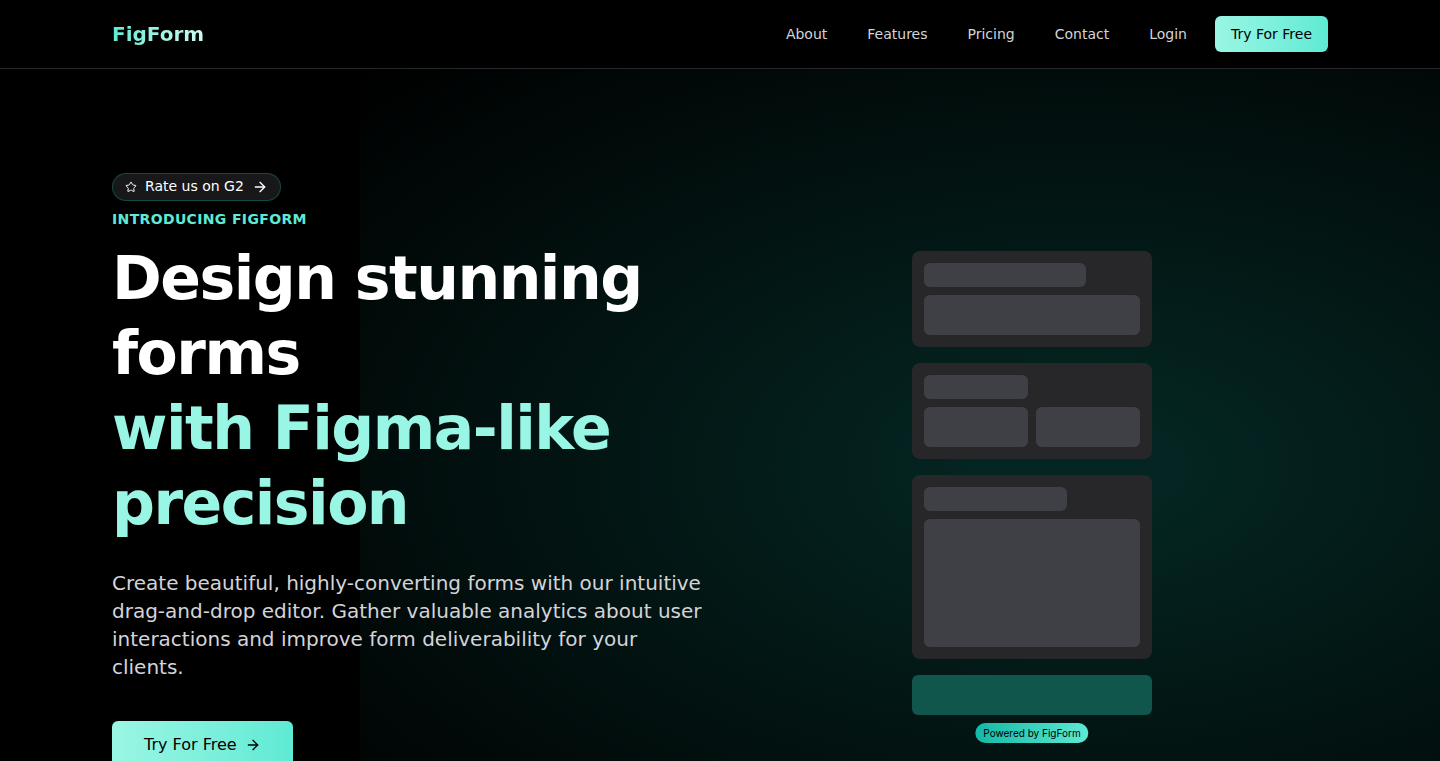
Author
aarondelasy
Description
FigForm is a form builder that lets you create beautiful, custom forms without writing any code. It uses a drag-and-drop interface similar to Figma, allowing designers and marketers to visually design forms with pixel-level precision. The aim is to make creating forms as easy and intuitive as designing in a graphic design tool, solving the clunky and developer-heavy process of traditional form creation. So, you can build visually appealing forms that match your brand perfectly, increasing conversions and improving user experience.
Popularity
Points 1
Comments 0
What is this product?
FigForm is a web application that allows you to visually build forms using a drag-and-drop interface, similar to how you design in Figma or other graphic design software. It gives you fine-grained control over the form's appearance and layout, letting you customize every element to match your brand identity without needing any code. The innovation lies in bringing the ease and visual control of design tools to form creation. So, it makes the form creation process faster and more intuitive, saving developers and designers time and effort.
How to use it?
You can use FigForm to create forms directly within the application or embed them into your website or landing pages. The drag-and-drop editor lets you easily add and arrange form fields, customize their appearance, and set up validation rules. You can then embed the form on your website using a simple embed code or link. So, you can create engaging forms for lead generation, surveys, and other data collection needs quickly and easily.
Product Core Function
· Drag-and-drop interface: Users can easily arrange and customize form elements like text fields, dropdowns, and buttons without writing code. This visual approach makes the form-building process more intuitive. So, you can quickly design forms without needing to learn code or rely heavily on developers.
· Pixel-perfect design control: FigForm offers fine-grained control over the appearance of form elements, allowing for precise customization of fonts, colors, and layouts. This ensures that the forms match your brand aesthetic perfectly. So, you can create visually consistent forms that align with your brand's visual identity.
· No-code form creation: FigForm eliminates the need for developers to write code to build forms, making the process accessible to marketers and designers. This accelerates the form-building process and reduces reliance on development resources. So, you can build and iterate on forms independently and efficiently.
· Customizable templates and themes: FigForm likely provides pre-designed templates and themes, which allow users to quickly create professional-looking forms without starting from scratch. So, you can create beautiful and functional forms in minutes.
Product Usage Case
· Lead generation forms: Marketers can use FigForm to create visually appealing forms to capture leads on landing pages. The precise control over the form's design can improve conversion rates. So, you can attract more leads by designing a form that resonates with your target audience.
· Customer surveys: Businesses can use FigForm to build attractive and engaging surveys to gather customer feedback. The design capabilities allow you to create surveys that are easier to complete and more likely to get a high response rate. So, you can collect valuable feedback that helps you improve your products or services.
· Contact forms: Websites can utilize FigForm to create custom contact forms that match their brand's visual identity, providing a seamless user experience. So, your website will look more professional and improve customer engagement.
· Embedded forms: Developers can use FigForm to create forms that seamlessly integrate into their website or application, making it easier for users to interact with their service. So, you can easily embed forms within your existing applications or websites.
48
Macuse: macOS AI Supercharger
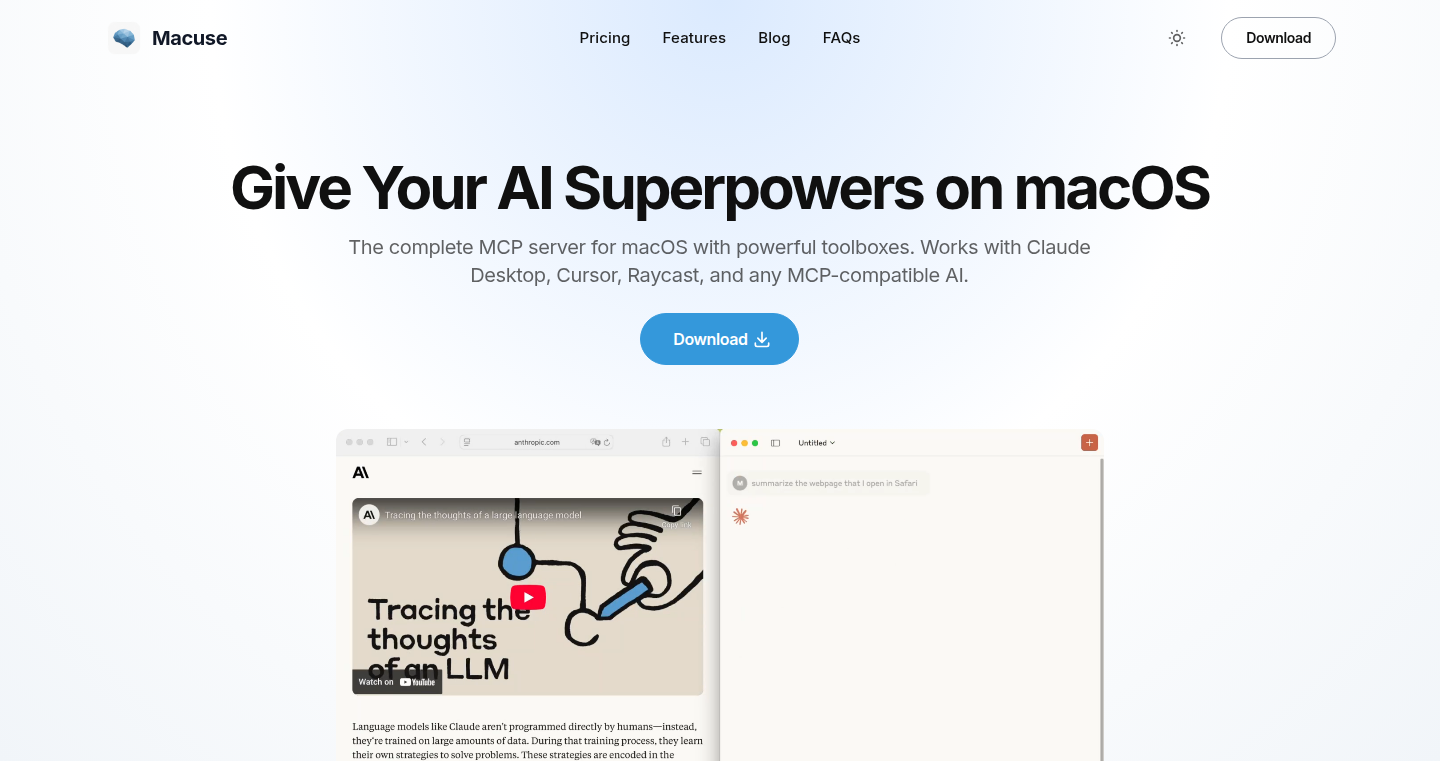
Author
ahonn
Description
Macuse is a macOS-specific server that gives AI assistants, like the ones you chat with, the ability to *actually* do things on your Mac. Instead of just answering questions, your AI can now open apps, manage files, and even automate tasks. The innovation lies in deeply integrating AI with the macOS system, overcoming the usual limitations of AI only providing information. This addresses the problem of AI being a passive information source and unlocks its potential for active task execution on a Mac.
Popularity
Points 1
Comments 0
What is this product?
Macuse acts like a bridge, enabling your AI to communicate with your Mac's core functions. Think of it as giving your AI a set of 'superpowers' specific to macOS. It achieves this through custom APIs that allow the AI to interact with macOS elements like the file system, applications, and system settings. It goes beyond just answering questions; it allows the AI to take actions. So this is essentially a new way for you to control your Mac through AI, automating tasks and streamlining workflows. The core innovation is the deep system integration, providing functionality that wasn't readily available before.
How to use it?
Developers can use Macuse by integrating it with their preferred AI models. They'll use the Macuse server's API to create actions that the AI can trigger. This allows developers to build applications that interact with macOS in new and dynamic ways. For instance, imagine an AI assistant that automatically backs up your files or opens your favorite music app when you sit down at your computer. This means developers can now build highly interactive applications, create complex workflows driven by AI, and significantly increase the automation potential of apps on macOS.
Product Core Function
· File Management: Allows the AI to create, delete, move, and search for files on your Mac. This enables AI to organize your digital life. For example, the AI could automatically move all images downloaded today to a specific folder. So this is useful for organizing your files efficiently and automating file operations.
· Application Control: Enables the AI to open, close, and interact with applications. This means AI can launch your favorite apps, switch between them, or even control some app functions. This is valuable because it improves productivity by automating routine tasks like opening or closing applications.
· System Interaction: Provides the AI with the capability to control system settings like volume, display brightness, or even the Wi-Fi connection. This is important because it allows the AI to tailor your system to your needs. You can customize how your system behaves, which offers greater user experience.
· Task Automation: Combines the above functions to create complex automated workflows. So the AI can perform a series of actions, like opening an app, setting up a workspace, and then opening relevant files. This reduces the amount of time spent on repetitive tasks and streamlines workflows.
Product Usage Case
· Automated File Backup: You can instruct your AI to automatically back up your important files to an external drive at a specific time or whenever you make changes to a project. So, you'll save time from manually doing file backups while keeping your files safe.
· Smart Workspace Setup: You can ask your AI to open specific applications, arrange windows, and load project files whenever you start working on a new task. This will help you reduce time wasted on setting up a workspace and immediately start your work.
· Voice-Controlled Media Control: You could control your music or video playback with voice commands. This functionality adds an extra layer of convenience to your multimedia setup. So you can manage your music or video without ever touching your computer.
49
Small-Dit: A Minimal Diffusion Transformer Implementation

Author
alenmangattu
Description
Small-Dit is a bare-bones implementation of a Diffusion Transformer model, built from the ground up. It focuses on the core concepts of diffusion models, which is a cutting-edge area of AI, especially for generating images and other data. The project's innovation lies in its simplicity: it provides a clear, concise demonstration of how these complex models work, breaking down the intricate steps involved in creating them without relying on complex frameworks. This helps developers understand the fundamentals of diffusion models and experiment with them more easily. So this is useful because it helps you understand how to build AI models from scratch.
Popularity
Points 1
Comments 0
What is this product?
Small-Dit implements a Diffusion Transformer, a type of AI model. Diffusion models work by gradually adding noise to data (like an image) and then learning to remove that noise to reconstruct the original data. The 'Transformer' part refers to the architecture used, a type of neural network that excels at processing sequential data. This project uses minimal dependencies, making it easier to understand and modify. So this shows you how to build an AI model using core concepts and without relying on complex frameworks.
How to use it?
Developers can use Small-Dit to learn about the internal workings of Diffusion Transformers, experiment with different architectures and parameters, and potentially adapt the implementation for their own projects. They can integrate it into their own research, educational purposes or even use it as a base to build more complex models. By modifying the code, developers can explore different datasets (images, audio, etc.) and tweak the model's behavior. So this is helpful for developers who want to understand the foundations of this AI model and how to use it.
Product Core Function
· Noise Addition and Removal: The core of diffusion models. Small-Dit simulates the processes of adding noise to data and learning to reverse this process. This is vital for generating data similar to the original input (e.g., generating realistic images). So, it allows developers to visualize and experiment with the underlying principle of AI data generation.
· Transformer Architecture: Uses a simplified version of the Transformer architecture. This is important because Transformers have become a fundamental building block in modern AI, so understanding the components within the model can help developers create the models they need to solve different problems. It shows you how to use transformers, which are a central model architecture in AI, to build this diffusion model.
· Minimal Implementation: Because Small-Dit is intentionally kept very small and with minimal dependencies, making it straightforward to understand and modify. So, this simplifies the learning curve for beginners and allows for easier experimentation.
· Training Loop: The project provides a basic training loop, demonstrating how the model learns from the data and improves its ability to generate new data. So it allows developers to observe the learning process and modify the parameters, improving their understanding of how these AI models work.
· Data Handling: Includes basic data loading and preprocessing to prepare input data for the model. This is crucial for working with any data-driven model because the way your input is prepared affects the output. So this provides developers with the fundamentals of data processing to ensure their models work correctly.
Product Usage Case
· Educational Purposes: Students and researchers can use Small-Dit as a hands-on learning tool to understand the concepts behind diffusion models and transformers. By modifying the code, they can explore different hyperparameters and architectures. So, this can provide a practical understanding of diffusion models that is not found in lectures.
· Prototyping and Research: Developers can use the project as a starting point for experimenting with different architectures and datasets. They can try to improve the model's performance or adapt it to generate different kinds of data (e.g., audio). So, this allows for quick prototyping and experimentation in this developing AI field.
· Custom Data Generation: Using this as a template, developers can build tools that create new data by using the diffusion model techniques to solve specific problems (like generating synthetic images for training other models, or even create creative projects such as art generation). So it can be adapted to different needs in image or data generation tasks.
50
Mussolini or Bread: A Generative AI Guessing Game

Author
tonypapousek
Description
This project is a fun, experimental guessing game powered by generative AI. The core idea is simple: the AI presents a statement, and you have to guess if it's a quote from Mussolini or a quote about bread. The technical innovation lies in leveraging Google's Gemini-2.5-flash model to generate these statements, demonstrating the model's ability to handle creative text generation and knowledge retrieval in a playful context. It's a clever application of AI for entertainment, showcasing the power of large language models beyond traditional tasks.
Popularity
Points 1
Comments 0
What is this product?
This project is a text-based game using AI. It presents you with a statement generated by a powerful language model, Gemini-2.5-flash. You then guess whether the statement originated from the Italian dictator Mussolini or if it describes bread. The AI's ability to craft statements about diverse subjects and its knowledge about historical figures is the core of the project. This highlights how AI can be used not only for information retrieval, but also for creative and engaging content generation. So this allows you to have fun and interact with AI in a new way.
How to use it?
The project is likely used through a web interface. You'd probably see a statement, then choose between 'Mussolini' or 'Bread'. The AI would then reveal the correct answer. Developers could integrate this concept into educational tools, quizzes, or games where AI-generated content is central. They could also use the project's code as a starting point to build similar games, experiment with different AI models, or study how well AI models understand and generate content related to specific topics. So this provides a template for building similar interactive AI applications.
Product Core Function
· AI-powered Statement Generation: The system uses a large language model (Gemini-2.5-flash) to create statements about various topics, including bread and Mussolini. This showcases the AI's ability to generate text that is both creative and contextually relevant. So this could be used in your own AI-driven content creation projects.
· Knowledge Retrieval and Contextual Understanding: The AI must have access to information about Mussolini and bread, as well as understand the nuances of language to generate believable statements for each category. This tests the AI's knowledge base and its ability to differentiate between distinct subjects. So this is a testbed to see how well AI understand the subject matter.
· User Interaction and Gameplay: The project provides a simple user interface for users to play the guessing game. This emphasizes how AI can be used to make fun applications. So you can build simple, interactive AI powered games.
Product Usage Case
· Educational Quizzes: A teacher could adapt the game to test students on historical figures, scientific concepts, or other subjects. The AI could generate statements and the students could choose the correct answer. So, you can incorporate AI to generate quizzes content for education.
· Content Generation for Games: Game developers could use a similar AI model to create dialogue, descriptions, or scenarios for their games, making the game content more dynamic and varied. So, this provides a new way to create various game content.
· Entertainment Applications: Developers could build similar guessing games on various subjects for entertainment purposes. Imagine a game where you guess the artist based on AI-generated song lyrics. So you could create entertainment applications easily.
51
Slidesdown: Markdown Presentations Reimagined

Author
jceb81
Description
Slidesdown is a tool that lets you create presentations using Markdown, a simple text formatting language. The project has reached version 1.0, highlighting its innovations: a CLI (Command Line Interface) rewritten in Nushell for better usability, integration with Apache ECharts for interactive data visualization, support for slide multiplexing using Cloudflare tunnels for real-time collaboration, and support for styling with Tailwind and UnoCSS. This allows developers to quickly create visually appealing and interactive presentations directly from text, solving the problem of cumbersome presentation creation and allowing for easy updates and version control. So this is useful for anyone who needs to create presentations quickly, especially developers who are comfortable with markdown.
Popularity
Points 1
Comments 0
What is this product?
Slidesdown transforms Markdown files into dynamic presentations. It uses the power of Markdown for content, making it easy to write and edit. Key innovations include the Nushell-based CLI, which provides a more user-friendly command-line experience. The Apache ECharts integration allows developers to include interactive charts directly within their slides, making data more engaging. Slide multiplexing via Cloudflare tunnels enables real-time collaborative presentations. Finally, Tailwind and UnoCSS support gives developers flexibility in styling their presentations. This moves beyond the static limitations of traditional presentation software, allowing for greater flexibility and interactivity. So this allows users to create presentations with the ease of writing text, but with the visual appeal and interactivity of modern tools.
How to use it?
Developers use Slidesdown by writing their presentation content in Markdown. They can then use the command-line tool to render the Markdown into a presentation. The resulting presentation can be viewed locally or shared online using Cloudflare tunnels for real-time collaboration. They can customize the look and feel of the presentation using Tailwind or UnoCSS. The integration with ECharts means developers can include data visualizations simply by embedding the necessary chart configurations. This project is perfect for technical talks, project demonstrations, and any situation where a developer needs to present technical information effectively. So this is useful because you can create presentations using tools you already know (like a text editor and Markdown) and share them with others quickly.
Product Core Function
· Markdown-based Presentation Creation: Using Markdown allows for easy content creation and editing, making it faster to update and manage presentations. It's especially valuable for developers familiar with Markdown. So this allows faster presentation creation.
· Nushell CLI: The Command Line Interface (CLI) is rebuilt in Nushell, providing a more modern and user-friendly way to interact with the tool, simplifying the presentation creation workflow. So this means a smoother experience.
· Apache ECharts Integration: Integration with Apache ECharts enables the creation of interactive charts and visualizations directly within the presentation slides. This helps to visually represent data in an engaging way. So this is useful for showing data.
· Slide Multiplexing via Cloudflare Tunnels: Cloudflare Tunnels enables real-time collaborative presentations, allowing multiple users to view and interact with the presentation simultaneously. This is valuable for remote presentations and team collaboration. So this improves collaboration.
· Tailwind/UnoCSS Support: The integration with styling frameworks like Tailwind and UnoCSS allows developers to customize the look and feel of their presentations, providing greater design flexibility. So this means presentations can look great.
· Version Control: Because presentations are Markdown files, they can be easily version-controlled using Git. This simplifies collaboration and tracking of changes over time. So this lets users track and rollback changes easily.
Product Usage Case
· Technical Talks: A developer can use Slidesdown to prepare a talk about a new technology or a software project, integrating code snippets and interactive charts directly into the presentation. The ease of Markdown makes updates easy.
· Project Demonstrations: A team uses Slidesdown to showcase a new product to potential clients, demonstrating features with embedded interactive data visualizations and real-time collaboration, allowing real-time edits during the presentation.
· Code Documentation: A developer can create presentations to document software features and usage, using Markdown to structure the content and then using ECharts to show data on performance and API calls. This allows easy creation of guides.
· Training Sessions: An organization utilizes Slidesdown for internal training, creating interactive presentations with the ability to easily share and update training materials, even when the trainers are remote.
· Meeting Presentations: A project manager uses Slidesdown to create a dynamic presentation for team meetings, with the ability to edit and update the slides collaboratively in real-time, ensuring everyone is on the same page.
52
Orby: Intelligent Gmail Navigator for Discord
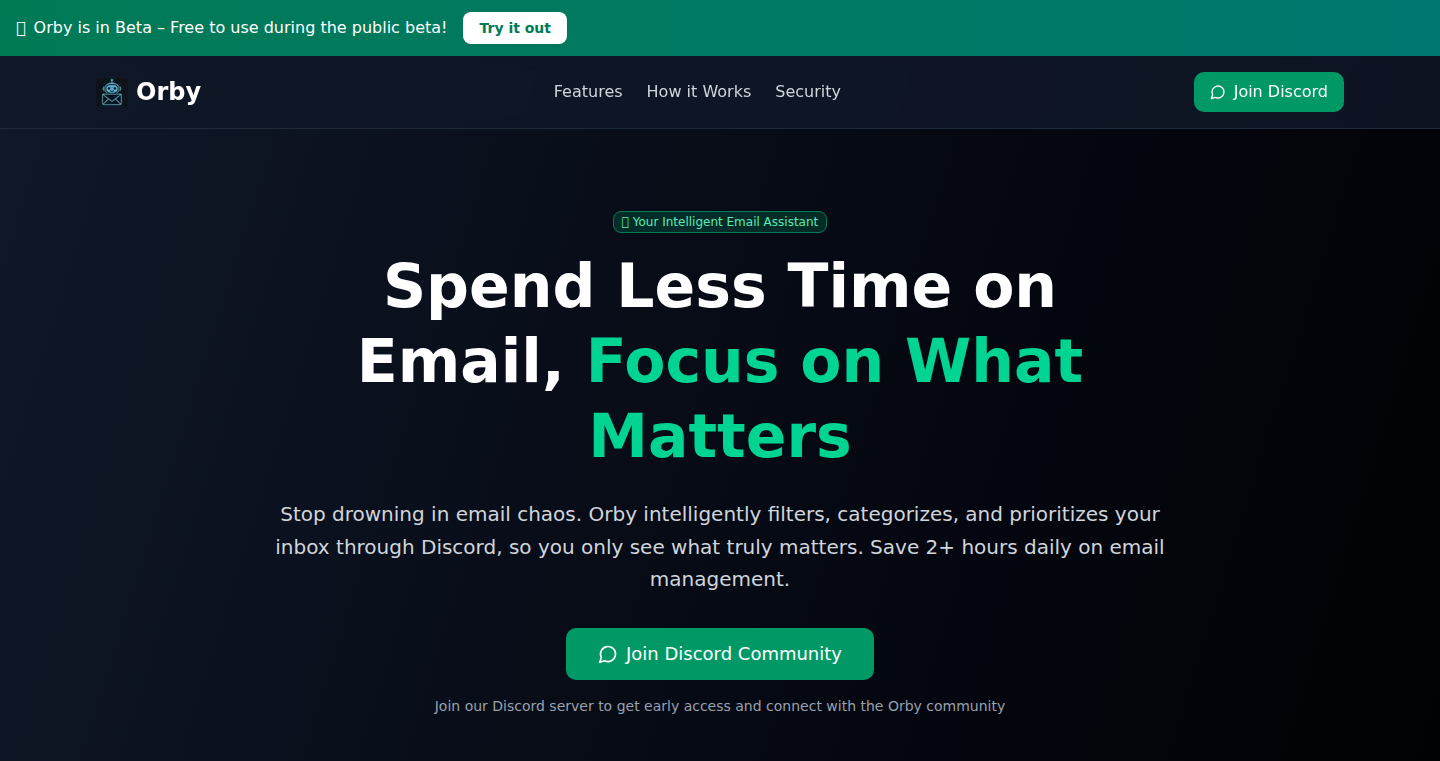
Author
ziadhussein
Description
Orby is a Discord bot that intelligently organizes your Gmail inbox and helps you manage your email without ever leaving Discord. It uses natural language processing (NLP) and email parsing techniques to filter important emails and prepare draft replies for you. This solves the problem of information overload in email, making it easier and faster to stay on top of important messages. This is innovative because it integrates email management directly into a popular communication platform.
Popularity
Points 1
Comments 0
What is this product?
Orby is like a smart assistant for your Gmail. It analyzes your emails, figures out what's important, and sends you summaries and alerts directly within Discord. It uses AI to understand your email content and can even draft replies for you. The key innovation is bringing email management to a more convenient interface, saving you time and reducing the need to constantly switch between apps. So this is helpful for busy people who are always on Discord, and don't want to miss important emails.
How to use it?
To use Orby, you connect your Gmail account to the Discord bot. Then, it automatically starts organizing your emails. You'll receive notifications in Discord for important emails. You can view summaries, and Orby can even help you draft replies. This is useful for anyone who gets a lot of email, such as project managers, customer service reps, and even students. The integration is seamless – just a quick authorization process, and you're set. So, you can keep track of your email without needing to go into your Gmail account.
Product Core Function
· Intelligent Email Filtering: Orby uses natural language processing (NLP) to identify important emails, filtering out the noise and focusing on the messages you need to see. This saves time and prevents you from missing crucial information. Applications include sorting important client communications from newsletters.
· Real-time Notifications in Discord: The bot sends instant notifications for high-priority emails directly to your Discord channels. This ensures you're immediately aware of urgent messages without constantly checking your inbox. This is great for team collaboration where real-time awareness is essential.
· Email Summarization: Orby provides concise summaries of your emails, allowing you to quickly grasp the core content without reading the full message. This is great for quickly understanding the content of important emails.
· Draft Reply Preparation: The bot can automatically prepare draft replies based on the email content, saving you time and effort in responding. This makes it easier to quickly react to important email. Good for quickly answering emails.
· Gmail Integration: Orby works directly with your Gmail account, connecting to your inbox, which handles your data. Allowing your data to be in a safer environment to prevent data loss.
· Free Public Beta: 100% free during the beta phase for users to test the product.
Product Usage Case
· Project Manager: A project manager uses Orby to monitor client emails for urgent requests or project updates. They receive instant notifications in Discord, allowing them to respond quickly and keep the project on track. They can get email summaries in Discord, saving time.
· Customer Support Agent: A customer support agent uses Orby to manage customer inquiries. They receive alerts for high-priority support tickets and can use the draft reply feature to quickly formulate responses, improving response times and customer satisfaction. The customer service agent gets important information immediately, saving time to help customers.
· Student: A student uses Orby to keep track of emails from professors and classmates. The bot filters out non-essential messages, and provides summaries of key announcements. They can quickly check important emails.
· Remote Team: A remote team uses Orby to manage internal communications and announcements. The bot provides summaries and highlights important emails for the team. Allowing the team to stay updated on information.
53
Day by Day: A Visual Life Timeline

Author
mrroryflint
Description
This project is a web application that visualizes your entire life as a daily timeline. It allows you to log significant events, and then presents them in an easy-to-understand visual format, like a chronological chart of your life. The core innovation is the simple and intuitive way it converts scattered life events into a coherent, visual narrative. It solves the problem of keeping track of memories and personal milestones and provides a novel way to reflect on one's experiences. So what? You can gain insights into patterns in your life and better understand how different events connect.
Popularity
Points 1
Comments 0
What is this product?
This is a web app that takes your personal data (life events, memories) and transforms it into a visually accessible timeline. The technical principle involves data storage, retrieval and then display logic to render this data in a user-friendly way. The innovative part is how it structures and presents the data – turning the raw information into a timeline, making it easier to analyze your life’s journey visually. So what? It provides a novel method to introspect and reflect on your life experiences in a structured way.
How to use it?
Developers can use this project to learn how to visualize and organize data in a chronological manner. It shows how to build a user interface that allows users to input their own data, store it securely, and then display it in a customized manner. You could use this as inspiration to build a similar app for other forms of personal data, like fitness tracking or project management. Also, it could be used as a front-end component integrating with an existing back-end system. So what? You can learn practical data visualization and user interface design principles.
Product Core Function
· Event Logging: The core function is the ability to add events with dates and descriptions. This involves building the user interface for data input and storage. So what? This enables you to record your memories and create the data required to visualize the timeline.
· Data Encryption: The application encrypts user data at rest to maintain privacy. This includes the use of cryptographic techniques to protect your personal information. So what? Your personal life events are kept secure.
· Timeline Visualization: Displays the events chronologically on a timeline, providing a visual representation of your life. This includes front-end coding for the timeline presentation. So what? This presents your life events in an easy-to-understand format.
· User Authentication: It allows users to sign in and manage their data securely. This function is related to user privacy and data management. So what? It offers a secure and private way to manage your personal data.
· Public Sharing: This enables the option to make the timeline publicly available, sharing the timeline with others. This involves the use of sharing mechanisms and privacy controls. So what? You have the option to share your life's story with others.
Product Usage Case
· Personal Journaling App: Developers can integrate this project's technology into a personal journaling app, allowing users to visually map their entries over time. For instance, visualizing journal entries with specific dates and descriptions. So what? Users can gain deeper insights into their journaling habits and the timeline of their thoughts.
· Project Management Tool: Adapt the timeline visualization concept to manage project milestones and tasks. Developers can build a tool where users can see their projects' progress over time. So what? It helps in time management and gives a visual representation of task progress.
· Health and Fitness Tracker: Visualize health data, such as workout frequency and weight changes, on a daily timeline to observe progress and patterns. So what? This provides a visual overview to track and evaluate your health-related data, making it easy to understand your progress.
· Data Visualization Library: A developer can use the timeline visualization aspect of the project to build a data visualization library. They can create an easy-to-use interface that helps users build and understand complex timeline visualizations. So what? It helps in building a tool for analyzing historical data trends.
54
RepoForge.io Publish Action: Automating Package Deployment
Author
chris140957
Description
This project is a GitHub Action that automates the process of publishing software packages (Python, Docker, and NPM) to RepoForge.io, a secure and fast artifact registry. It simplifies the often complex and error-prone task of deploying code, providing a streamlined workflow for developers. The action handles authentication, tagging, and pushing of packages, along with fail-safe mechanisms for common issues like package republishing. The core innovation lies in its ease of integration with GitHub Actions, allowing developers to seamlessly incorporate package publishing into their CI/CD pipelines, saving time and reducing potential deployment errors.
Popularity
Points 1
Comments 0
What is this product?
This is a GitHub Action, essentially a small program that runs automatically in response to events on GitHub (like a code push). It's specifically designed to publish different types of software packages (Python, Docker images, and NPM modules) to a secure online storage called RepoForge.io. The key innovation is it makes this deployment process very easy. Instead of manually uploading packages, developers can simply configure this action to handle it automatically. It takes care of all the steps: authentication (making sure you have the right permissions), tagging your packages (labeling them with versions), and pushing them to the registry. So this gives developers an automated, reliable, and faster way to get their code out there for others to use.
How to use it?
Developers use this action by adding it to their GitHub workflow files (YAML files that define the steps of their continuous integration and continuous deployment, or CI/CD, pipelines). They configure the action with details like their authentication tokens for RepoForge.io, the specific packages to publish, and the desired tags or versions. Whenever a code change is pushed to the repository, GitHub Actions will automatically run this publish action, handling the entire deployment process. This streamlines the build and deploy process, so instead of manually doing a number of steps to deploy, this automates all those actions for you. For example, if you use Docker, it will build and push the images to your specified registry. The action supports different types of packages, so you are able to use it across all aspects of your software projects.
Product Core Function
· Python Package Publishing via Twine: This function lets you automatically publish Python packages to RepoForge.io, handling the necessary authentication and upload processes. So you can keep your Python packages organized and accessible in one central location.
· Docker Image Publishing: This feature allows for automatic building, tagging, and pushing of Docker images. This speeds up the deployment process and ensures that your containerized applications are always up-to-date. Therefore, your containerized applications can be deployed and updated easily.
· NPM Module Publishing: This functionality provides automated publishing for NPM packages, making it easy to share and distribute your JavaScript libraries. This makes publishing your Javascript packages much easier and more organized, and it allows for better collaboration on Javascript projects.
· Configurable Inputs: The action allows you to configure all the important settings, such as your authentication token, registry URL, and tags. This gives you the flexibility to customize the action to match your specific needs. This gives you full control over how your packages are published.
· Fail-safe Handling: The action includes built-in mechanisms to handle common errors, such as issues that can happen when you try to republish a package. This ensures that the publishing process is reliable and prevents your builds from failing due to minor issues. So, this action is more resilient to typical deployment problems.
Product Usage Case
· Software Development Project: A team working on a Python project uses this action to automatically publish updated versions of their package to RepoForge.io every time they push changes to their GitHub repository. This simplifies their release process and ensures that users always have access to the latest version. So the development process is automated and simplified.
· Containerized Application Deployment: A developer using Docker uses this action to automatically build and push Docker images to RepoForge.io whenever changes are made to their application's code. This enables seamless deployment to different environments. So they can make faster and simpler deployments of their containerized applications.
· JavaScript Library Distribution: A developer working on an NPM package uses this action to automatically publish new versions of their library to RepoForge.io. This ensures that the library is easily accessible to other developers. Therefore, it provides easier ways to share and distribute Javascript packages.
55
UniStyle: Client-Side Unicode Font Generator
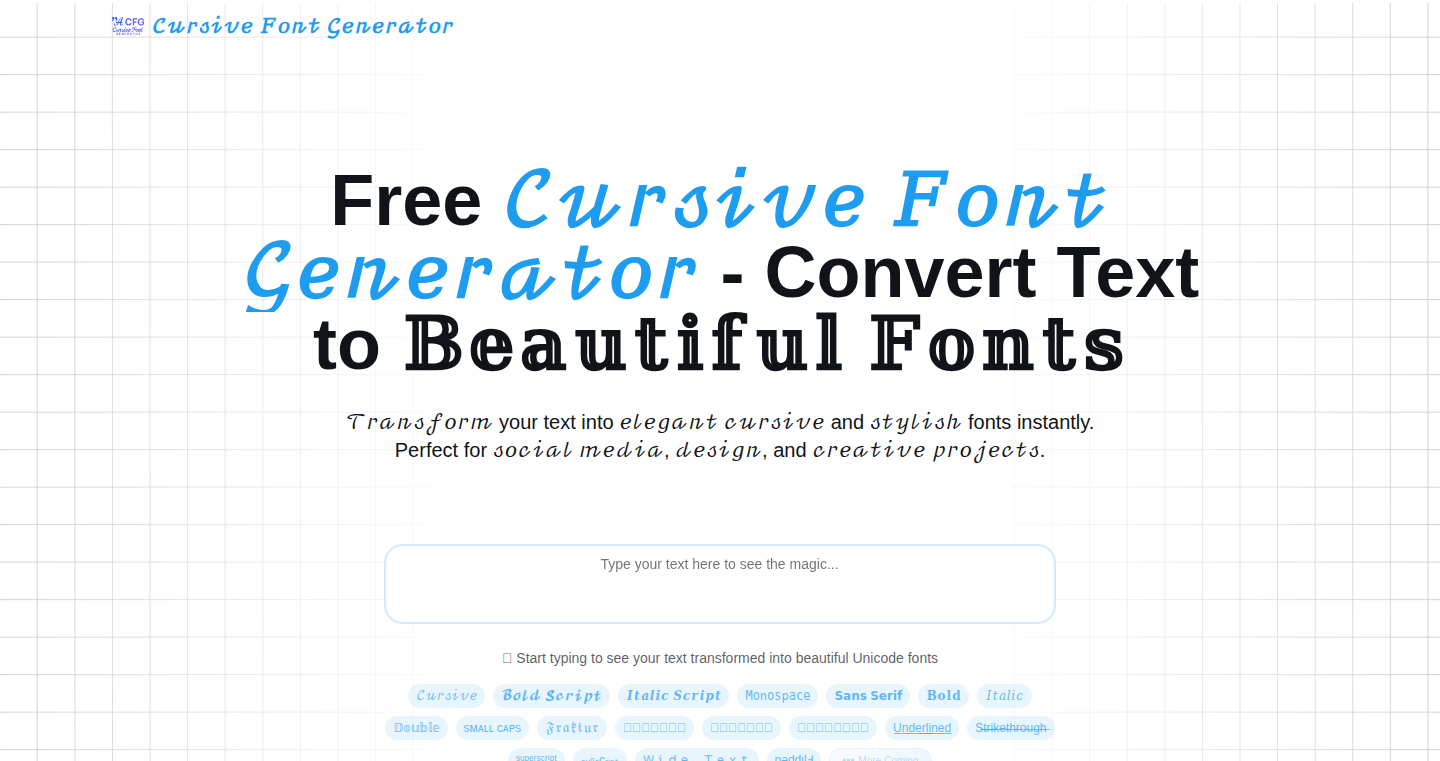
Author
qinggeng
Description
UniStyle is a free, ad-free online tool that instantly converts plain text into various Unicode font styles (like cursive, bold, or circled text) directly in your web browser. The magic happens entirely on your computer (client-side), using clever Unicode character mappings. This means your text never leaves your device, ensuring privacy. This project addresses the common problems of existing font generators: annoying ads, required sign-ups, and poor user experience. So, it's useful because it gives you a simple and private way to create cool text styles for social media, presentations, or just for fun.
Popularity
Points 1
Comments 0
What is this product?
UniStyle works by leveraging the power of Unicode, a universal character encoding system. It uses JavaScript to map each character you type to its corresponding Unicode representation in different font styles. Because the conversion is done in your web browser and not on a remote server, your text remains private and the tool is fast. So this is useful for its speed and privacy.
How to use it?
To use UniStyle, you simply type your text into the input field, and UniStyle instantly displays the text in 19 different Unicode font styles. You can then copy and paste the styled text wherever you need it. The tool is accessible via a web browser on any device. So this is useful for quickly generating creative text variations for a wide range of applications.
Product Core Function
· Real-time conversion: As you type, the text is instantly converted into the selected Unicode font style. This feature provides instant feedback and a seamless user experience. It's useful for quickly visualizing how text will appear in different styles.
· Client-side processing: All text processing happens within your web browser, ensuring your privacy and eliminating the need for a server. This is useful because it guarantees your text never leaves your control, making it suitable for sensitive information or private usage.
· Multiple font styles: Offers 19 different Unicode font styles, providing a wide variety of creative options. This is useful for enhancing visual communication, adding personality to social media posts, or creating eye-catching titles.
· One-click copy to clipboard: Allows you to copy the styled text with a single click. This feature streamlines the process of using the generated fonts in other applications. It's useful for saving time and effort when integrating styled text into other documents or platforms.
· Responsive design: The tool is designed to work across all devices, including desktops, tablets, and smartphones. This ensures that the tool is accessible from anywhere. It's useful for accessing the tool on any device, providing flexibility and convenience.
· Hover tooltips: Provides explanations for each font style when you hover your mouse cursor over them. This assists users in understanding the meaning and purpose of each style. It's useful for allowing users to understand the style and it's applications.
Product Usage Case
· Social media posts: Create eye-catching text for your social media updates. For example, using cursive text for a personal message, or circled text to highlight important information. This is useful for making social media content stand out and attract more attention.
· Presentations and documents: Enhance the visual appeal of presentations and documents by using different font styles for titles, headings, or emphasis. This is useful for making information more engaging and easier to understand.
· Website design: Use stylized text in website elements like headings, calls-to-action, or decorative elements. This is useful for improving the aesthetic appeal of a website and enhancing user experience.
· Creative writing: Experiment with different font styles for creative writing projects, such as creating unique titles, subtitles, or even entire passages in specific fonts. This is useful for adding a touch of creativity and uniqueness to written content.
· Instant messaging: Add a personal touch to chat conversations by using stylized text. You can use cursive text for a friendly greeting or a bold style to emphasize an important point. This is useful for adding expression and visual interest to your communication.
56
CoreDNS-GSLB: Your DNS-Powered Traffic Director
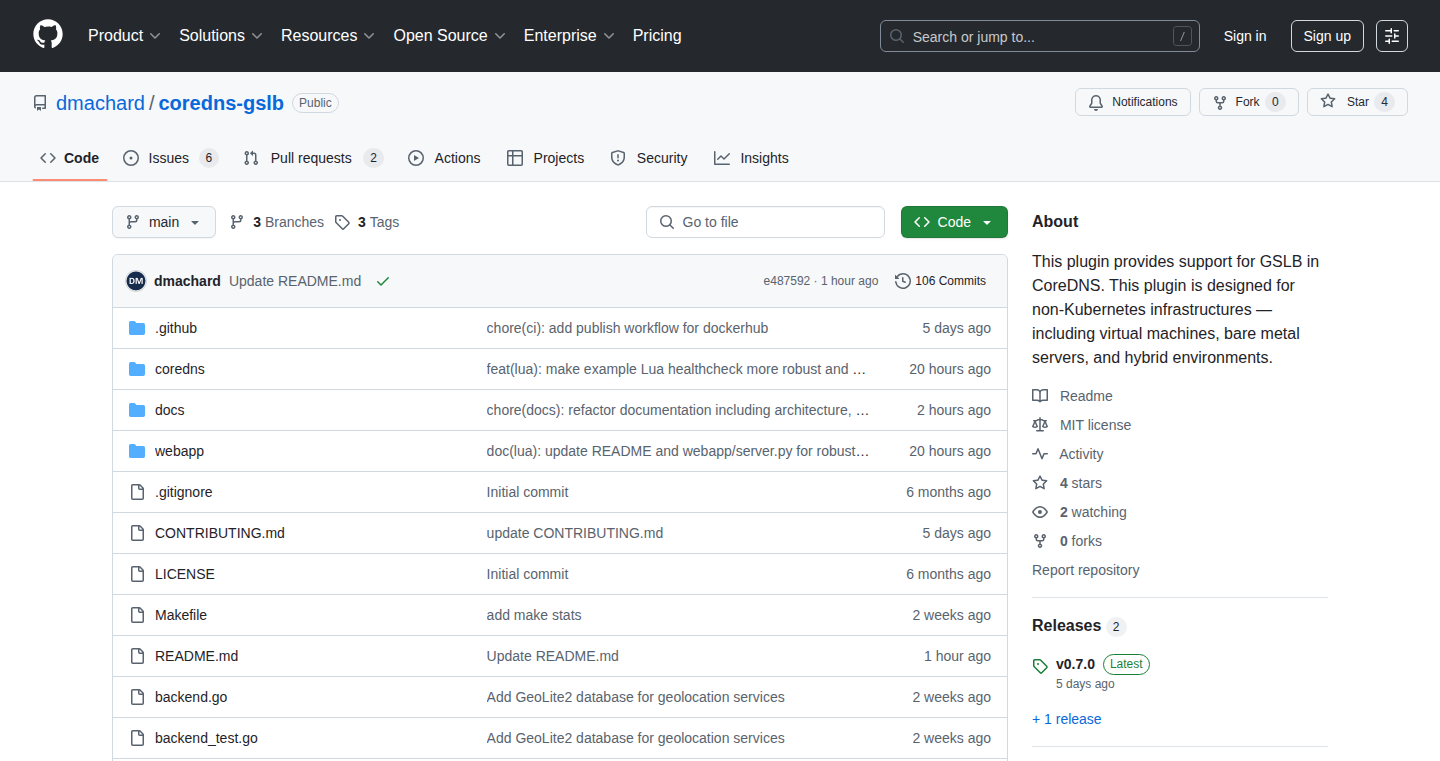
Author
dmachard
Description
This project, CoreDNS-GSLB, is a plugin for CoreDNS that provides global load balancing (GSLB) capabilities. Instead of relying on complex, often expensive, proprietary solutions or Kubernetes-specific tools, it leverages the Domain Name System (DNS) to intelligently route traffic to the closest or most available server across different geographical locations. Key innovations include GeoIP routing for directing users to the nearest data center based on their IP address, Lua scripting for highly customizable health checks (allowing for complex monitoring of backend services), and live configuration reloading, making changes seamless and without service interruptions. This is a powerful, flexible, and cost-effective way to improve website performance and availability globally. So this is useful because it can make your website faster and more reliable for users around the world.
Popularity
Points 1
Comments 0
What is this product?
CoreDNS-GSLB is a plugin that extends CoreDNS, a flexible and extensible DNS server. Its core functionality is global load balancing, meaning it distributes user traffic across multiple servers in different locations. It achieves this by using GeoIP to determine a user's location and then routing them to the nearest data center. The plugin also incorporates Lua scripting for creating sophisticated health checks. These checks monitor the health of the backend servers by calling HTTP APIs, parsing JSON responses, checking Prometheus metrics, or even executing commands over SSH. Further, the plugin includes adaptive health checking (reducing check frequency for idle servers), support for EDNS Client Subnet to get accurate client IPs, and live configuration reloading. So, it is useful because you can keep your services available and responsive for your users.
How to use it?
Developers integrate CoreDNS-GSLB by installing the plugin within their CoreDNS configuration. They then define rules for how traffic should be routed, specifying the geographical regions, the health check scripts, and other parameters. CoreDNS-GSLB can be used with any infrastructure, making it applicable to different types of services. You can use it in front of web servers, APIs, databases, or anything else that needs global load balancing. When a user accesses your service, CoreDNS-GSLB intercepts the DNS query, determines the user's location, checks the health of the available servers using the Lua scripts, and responds with the IP address of the best-suited server. So this is useful because you can easily and flexibly manage traffic across a global infrastructure.
Product Core Function
· GeoIP Routing: This feature uses the user's IP address to determine their geographical location and then routes them to the nearest data center. This is useful because it reduces latency (the time it takes for the website to load) and improves user experience by serving content from a geographically closer server.
· Lua-Scriptable Health Checks: Allows you to write custom scripts in Lua to check the health of your backend servers. These scripts can do everything from checking HTTP response codes to parsing JSON responses from APIs or querying metrics from Prometheus. This is useful because it provides a flexible and customizable way to monitor your services and automatically route traffic away from unhealthy servers.
· Adaptive Health Checking: Automatically adjusts the frequency of health checks based on the load on the backend servers. This is useful because it optimizes the performance of the health checks, reducing unnecessary load when servers are idle, and focusing more when needed.
· EDNS Client Subnet Support: Preserves the user's original IP address when forwarding DNS queries. This is useful because it allows accurate GeoIP lookups, ensuring users are directed to the correct data center even when DNS is being forwarded through multiple servers.
· Live Config Reload: Allows you to update the configuration of CoreDNS-GSLB without restarting the server. This is useful because it enables seamless updates and changes to your routing policies without interrupting the service. No downtime!
· TXT Record Debugging: Provides a quick way to debug the state of your backend servers by querying TXT records. This is useful because it simplifies troubleshooting and allows you to easily see which servers are healthy or unhealthy, which helps in identifying and solving routing issues.
Product Usage Case
· A global e-commerce website uses CoreDNS-GSLB to route users to the closest data center based on their location. If a user in London accesses the website, they are automatically directed to the data center in London, resulting in faster page load times and an improved user experience. This solves the technical challenge of providing a fast, consistent experience across different geographical locations.
· A SaaS (Software as a Service) provider utilizes CoreDNS-GSLB with Lua scripting to perform complex health checks on its backend servers. These scripts check the performance metrics from Prometheus and also perform custom API calls to monitor the health of specific services. If a server becomes unhealthy, CoreDNS-GSLB automatically redirects traffic to a healthy server, maintaining service availability. This tackles the problem of ensuring service uptime by proactively monitoring and managing server health.
· A gaming company uses CoreDNS-GSLB to manage its game servers across the globe. With GeoIP routing, players are automatically connected to the server nearest their physical location, reducing latency and creating a smoother gaming experience. They can also dynamically change game server configurations without impacting player sessions because of live config reloading. This solves the challenge of optimizing player experience and ensuring high availability for a global user base.
57
Snackit: YouTube Video Quiz Generator
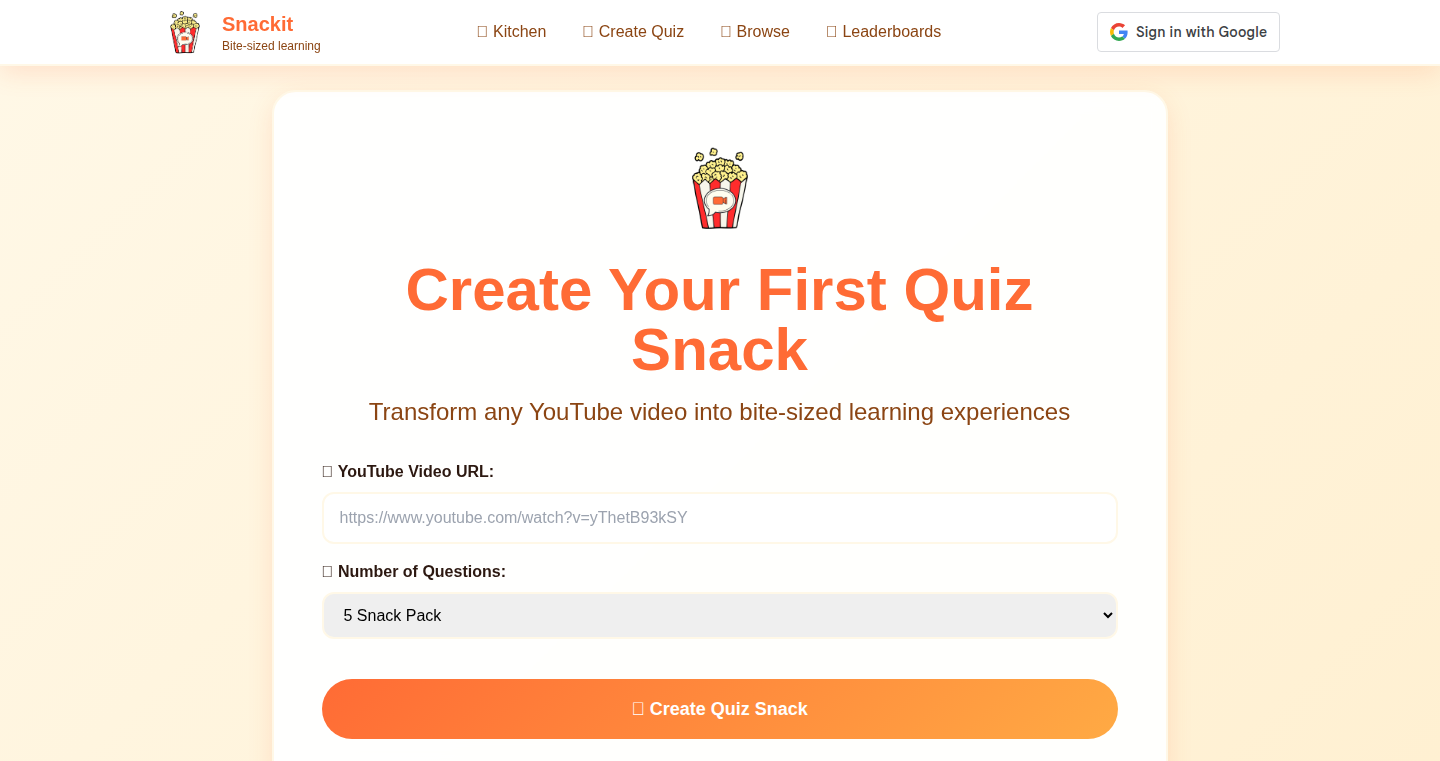
Author
alexandru84
Description
Snackit is a tool that transforms YouTube videos into interactive quizzes. The innovative aspect lies in its automated ability to analyze video content and generate relevant quiz questions. It addresses the challenge of making video learning more engaging and effective by turning passive viewing into active knowledge testing. So, what's in it for you? It makes learning from videos more interactive and helps you remember what you've watched.
Popularity
Points 1
Comments 0
What is this product?
Snackit leverages Natural Language Processing (NLP) and potentially speech-to-text technologies to understand the content of a YouTube video. It identifies key topics and generates quiz questions based on the video's narrative. This automated quiz generation process is the core innovation, saving users the time and effort of manually creating quizzes. So, this means you can learn from videos more efficiently and test your understanding immediately.
How to use it?
Developers can use Snackit by providing a YouTube video URL. The application then generates a quiz that the developer can integrate into their learning platforms, websites, or educational apps. This can be achieved using an API or by embedding the generated quiz directly. So, if you're building a learning platform, this simplifies adding interactive quizzes based on video content.
Product Core Function
· Automated Quiz Generation: Automatically creates quiz questions from YouTube videos. The value lies in saving time and effort compared to manual quiz creation, making video content more interactive. This is useful for anyone who wants to transform passive video consumption into an active learning experience.
· Content Analysis: Uses NLP to analyze the video content and identify important concepts. The value lies in accurately generating relevant quiz questions based on the video's subject matter. This helps in focusing the quiz on the key takeaways of the video.
· Interactive Learning: Transforms passive video viewing into an active learning experience. The value is to enhance the retention of information and provide immediate feedback on the user's understanding of the content. Great for anyone studying or trying to improve their knowledge.
· API Integration: Offers the possibility to integrate the quiz functionality into other applications. The value is in facilitating the creation of custom learning solutions and integrating the quiz generation into any existing education platform. This is useful if you want to integrate learning experiences to your website or product.
Product Usage Case
· Educational Websites: An educational website can use Snackit to create interactive quizzes for each video lesson. This allows students to immediately test their understanding and reinforce learning, fostering a better learning experience. So, you can make your educational content more engaging.
· Corporate Training: Companies can use Snackit to create quizzes for training videos. This facilitates the assessment of employees' comprehension of training material. So, you can be sure your employees have understood the training content.
· Personal Learning: Individuals can utilize Snackit to create quizzes for any YouTube video they watch to improve retention. This makes learning a more effective and enjoyable process. So, you can use it to enhance your personal learning process.
58
Prime Fold: Visualizing and Exploring Prime Number Patterns
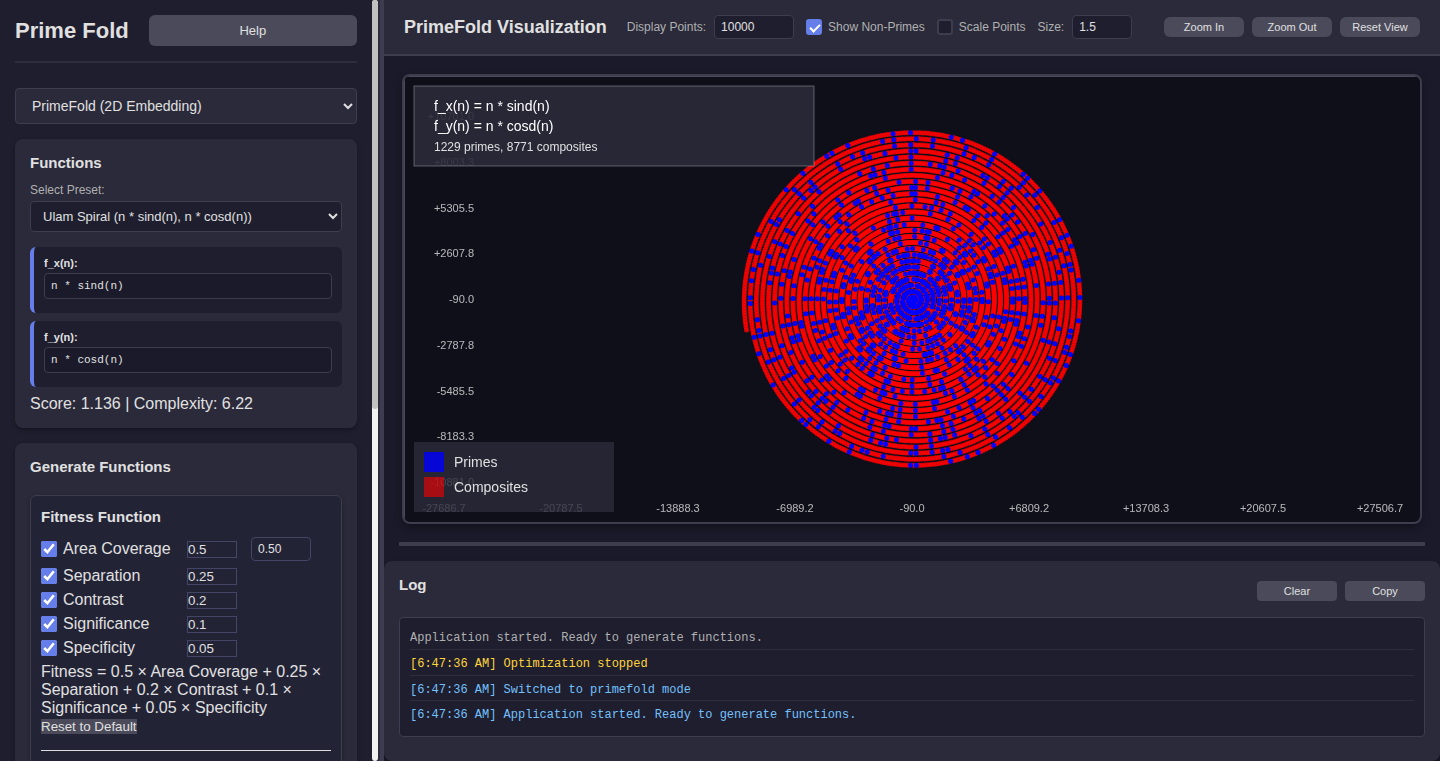
Author
ilmenit
Description
Prime Fold is a web-based tool designed to visualize and experiment with prime numbers and the mathematical functions that generate them. It allows users to input or develop their own functions, observe the resulting number sequences, and see which ones yield prime numbers. The tool also incorporates optimization algorithms to help discover functions that produce interesting prime patterns. This project offers a fun and interactive way to explore number theory concepts and potentially discover new patterns within prime numbers. So, it lets you play with math and see cool patterns, which is great if you're into math or just like to tinker!
Popularity
Points 1
Comments 0
What is this product?
Prime Fold is a web application that focuses on prime number exploration. At its core, it uses mathematical functions to generate sequences of numbers. It then checks each number in the sequence to see if it's a prime number (a number only divisible by 1 and itself). The innovative aspect lies in its visualization capabilities, allowing users to see the distribution of prime numbers in both 1D and 2D formats. Furthermore, it provides optimization tools that help users discover functions that generate more prime numbers or interesting visual patterns. This gives you a visual way to understand how math works and potentially find new number patterns. So, you can explore the world of prime numbers without needing a math degree!
How to use it?
Developers can use Prime Fold in a variety of ways. First, they can input their own mathematical functions or use the built-in functions to generate number sequences. Then, they can visualize the prime numbers within these sequences. Secondly, the tool can be used as a learning and exploration resource for number theory concepts, providing hands-on experience with function generation and prime number analysis. Finally, the optimization features offer a sandbox to experiment with finding functions that create interesting prime patterns. This can be especially useful for anyone interested in math, data visualization, or exploring mathematical concepts in a visual way. So, if you are trying to learn about primes, this tool helps you 'see' what's happening in a visual, interactive way!
Product Core Function
· Function Input and Evaluation: Allows users to enter mathematical functions (like formulas) and see the generated number sequences. This is valuable because it lets you play with different formulas and immediately see the results, which helps in understanding how mathematical functions work.
· Prime Number Detection: Checks each number in a sequence to determine if it's a prime number. This is crucial for identifying prime numbers generated by the functions. So, the tool tells you which of your numbers are prime.
· 2D and 1D Visualization: Provides the ability to visualize prime numbers in different formats (1D sequences or 2D patterns). This makes patterns and distributions easier to understand visually. Visualizing prime numbers makes it much easier to see the relationships between them.
· Optimization Algorithms: Includes built-in algorithms to search for functions that generate more prime numbers or visually interesting patterns. This provides an automated way to explore function space and discover new mathematical relationships. It can find interesting patterns for you, which is a huge time-saver.
· Interactive Interface: Offers an interactive web interface for users to experiment with different functions and visualize the results. This provides a hands-on approach to learning and exploration of mathematical concepts. The easy-to-use interface makes complex concepts accessible.
Product Usage Case
· Educational Tool: A teacher could use Prime Fold to demonstrate prime number patterns and function behavior to students, making abstract concepts more concrete and engaging. The visualizations can help students grasp complex mathematical concepts.
· Mathematical Research Exploration: Researchers and hobbyists can explore the tool to test different mathematical functions and discover new prime number patterns. This can speed up the process of experimentation and discovery.
· Data Visualization Experimentation: Developers interested in data visualization can use Prime Fold as a case study or template to learn about visualizing mathematical data and implementing interactive web visualizations. This helps in building interactive data displays.
· Personal Learning and Exploration: Individuals with an interest in mathematics can use Prime Fold to explore prime numbers and mathematical functions in a fun and interactive way, enhancing their understanding of number theory. So, it's a great way to learn and have fun at the same time.
59
MedTechAI - Synthetic Medical Datasets Generator
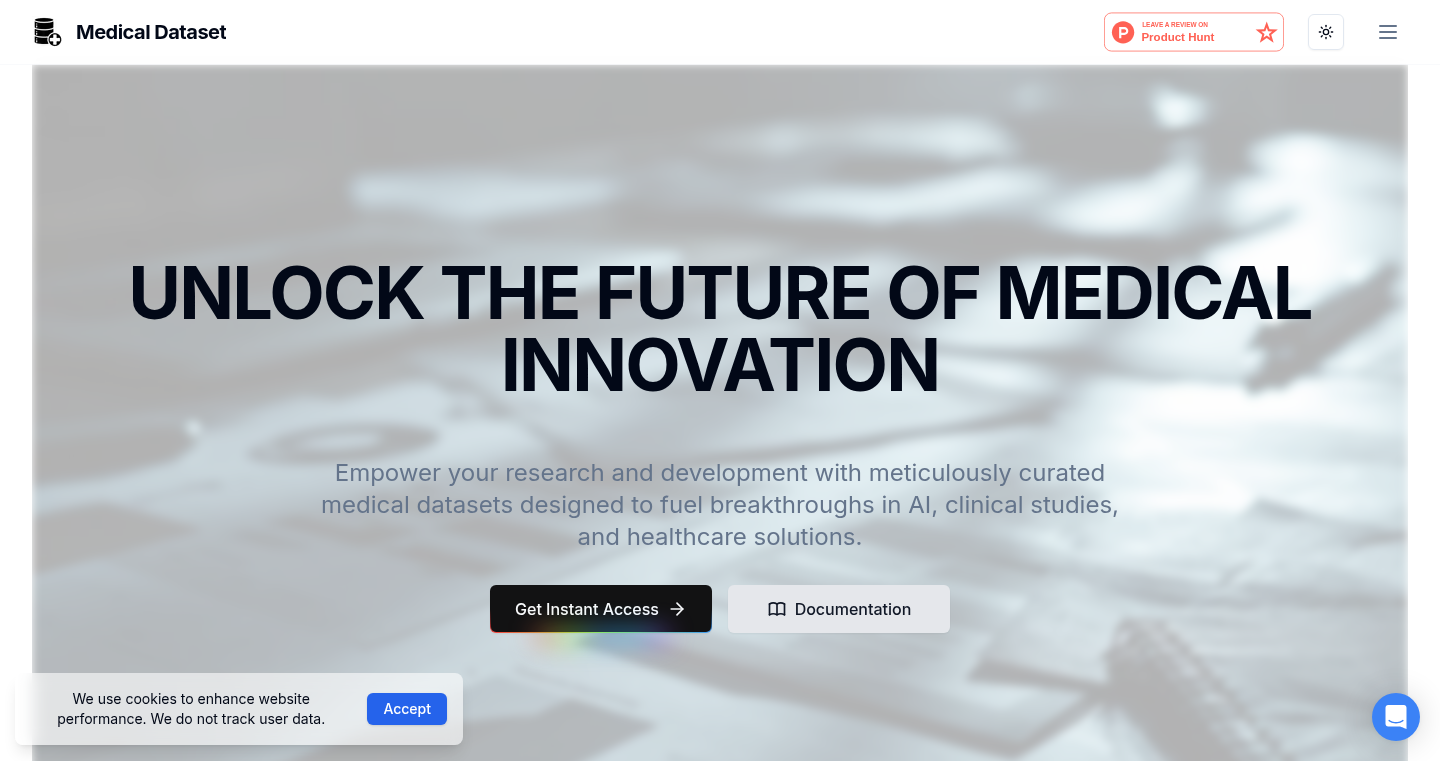
Author
harryjosh
Description
MedTechAI provides high-quality, privacy-compliant synthetic medical datasets. The core innovation lies in its ability to generate simulated medical data that mimics real-world clinical scenarios using proprietary algorithms. This solves the critical problem of limited access to real patient data due to privacy concerns and data licensing costs. By providing on-demand, scalable datasets, MedTechAI empowers AI researchers and healthcare data scientists to train and validate their models without needing access to actual patient records. This also covers edge-case pathologies, which are often underrepresented in public datasets. So this is useful because it allows for more rapid AI model development and testing in healthcare without compromising patient privacy or incurring high costs.
Popularity
Points 1
Comments 0
What is this product?
MedTechAI is a platform that creates synthetic medical datasets. It uses sophisticated algorithms to simulate real-world patient data, including various clinical scenarios. The key innovation is the generation of this data, which is fully anonymized and compliant with privacy regulations. Instead of relying on real patient records or expensive data licensing, MedTechAI offers an on-demand, scalable solution. The platform continuously monitors compliance and enforces consent frameworks to ensure data security. So this helps accelerate AI in healthcare by making high-quality datasets accessible.
How to use it?
Developers can access the datasets in JSON format. They can then use these datasets to train, test, and validate their AI models for healthcare applications. For instance, a developer building an AI-powered diagnostic tool could use MedTechAI's datasets to train their model on a variety of simulated patient cases, ensuring its robustness and accuracy before using it in a clinical setting. Integration involves downloading the JSON datasets and incorporating them into the model training and evaluation pipeline. So this simplifies AI model development for developers.
Product Core Function
· Synthetic Data Generation: The ability to create realistic medical datasets from scratch. This allows researchers to simulate various clinical situations and edge cases that might be difficult to find in real-world datasets. This is useful for training more comprehensive and accurate AI models.
· Privacy Compliance: Ensures all datasets are anonymized and adhere to privacy regulations. This is critical for protecting patient confidentiality and enabling safe data usage. This is useful for ensuring compliance and avoiding legal issues.
· On-Demand Scalability: Datasets can be generated as needed, providing flexibility and scalability for research and development. This is useful for adapting to specific needs and resource constraints.
· Edge Case Coverage: The platform includes datasets that cover unusual or rare medical conditions, which are often underrepresented in public datasets. This is useful for improving the performance and generalizability of AI models.
· Transparent Pricing: Clear and accessible pricing models. This is useful for budgeting and planning research and development projects.
Product Usage Case
· Developing a Diagnostic Tool: An AI researcher is building a model to detect early signs of a specific disease. They use MedTechAI to generate datasets with various patient profiles and clinical data, simulating different disease stages. This is useful because it accelerates the model's training and evaluation process without risking patient privacy or incurring expensive data acquisition costs.
· Testing Model Robustness: A data scientist wants to validate their AI model's performance across different demographics and medical scenarios. They use MedTechAI to create datasets that reflect diverse patient populations and rare medical conditions. This allows them to identify and address potential biases or weaknesses in their model, ensuring reliable performance in real-world clinical settings. This is useful to make the AI model more trustworthy.
· Training AI in areas where patient data is scarce: A team of developers wants to train an AI model on a very specific, rare type of cancer. Because real-world data is limited, they use MedTechAI to generate a synthetic dataset that includes cases that are typically underrepresented. This is useful to enable research on rare conditions and improve diagnostics for patients.
60
Rove: The AI Chat Interface Navigator
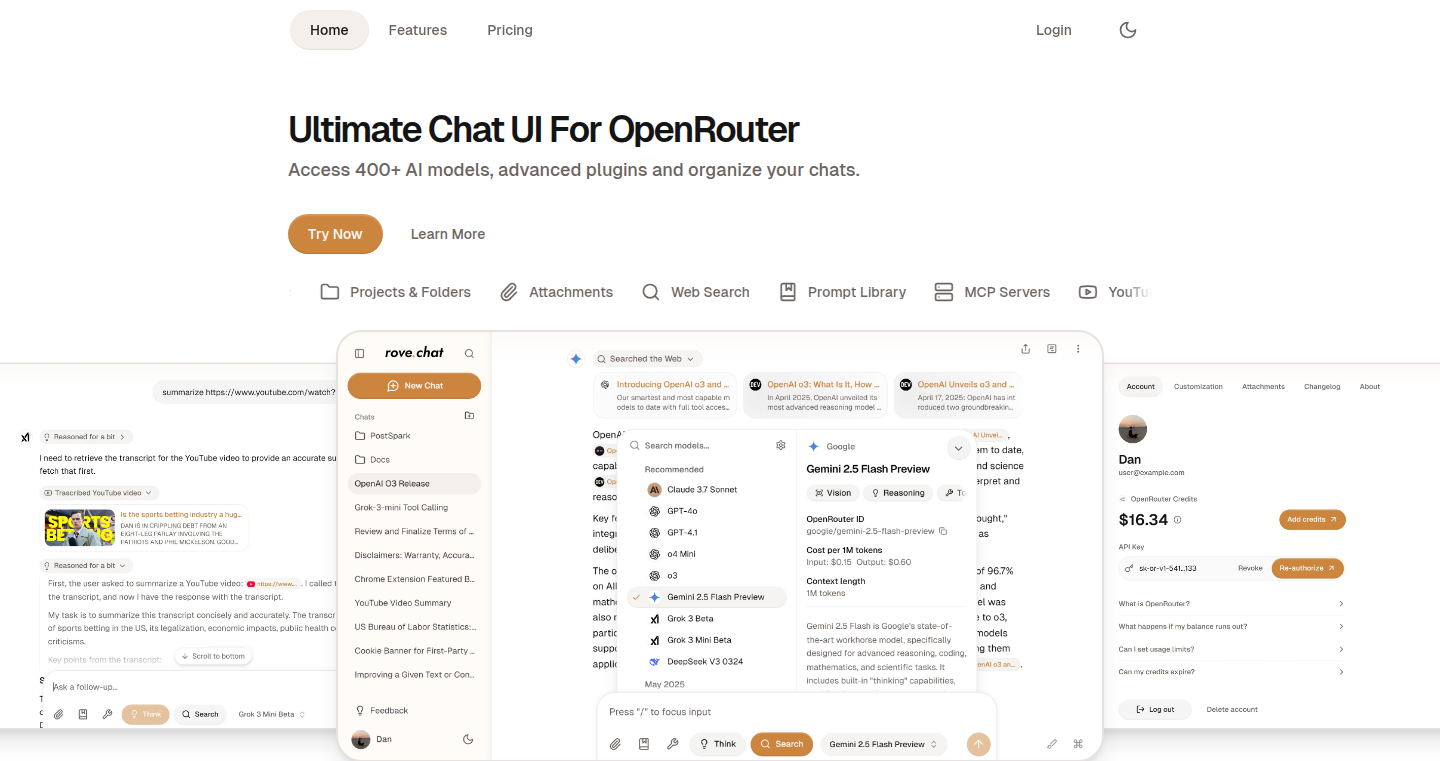
Author
world1dan
Description
Rove is a chat UI designed specifically to work with OpenRouter, offering a streamlined and feature-rich experience for interacting with various AI models. The key innovation lies in its ability to abstract away the complexities of different AI model APIs, providing a unified interface for users. This tackles the problem of having to learn and adapt to different APIs, allowing developers and users to seamlessly switch between models and experiment with AI. So this means you can try out different AI tools more easily.
Popularity
Points 1
Comments 0
What is this product?
Rove acts as a centralized hub for interacting with multiple AI models. It uses a consistent user interface and handles the underlying complexities of communicating with different AI models through OpenRouter's API. It simplifies the process of selecting, configuring, and using various AI models. The innovation is in unifying the AI experience; instead of learning each AI tool's specific quirks, you have one interface for them all. So this means you can use multiple AI tools at once.
How to use it?
Developers can integrate Rove into their applications or use it as a standalone chat UI. You provide your API keys and then choose the AI models you want to experiment with. Rove manages the communication. It's great for rapid prototyping and experimenting with different AI models without rewriting code. For example, use it in a web app by embedding Rove as a component or use it directly to test AI models. So this is really useful for testing new AI products.
Product Core Function
· Unified Chat Interface: Provides a consistent look and feel across all AI models, reducing the learning curve for users. This streamlines the process, so you don't have to keep learning different interface styles. So this is a huge time-saver.
· OpenRouter Integration: Leverages OpenRouter's API to connect with various AI models, simplifying the integration process. It abstracts the complexities of model-specific APIs. So this means it's much easier to switch to new AI tools.
· Model Selection and Configuration: Allows users to easily select, configure, and switch between different AI models. This is key for experimentation. So you can quickly try out different options.
· API Abstraction: Hides the technical details of different AI model APIs, allowing users to focus on interacting with the models. This simplifies your coding requirements. So this makes it simple to build an AI application.
Product Usage Case
· Building a chatbot that leverages multiple AI models for different tasks, such as generating text with one model and summarizing information with another. Using Rove allows you to avoid writing separate code for each model. So you can create more complex AI applications faster.
· Rapidly prototyping different AI-powered features for a web application, allowing developers to quickly test out and compare different AI models. The streamlined interface means quicker testing. So this enables more effective development of AI-powered features.
· Creating an educational tool where users can interact with different AI models to learn about different AI capabilities and styles. Rove simplifies the AI user experience. So users of AI tools can be more productive with the tools.
61
Vizr: Conversational Analytics for Marketing Campaigns

Author
arifliftos
Description
Vizr is a platform that allows you to analyze your marketing data using plain English questions, eliminating the need for building dashboards or writing SQL queries. It connects to your data sources like Google Analytics 4, ad platforms, or Segment, and provides charts, explanations, and actionable insights with just a single click. The core innovation lies in its natural language processing (NLP) capabilities, which interpret user queries and translate them into data analysis. So this helps marketers quickly understand their campaign performance and make data-driven decisions without needing technical expertise.
Popularity
Points 1
Comments 0
What is this product?
Vizr works by leveraging NLP to understand your marketing questions. When you ask a question like "Why did our CPA spike yesterday?", the platform interprets the query, accesses your connected data sources, performs the necessary calculations, and generates a relevant chart and a concise explanation in plain language. It also suggests actions you can take based on the insights, like pausing a campaign. The key innovation is the ability to translate human language into data analysis, which frees users from the complexity of traditional BI tools and empowers them with insights in seconds.
How to use it?
Developers can use Vizr by connecting it to their data sources (GA4, ad platforms, Segment, etc.). Once connected, they can simply ask questions in plain English. The platform will generate charts, explanations, and suggested actions. For example, a developer managing a Facebook ad campaign could ask "Which ads have the lowest cost per conversion?" Vizr would then provide a chart, explanation, and links to edit those ads directly in the platform. This simplifies data analysis and allows developers to focus on strategic decision-making instead of data wrangling.
Product Core Function
· Natural Language Querying: Users can ask questions about their marketing data in plain English, making it accessible to non-technical users. This removes the technical barrier to data analysis. It's valuable because it makes data-driven decision-making accessible to everyone in a marketing team, not just data scientists.
· Automated Data Analysis: The platform automatically analyzes data based on the user's natural language queries, generates relevant charts, and provides concise explanations. This streamlines the data analysis process. This feature saves marketers a significant amount of time and effort by automating data analysis tasks.
· Actionable Insights: Vizr provides not only insights but also suggests actionable steps that users can take based on the data. For example, it might suggest pausing a campaign or reallocating budget. This directly impacts the user's ability to improve campaign performance. The value here is the direct link between data insights and strategic action, making the platform immediately useful for optimizing campaigns.
· Data Source Integration: Vizr integrates with various marketing data sources (GA4, ad platforms, etc.), enabling users to analyze data from different platforms in one place. This creates a centralized view of marketing performance. This provides a unified view of campaign performance, which is critical for holistic marketing management.
Product Usage Case
· A growth team uses Vizr to understand why their customer acquisition cost (CAC) increased last month. They ask "Why did our CAC spike last month?" Vizr analyzes the data, identifies the contributing factors, and suggests actions, like pausing an underperforming campaign. This directly improves the team's ability to manage their marketing budget effectively.
· A marketing analyst uses Vizr to monitor the performance of their retargeting campaigns. They ask "How's our retargeting performing in EMEA?" Vizr provides a chart, an explanation, and allows the analyst to immediately adjust budgets based on the data. This helps the analyst optimize campaign performance and reach the desired audience.
· A product manager uses Vizr to quickly understand which marketing channels drive the most trial users. They ask "Which channel brought the most trial users this week?" Vizr then identifies the best-performing channels, and helps the PM allocate resources more effectively. This helps focus marketing efforts on the most successful strategies.
62
Castream: Mobile Multistreaming Engine
Author
acabralto
Description
Castream is a native mobile app (iOS and Android) that allows users to simultaneously stream live video directly from their phones to multiple platforms like Twitch, YouTube, Facebook, and custom RTMP endpoints. It tackles the limitations of existing mobile streaming solutions by leveraging native encoding and real-time streaming protocol (RTMP), eliminating the need for browser-based workarounds or unreliable third-party apps. This provides a more stable and higher-quality streaming experience directly from your mobile device.
Popularity
Points 1
Comments 0
What is this product?
Castream works by directly encoding video and audio on your phone using the device's hardware, making the process faster and less resource-intensive. It then uses RTMP, a standard streaming protocol, to send the live video to multiple platforms concurrently. The core innovation lies in the native implementation on both iOS and Android, which avoids the performance bottlenecks and compatibility issues common in browser-based streaming solutions. So what does this mean? This offers a seamless, high-quality, and multi-platform streaming experience directly from your phone. For streamers, it means they can reach a wider audience without needing a computer.
How to use it?
Users download the Castream app on their iOS or Android device. They then input their streaming platform account details (Twitch, YouTube, Facebook, etc.) or custom RTMP keys. Once configured, users can start streaming to multiple platforms simultaneously. You can use this if you're a streamer looking to reach more viewers. You just set up your destinations and you're live. You'll also need a phone. Or, if you are a developer you can check the technology to help yourself create a similar technology.
Product Core Function
· Native Mobile Encoding: Utilizes hardware-accelerated video and audio encoding built directly into your phone (iOS and Android). This ensures efficient processing and reduces battery drain, improving the overall streaming quality and performance. So what does this mean? It means you get better video quality without killing your phone's battery.
· Multistreaming Support: Enables simultaneous streaming to multiple platforms, such as Twitch, YouTube, Facebook, and custom RTMP endpoints. This broadens reach and engagement with different audiences. So what does this mean? You can broadcast to multiple platforms at once, easily reaching a wider audience and making your content more accessible.
· RTMP Streaming Protocol: Employs the standard RTMP protocol for reliable and efficient real-time streaming, providing a more stable and consistent experience compared to solutions that use browser-based methods or WebRTC. So what does this mean? It provides a more stable, consistent, and higher-quality stream, less prone to buffering or interruptions.
· Custom RTMP Endpoint Support: Allows users to stream to any platform that supports RTMP, offering flexibility and customization for various streaming scenarios. So what does this mean? It gives you complete control over where your stream goes, allowing you to use it with any streaming service or platform.
· Free and Paid Subscription Models: Offers a free tier with limited features and paid plans with enhanced capabilities like higher resolution, more destinations, and unlimited stream time. So what does this mean? You can try it out for free and upgrade as your streaming needs grow.
Product Usage Case
· Mobile Gaming: A mobile game streamer can use Castream to simultaneously broadcast their gameplay to Twitch and YouTube, maximizing their audience reach and exposure. This can significantly improve their visibility and increase the number of viewers. So what does this mean? More viewers, potentially leading to more subscribers and revenue.
· Live Event Coverage: Journalists or event organizers can use Castream to stream live events to multiple social media platforms, instantly sharing breaking news or event highlights with a broad audience. So what does this mean? Wider reach and faster dissemination of information, leading to more views and engagement.
· Educational Streaming: Educators can use Castream to stream live lessons to multiple platforms, enabling them to teach students on different platforms. So what does this mean? Easier content distribution, making it easier for more people to access educational content.
· Personal Broadcasting: Individuals can use Castream to share their daily activities with friends and family on multiple platforms. So what does this mean? Greater reach for personal streaming.
63
HN Post Summarizer: Auto-generation of Summaries & Key Insights for Hacker News Posts
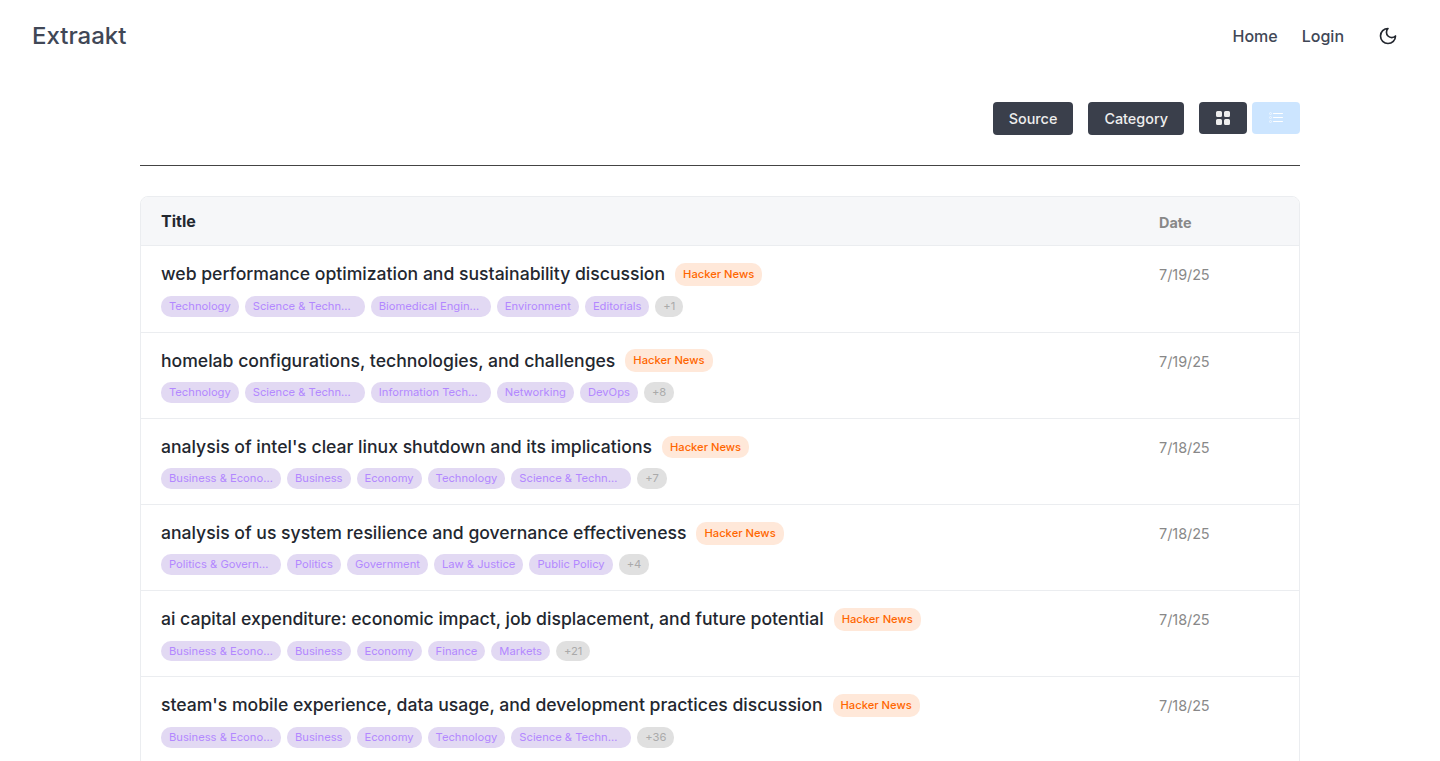
Author
guybedo
Description
This project is a tool that automatically generates summaries, identifies key topics, and extracts bullet points and references from popular Hacker News posts. It leverages natural language processing (NLP) to analyze text, understand the context, and distill the essence of the content. It addresses the common problem of information overload on Hacker News, making it easier for users to quickly grasp the core ideas and discussions without having to read through lengthy comment threads. So this is useful to understand the critical points from a HN post.
Popularity
Points 1
Comments 0
What is this product?
This project uses NLP techniques to analyze the text content of Hacker News posts and their associated comments. It employs algorithms to identify the most important sentences, extract key topics, and generate concise summaries. It also links to the original post's references, making it easy for users to delve deeper into specific aspects of the discussion. The core innovation is automating the process of understanding and extracting useful information from complex text data, specifically targeting the Hacker News environment. So it helps save time by quickly grasping the core ideas.
How to use it?
Developers can utilize this tool by inputting the URL or ID of a Hacker News post. The tool will then automatically generate a summary, list the key topics discussed, and provide bullet points highlighting the most important arguments and ideas. It provides the references mentioned within the post so that they are accessible. Developers could integrate it into their own tools or workflows. For instance, a developer could use this in a browser extension to view post summaries instantly. So it helps developers to quickly understand complex technical topics.
Product Core Function
· Automatic Summary Generation: This feature uses NLP to create a concise summary of the Hacker News post, allowing users to quickly understand the main points discussed. This is valuable for saving time and understanding the scope of the post.
· Topic Extraction: The tool identifies and lists the main topics covered in the post and its comments, helping users understand the key areas of discussion. This is great for quickly understanding the main points of the discussion.
· Bullet Point Extraction: Key arguments and insights are presented in bullet points, making it easy to scan through the most important information. This is useful for quick understanding and quick decision-making.
· Reference Extraction: The tool extracts and lists the references mentioned in the post, providing easy access to the original sources and related content. This adds value by quickly providing all resources.
· Post-Analysis: The tools could be used to create a high-level overview of Hacker News posts, allowing readers to easily understand what content is present within a post without reading the entire discussion.
Product Usage Case
· Developer Blog Integration: A developer could integrate the tool into their blog to summarize Hacker News posts they are referencing, making their blog posts more user-friendly. This allows you to quickly get the essential information.
· Browser Extension for HN: A browser extension could automatically summarize Hacker News posts when users visit them, offering an immediate overview of the content. This helps developers to have a faster, more efficient workflow.
· Technical Documentation: Developers can use the tool to extract key information from technical discussions and integrate it into their documentation, improving clarity and accessibility. This helps in creating better technical documentation and explaining complex concepts clearly.
· Research Tool for Tech Trends: Researchers could use the tool to analyze trends in Hacker News discussions, identifying emerging technologies and popular topics. This aids in identifying new technology trends easily.